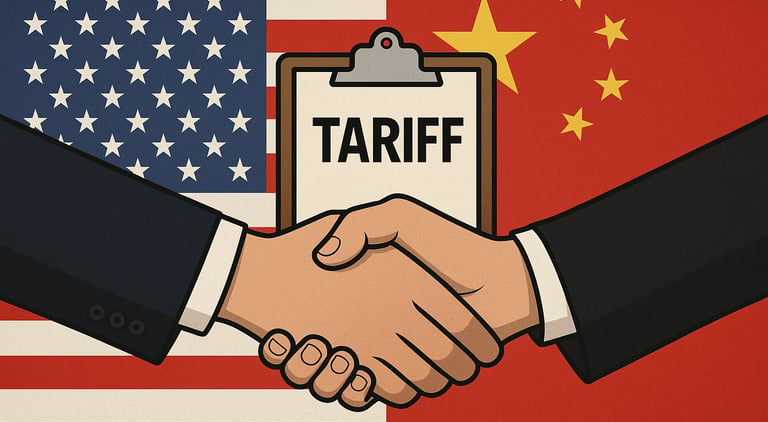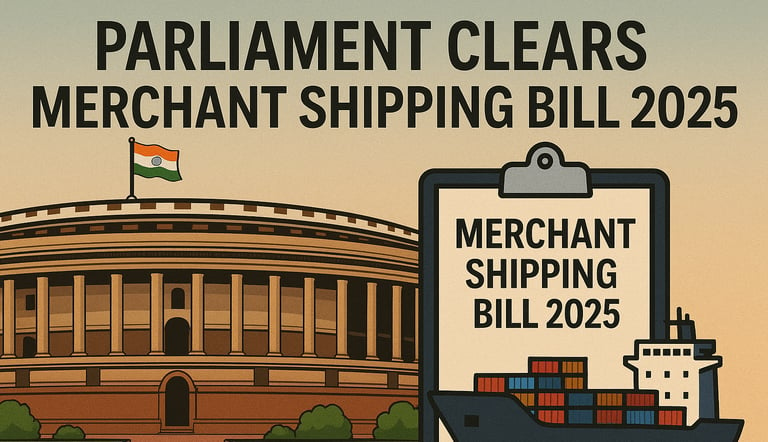
Stay Ahead Shipping
Discover global maritime news, insights, and trends updated weekly for industry professionals and enthusiasts.
Author: Nikita Sainani
Carbon Costs Reshape Global Shipping as $50 Billion Burden Looms

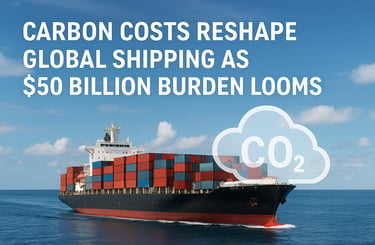
16-10-2025
Carbon pricing is fast transforming from policy to financial reality for the global shipping industry, fundamentally altering cost structures and business strategies across the maritime sector.
According to emissions analytics firm Siglar Carbon, the inclusion of shipping in the EU Emissions Trading System (ETS) alone is set to add over $6 billion in compliance costs in 2025. By the end of the decade, with the expansion of regional and global carbon pricing schemes, the total annual cost could exceed $50 billion — and potentially reach $100 billion by 2030 if additional countries introduce local emission levies.
The projected surge is driven by overlapping measures such as the EU ETS, FuelEU Maritime, UK ETS, and the IMO’s upcoming Greenhouse Gas Fuel Intensity (GFI) regulation, scheduled to take effect in 2028. Early estimates suggest the GFI could impose $22 billion in annual compliance costs at launch, rising to $33 billion by 2030.
Analysts at LSEG Research predict European carbon prices could climb to $150 per tonne of CO₂ by 2030, significantly increasing operational expenses for carriers dependent on fossil fuels. Industry experts warn that if regional and global schemes remain unaligned, shipping could face a fragmented system, intensifying competitive and financial disparities across trade routes.
For shipowners and financiers, carbon costs have evolved from an environmental concern into a central financial metric — shaping charter rates, voyage economics, credit evaluations, and insurance models. As regulatory pressure mounts, emissions are now embedded at the heart of the industry’s commercial decision-making.
Inversion Unveils Arc: A Hypersonic Spacecraft for Global Cargo Delivery
Inversion, a US-based aerospace and defence technology company, has introduced Arc, a hypersonic spacecraft designed to deliver mission-critical cargo anywhere on Earth in under an hour. The vehicle combines rapid delivery capabilities with advanced hypersonic testing functions, potentially revolutionising global logistics and defence operations.
Built to reach remote or infrastructure-limited regions, Arc features a versatile payload bay and can operate autonomously in low-Earth orbit. On demand, it re-enters the atmosphere at hypersonic speeds, manoeuvres through descent, and lands safely under parachutes. According to Justin Fiaschetti, Co-Founder and CEO of Inversion, Arc’s speed and manoeuvrability offer a transportation capability “that has never existed before.” The company plans to build thousands of such spacecraft to form a resilient space-based logistics network supporting national security missions.
Arc also serves as a platform for hypersonic testing, capable of operations above Mach 20 under extreme conditions. Its reusable design enables precise landings, reducing the cost and turnaround time of test missions. The spacecraft has been selected for the US Kratos-led MACH-TB 2.0 Program of Record, underscoring its strategic defence value.
Building on Inversion’s first prototype, Ray, launched in January 2025, Arc integrates in-house developed avionics, propulsion, and thermal protection systems. The company, led by Co-Founders Fiaschetti and Austin Briggs, has completed manufacturing, mission profiling, and drop tests, with Arc’s first flight slated for 2026. Inversion is also collaborating with NASA on next-generation reentry materials for extreme environments.
Backed by Y Combinator, Spark Capital, and Lockheed Martin Ventures, Inversion envisions Arc as the foundation of a future space logistics network, connecting markets and communities at unprecedented speed—ushering in a new era of delivery comparable to the breakthroughs of railroads and aviation.


The United States has warned it may impose sanctions, visa restrictions, and trade measures against countries that support a United Nations plan to curb greenhouse gas emissions from global shipping.
The warning comes ahead of next week’s vote on the International Maritime Organization (IMO)’s Net-Zero Framework, a proposal aimed at cutting carbon dioxide emissions from the shipping industry — which handles about 80% of global trade and contributes nearly 3% of worldwide greenhouse gas emissions.
U.S. officials have rejected the plan, claiming it could raise costs for consumers, energy suppliers, shipping companies, and tourism. Washington described the proposal as posing “significant economic risks” and effectively creating an unauthorised global tax system. Nations supporting the framework could face entry restrictions on ships to U.S. ports and sanctions on officials backing the move.
While the U.S. remains opposed, many container shipping lines view a unified global regulation as critical to accelerating decarbonisation. In contrast, several oil tanker operators have voiced strong concerns over the framework’s potential economic impact.
Supporters of the IMO plan argue that without international alignment, the industry could face a fragmented patchwork of national rules — increasing costs without meaningfully cutting emissions. The upcoming vote is expected to shape the future of global shipping policy, balancing economic interests with urgent climate commitments.
U.S. Opposes IMO Climate Plan, Threatens Sanctions on Supporting Nations

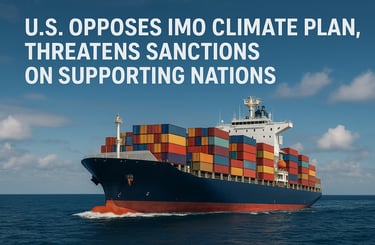
Cochin Shipyard Ltd (CSL) is set to launch India’s first high-capacity dredger, DCI Dredge Godavari, on October 18, marking a major milestone under the ‘Make in India’ initiative.
Built for Dredging Corporation of India Ltd (DCI) at a cost exceeding ₹800 crore, the 12,000-cubic-metre Trailing Suction Hopper Dredger (TSHD) has been developed with technical and design support from IHC Holland B.V., a leading Dutch dredger specialist.
The launch marks the vessel’s first entry into water — a key construction phase to test its stability, buoyancy, and onboard systems. The dredger is expected to be delivered in about six months.
Constructed at Cochin Shipyard’s new dry dock, the vessel follows the internationally recognised ‘Beagle’ platform of IHC Holland and has been customised for Indian operational needs. It is also the first dredger built under CSL’s 2020 MoU with IHC Holland for developing complex, high-capacity dredgers.
DCI, jointly owned by Visakhapatnam, Deendayal, Jawaharlal Nehru, and Paradip ports, is expanding its fleet to meet the rising dredging demands across Indian ports.
Officials noted that dredgers are highly specialised vessels with integrated technical systems and stringent performance standards. Cochin Shipyard’s prior experience in building large Cutter Suction Dredgers (CSDs) and TSHDs has strengthened its capabilities in this niche sector.
The development aligns with the government’s ₹69,725-crore shipbuilding support package under the Atmanirbhar Bharat and Make in India initiatives, aimed at boosting domestic shipbuilding expertise.
Industry experts highlighted that much of the world’s dredger construction expertise remains concentrated in Europe, particularly the Netherlands — making partnerships like that between CSL and IHC Holland crucial for India’s long-term technical advancement.
Cochin Shipyard has identified dredger construction as a key growth area under its Strategy Roadmap 2030, aiming to enhance both revenue and indigenous technical competence through such collaborations.
India’s First High-Capacity Dredger ‘DCI Dredge Godavari’ to Be Launched at Cochin Shipyard
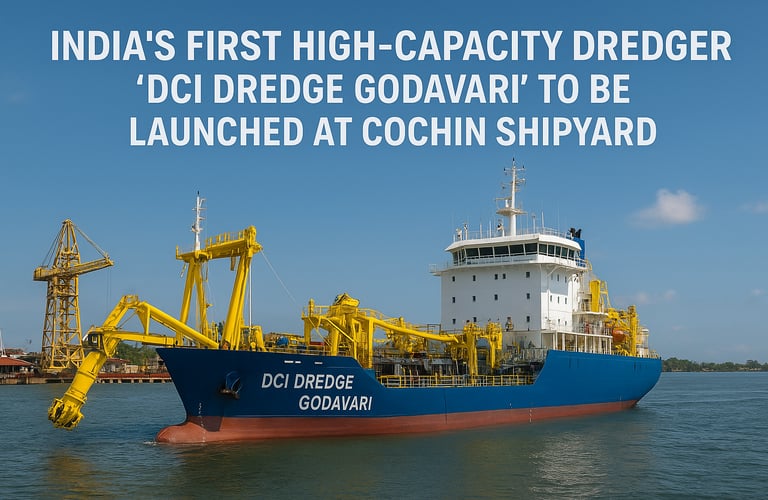

Vizhinjam Port’s ₹15,000-Crore Second Phase to Begin on November 5
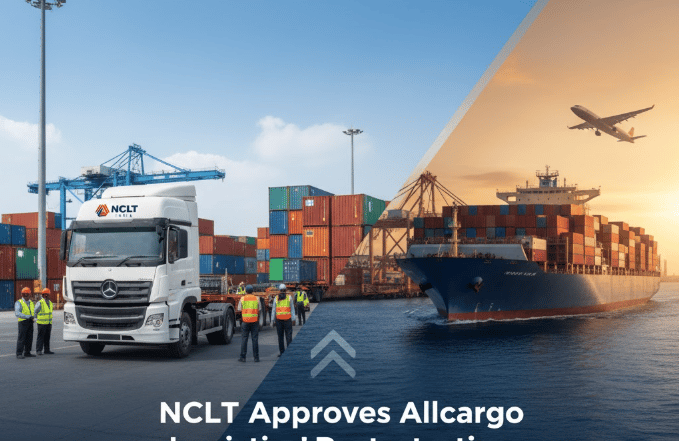

The second phase of the Vizhinjam International Port project in Kerala will commence on November 5, marking a major milestone in India’s maritime infrastructure growth. Chief Minister Pinarayi Vijayan will inaugurate the phase, which will see phases two, three, and four executed simultaneously under an accelerated development plan, with completion targeted for December 2028.
Developed by Adani Ports, the project involves an investment of ₹10,000–15,000 crore, making it the largest public–private partnership (PPP) investment in Kerala’s history. The state government will not contribute financially to this phase. Officials said the expansion will significantly strengthen Kerala’s economy and establish Vizhinjam as a leading transshipment hub in South Asia.
The new phase includes a 1,200-meter container berth with advanced cranes, a one-kilometer approach channel, and a fully developed container yard. It will also feature a 660-meter multipurpose berth, 250-meter liquid berths, expanded liquid cargo storage, and 77 hectares of reclaimed land. Once completed, the port’s annual capacity will rise to 4 million TEUs, making it the largest container-handling port in South India.
Since starting operations on July 11, 2024, Vizhinjam Port has handled 1.15 million containers and received 525 vessels, including some of the world’s largest mother ships. The port serves as a key stop for Mediterranean Shipping Company’s (MSC) European and African routes, leveraging its deep-water capacity and strategic location.
By 2028, the port will also gain dedicated rail connectivity, upgraded road access, and a gateway cargo system, positioning Vizhinjam International Port as a world-class transshipment and logistics hub—a vital link in India’s growing maritime trade network.
NCLT Approves Allcargo Logistics’ Restructuring; Domestic and International Units to Operate as Separate Listed Entities
Allcargo Logistics Limited, India’s largest integrated logistics solutions provider, has received approval from the National Company Law Tribunal (NCLT), Mumbai Bench, for its Composite Scheme of Arrangement under Sections 230–232 of the Companies Act, 2013. The ruling clears the final legal hurdle in the company’s multi-year restructuring plan involving its express distribution, contract logistics, and international supply chain businesses.
Under the approved scheme, the International Supply Chain business of Allcargo Logistics will be demerged into a new listed company, Allcargo Global Limited. Meanwhile, the domestic express and contract logistics divisions—currently operating under Allcargo Gati, Gati Express & Supply Chain, and Allcargo Supply Chain—will be consolidated under Allcargo Logistics Limited, which remains listed.
The restructuring aims to give both domestic and international operations strategic independence, dedicated management focus, and efficient capital allocation, while simplifying the group structure for investors.
As part of the share allocation plan, shareholders of Allcargo Logistics will receive one share of Allcargo Global for every one share held, and shareholders of Allcargo Gati will get 63 shares of Allcargo Logistics for every 10 shares held, post-demerger.
Ravi Jakhar, Group CFO and Director – Strategy, said the move will “empower flagship businesses with strategic independence, create customer synergies, and ensure clear financial accountability,” adding that the focus remains on growth, returns, and a digital-first approach.
Following the NCLT approval, the company will file the sanctioned scheme with the Registrar of Companies and begin implementation steps, including record date determination, share allotment, and listing of Allcargo Global.
Upon completion, Allcargo Group will have four listed entities:
Allcargo Global Limited – International Supply Chain
Allcargo Logistics Limited – Domestic Logistics
Allcargo Terminals Limited – CFS/ICD Operations
TransIndia Real Estate Limited – Real Estate Business
The restructuring marks the culmination of a four-year reorganisation plan, positioning Allcargo for stronger growth and sharper operational focus across its business verticals.
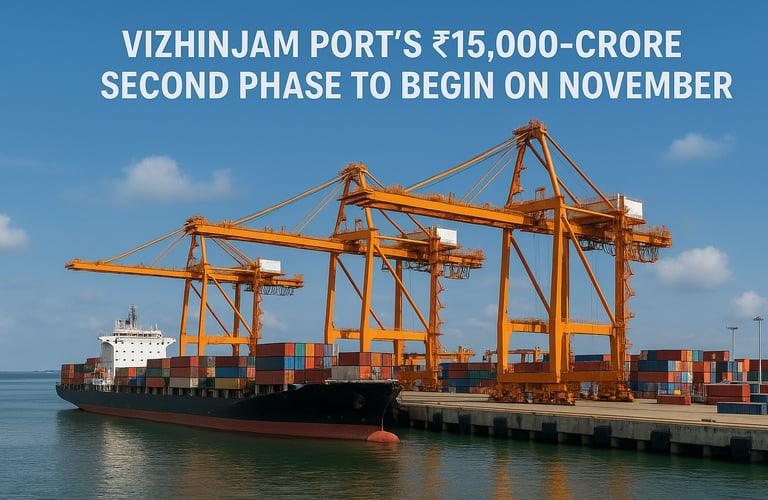

Strikes Cripple Operations at Rotterdam and Antwerp, Europe’s Top Ports
11-10-2025
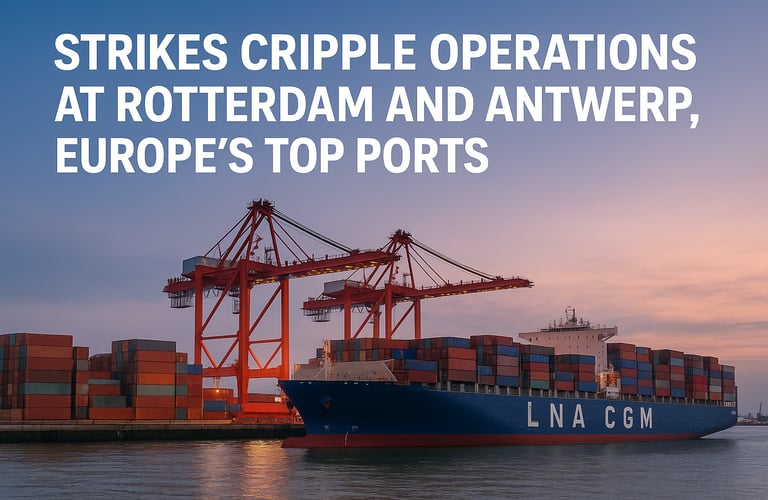

Cargo operations at Europe’s two busiest ports — Rotterdam and Antwerp-Bruges — have come to a near standstill as simultaneous strikes by dockworkers and harbour pilots severely disrupt vessel movements.
At the Port of Rotterdam, lashers from International Lashing Services and Matrans Marine Services began a 48-hour strike on Wednesday afternoon, demanding higher wages. The industrial action, organized by Dutch union FNV, has halted container loading and unloading operations until Friday, delaying vessel turnaround times across major terminals. Several container ships are already facing extended laytime.
In Belgium, harbour pilots at the Port of Antwerp-Bruges have limited their services to office hours in protest against proposed pension reforms, reducing daily vessel handling from the usual 60–80 to just 31 on Tuesday. More than 100 ships were reportedly waiting for clearance by Wednesday morning, forcing carriers to divert traffic to nearby ports.
Negotiations between the Belgian government and the pilots’ union remain deadlocked. The simultaneous disruptions at Rotterdam and Antwerp — vital gateways for European container and energy flows — have raised alarm among shippers and logistics providers.
Industry observers warn that prolonged strikes could ripple across Northern Europe’s supply chains, disrupting sailing schedules, equipment availability, and hinterland connectivity in the days ahead.
IRCON International, Coal India Ink MoU to Strengthen Rail Infrastructure for Coal Logistics


IRCON International Ltd. and Coal India Ltd. have signed a Memorandum of Understanding (MoU) to jointly develop rail infrastructure projects aimed at enhancing coal transportation across India.
The partnership focuses on strengthening logistics connectivity between coal mines and end-users, improving evacuation efficiency and supporting the government’s mission to promote sustainable and efficient freight movement.
IRCON International, a public sector engineering and construction company under the Ministry of Railways, brings extensive expertise in turnkey railway projects and diversified infrastructure segments including roads, metro systems, airports, and electrical substations.
Financially, IRCON reported a consolidated net profit of ₹164.10 crore for Q1 FY26, down 26.75% year-on-year, with revenue from operations at ₹1,786.28 crore, reflecting a 21.89% decline.
Coal India Ltd., the world’s largest coal producer and 63.13% government-owned entity, posted a 20% drop in consolidated net profit to ₹8,734 crore for the same period, with net sales down 4% to ₹31,880 crore.
The MoU represents a strategic collaboration aimed at boosting India’s rail-based coal logistics network, improving supply chain efficiency, and expanding transport infrastructure capacity to meet the nation’s growing energy and industrial demands.
Union Minister for Road Transport and Highways Nitin Gadkari announced that India’s logistics cost is set to fall to single digits by the end of 2026, a move expected to significantly boost export competitiveness and strengthen the country’s position as a global manufacturing hub.
Speaking at an event in New Delhi, where Prime Minister Narendra Modi inaugurated two major National Highway projects worth nearly ₹11,000 crore, Gadkari highlighted that ongoing infrastructure investments are rapidly reducing inefficiencies in the transport network.
“India’s logistics cost currently stands at around 14–16% of GDP, compared to 8% in China and about 12% in Europe and the US. By the end of 2026, we aim to bring it down to single digits. This will be a game changer for exports,” Gadkari said.
The event marked the launch of the Delhi section of the Dwarka Expressway and the Urban Extension Road-II (UER-II) — key infrastructure upgrades designed to decongest the National Capital Region and streamline freight and passenger movement.
The 10.1-km Dwarka Expressway (Delhi section), developed at a cost of ₹5,360 crore, will provide multi-modal connectivity to the Yashobhoomi Convention Centre, Delhi Metro’s Blue and Orange Lines, the upcoming Bijwasan railway station, and the Dwarka Cluster Bus Depot. Prime Minister Modi had inaugurated the 19-km Haryana section in March 2024.
Additionally, the Prime Minister dedicated the Alipur–Dichaon Kalan section of UER-II, along with new link roads to Bahadurgarh and Sonipat, built at a cost of ₹5,580 crore. The project is expected to ease congestion across key traffic nodes like Mukarba Chowk, Dhaula Kuan, and NH-09, while improving connectivity to NCR’s industrial clusters.
“With these corridors, traffic jams in Delhi will reduce by nearly 50%, improving mobility and supporting faster goods movement,” Gadkari said.
Officials noted that these projects are part of the Centre’s larger plan to create an integrated, cost-efficient logistics network, driving export growth and supporting India’s vision of becoming a global manufacturing and logistics hub.
India’s Logistics Cost to Drop to Single Digits by 2026: Nitin Gadkari
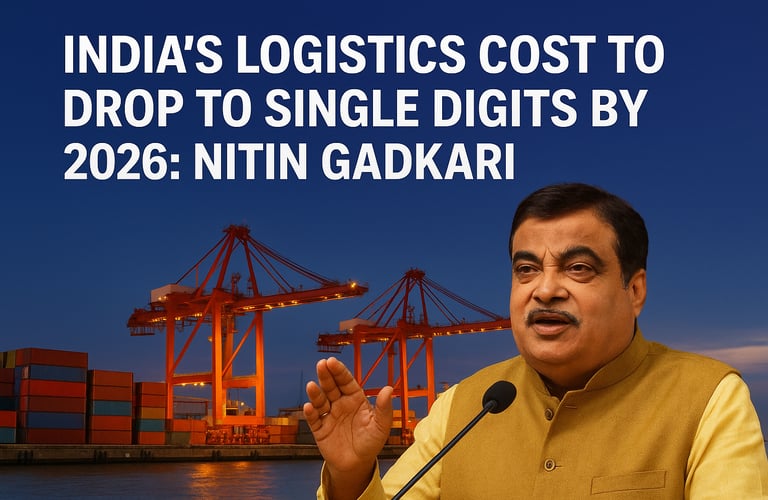

Dr. G. Sambasiva Rao Elected Chairman of ACFI Andhra Pradesh Chapter


Dr. G. Sambasiva Rao has been appointed as the Chairman of the Air Cargo Forum India (ACFI) – Andhra Pradesh Chapter, headquartered in Visakhapatnam. The ACFI’s national office is located at Indira Gandhi International Airport, New Delhi.
Andhra Pradesh, with four international airports—Visakhapatnam, Rajahmundry, Vijayawada, and Tirupati—holds immense potential for expanding air cargo operations across key sectors such as pharmaceuticals, seafood, flowers, industrial spares, and ship components.
Currently, most pharmaceutical exports from the Visakhapatnam SEZ (VSEZ) and APSEZ are routed through Hyderabad, Bengaluru, and Chennai. Developing a strong air cargo network within the state will boost export efficiency, reduce logistics costs, and create new opportunities for MSMEs, startups, and women entrepreneurs.
Dr. Rao emphasized the growing potential for imports of gold, silver, and diamonds, which can spur local economic activity and employment, especially in logistics and allied sectors.
The new ACFI chapter aims to collaborate with the State and Central Governments, the Ministry of Civil Aviation, Airports Authority of India, GMR Group, Customs, and air carriers to build a seamless logistics ecosystem and enhance ease of doing business in Andhra Pradesh.
Additionally, the chapter plans to promote exports of mangoes, fruits, and vegetables from Andhra Pradesh to global markets, enabling farmers to access international buyers and increase their income.
PM Modi inaugurates Navi Mumbai International Airport, India’s new western gateway


10-10-2025
Prime Minister Narendra Modi has inaugurated the Navi Mumbai International Airport (NMIA), a landmark greenfield project designed to transform air connectivity in the Mumbai Metropolitan Region (MMR) and Western India.
Developed under a public–private partnership between Adani Airports Holdings Ltd. (74%) and CIDCO (26%), NMIA aims to decongest Mumbai International Airport while positioning Navi Mumbai as a global aviation and logistics hub.
Located at Ulwe, 37 km from South Mumbai, the airport spans 1,160 hectares and features a lotus-inspired design. The first phase includes a single integrated terminal with capacity for 20 million passengers annually, scalable to 90 million with two Code F-compliant runways.
Terminal 1 offers 66 check-in counters, 22 self-baggage drop points, 29 aerobridges, and automated cargo handling systems. The cargo complex, with 0.5 million MT annual capacity, includes pharma zones, express cargo and drone handling facilities, and secure enclosures for valuables and live animals.
Billed as India’s first 5G-enabled smart airport, NMIA integrates Digi Yatra, IoT-enabled real-time operations, and digital retail services. Passenger facilities include over 110 retail and F&B outlets, premium lounges, a transit hotel, and smart baggage services.
Sustainability features include 47 MW solar power, rainwater harvesting, wastewater recycling, and EV fleet adoption. NMIA is certified by IATA’s CEIV and the US TSA, ensuring compliance with global safety and operational standards.
Strategically located near JNPT (14 km) and Mumbai Port (35 km), the airport strengthens multimodal sea–air connectivity. Officials said the project marks a new milestone in India’s aviation journey, offering world-class infrastructure, seamless logistics, and enhanced regional trade competitiveness.
TVS Industrial & Logistics Parks (TVS ILP) has invested around ₹250 crore to develop a Grade-A industrial and logistics park on 17 acres in Visakhapatnam, expanding its pan-India footprint in the warehousing and logistics sector.
The facility, developed on land allotted by Andhra Pradesh Industrial Infrastructure Corporation (APIIC), is strategically located 21 km from Vizag Airport, 28 km from Vizag Railway Station, and 32 km from Vizag Port, with direct access to the Chennai–Kolkata Highway.
The first phase offers 4 lakh sq. ft. of ready-to-move space, equipped with features such as 12-metre clear height, advanced firefighting systems, wide internal roads, high floor load capacity, solar-powered lighting, and water-efficient fixtures.
Designed as an ESG-compliant and future-ready park, it incorporates rainwater harvesting, renewable energy adoption, and 100% reuse of treated wastewater. Once fully operational, the facility is expected to generate over 1,000 jobs.
Aditi Kumar, Joint Managing Director, TVS ILP, said the park will cater to high-growth sectors including pharmaceuticals, 3PLs, manufacturing, automobiles, electronics, and seafood processing. “Visakhapatnam’s position as a gateway to Southeast Asia makes it a natural logistics hub,” she said.
With upcoming infrastructure upgrades such as the Bogapuram International Airport and enhanced connectivity along the Chennai–Kolkata corridor, Visakhapatnam is poised to become a major economic hub, with TVS ILP well-positioned to support regional growth.
TVS ILP invests ₹250 crore in Grade-A logistics park at Visakhapatnam

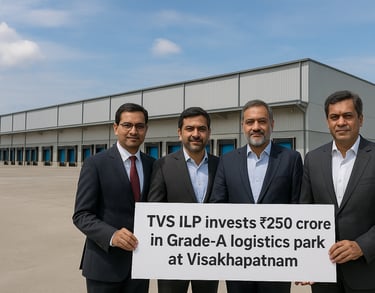
Brundamal Gati Shakti Cargo Terminal Inaugurated to Boost Coal Logistics in Odisha
A new Gati Shakti Multi-Modal Cargo Terminal (GCT) has been inaugurated at Brundamal in Jharsuguda district, Odisha, enhancing coal evacuation from the Talabira coal blocks and the Ib-Sardega mining belt.
Developed under the East Coast Railway zone on railway-owned land, the terminal is the first of its kind in the region. Construction began on July 5, 2023, and was completed within a year, becoming operational for freight movement on September 20, 2024. It has an annual cargo handling capacity of 4.38 million tonnes.
The terminal is directly connected to railway tracks and will handle approximately 80% coal cargo from the Talabira mines, with the remaining 20% from other coalfields in the Ib Valley.
Railway officials said the Brundamal GCT is a key step under the PM Gati Shakti initiative and will significantly improve coal logistics, decongest roads, reduce transport costs, and support Jharsuguda’s industrial growth.
“This is the first multimodal terminal built on railway land with direct connectivity to the rail network,” said a spokesperson from the Sambalpur Division.
The facility is expected to play a major role in strengthening India’s coal logistics corridor and boosting economic activity in the mineral-rich region.
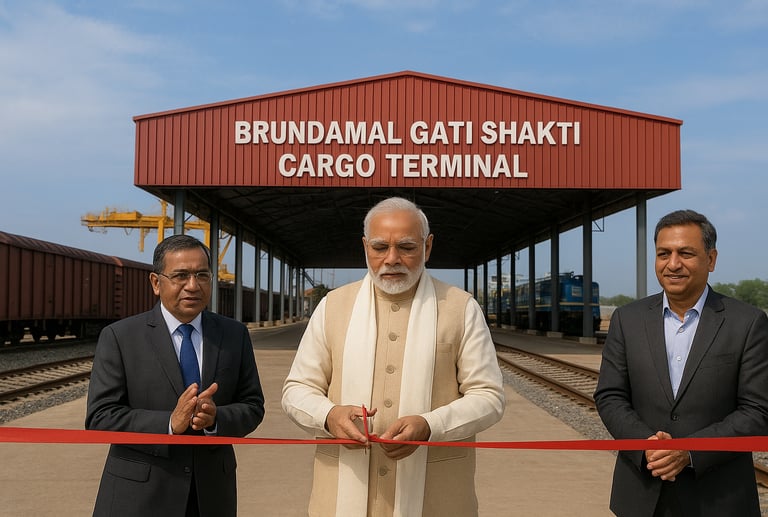

CMA CGM to Impose Emergency Surcharge on Chattogram Shipments from Oct 26


French shipping giant CMA CGM will introduce an Emergency Cost Recovery Surcharge (ECRS) on all import and export shipments via Chattogram Port, effective 26 October 2025. The move comes after the Chittagong Port Authority (CPA) revised its tariffs for the first time in over 40 years, effective 15 October.
In a customer advisory on 7 October, CMA CGM said the surcharge is intended to offset “increased local operational costs” resulting from the tariff changes.
Under the ECRS, dry containers will be charged $45 for 20-foot and $70 for 40-foot units, reefers $40–$90, out-of-gauge cargo $110–$245, and hazardous cargo $140–$305 per container. Charges will be collected locally, based on the vessel’s berthing date.
The CPA has defended its fee hike—covering berth occupancy, container handling, and vessel services—as a step to align with regional hubs like Colombo and Singapore. But exporters and trade bodies, including BGMEA and CCCI, have warned the decision will push up logistics costs, hurting Bangladesh’s export competitiveness amid weak global demand.
Industry experts say CMA CGM’s surcharge could set a precedent for other liners such as Maersk, MSC, and Hapag-Lloyd to follow suit, further increasing shipping costs at a port that handles over 90% of Bangladesh’s trade.
For Bangladesh’s exporters—already hit by declining orders, rising fuel prices, and currency pressures—the added charges may squeeze margins further and complicate trade flows through the country’s busiest maritime hub.
Rolls-Royce to Double Supply Chain Sourcing from India by 2030
British engineering major Rolls-Royce has announced plans to double its supply chain sourcing from India by 2030, as it deepens partnerships and expands local capabilities. The announcement came during CEO Tufan Erginbilgic’s visit to India as part of UK Prime Minister Keir Starmer’s first official delegation after the India-UK Comprehensive Economic and Trade Agreement.
“We have deep ambitions to develop India as a home for Rolls-Royce, building on our strong and successful partnership,” said Erginbilgic. He added that the company’s advanced technologies across air, land, and sea will support India’s vision of Viksit Bharat through local capability-building and strategic collaborations.
Starmer called Rolls-Royce a “symbol of British excellence,” adding that its expansion in India aligns with the UK’s Plan for Change—boosting growth, creating jobs, and strengthening bilateral ties.
Rolls-Royce’s diversified portfolio in civil aviation, defence, and energy is expected to power its long-term growth in India, supporting national goals of defence self-reliance, energy independence, and advanced connectivity infrastructure.
The company recently inaugurated its expanded Global Capability and Innovation Centre in India, which now houses engineering, digital, and enterprise services teams. Positioned to become Rolls-Royce’s largest capability hub worldwide, the centre will support civil aerospace, defence, and power systems businesses, while driving digital and AI-led innovation.
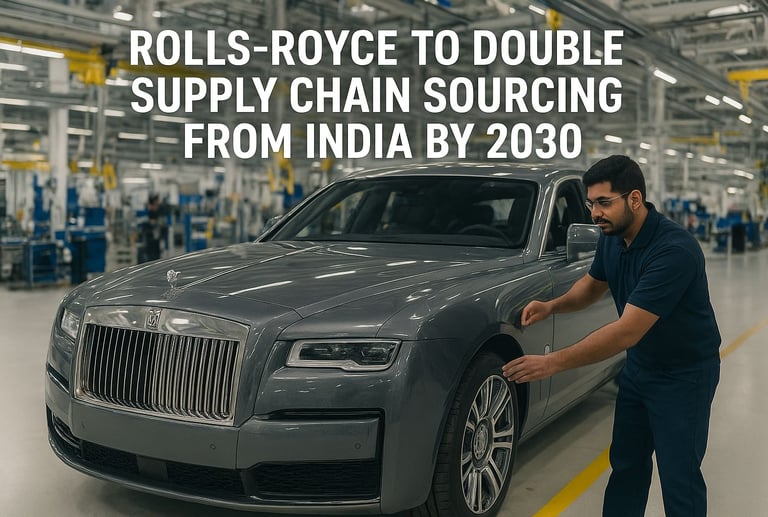

CONCOR, UltraTech Cement sign pact to move bulk cement by rail


09-10-2025
The Container Corporation of India Ltd. (CONCOR) has partnered with UltraTech Cement Ltd., India’s largest cement producer, to transport bulk cement using specialized rail containers, marking the country’s first large-scale shift of cement logistics from road to rail.
As part of the agreement, CONCOR—a Navratna PSU under the Ministry of Railways—will deploy dedicated rakes to move cement across key industrial corridors. The initiative is designed to create a logistics system that is more reliable, energy-efficient, and environmentally sustainable.
The collaboration will integrate UltraTech’s expansive production and distribution network with CONCOR’s multimodal logistics capabilities and the Indian Railways’ national infrastructure. Officials said the model will help reduce road congestion, fuel usage, and carbon emissions, while improving supply chain predictability and lowering costs.
The agreement was signed in New Delhi in the presence of K.C. Jhanwar, Managing Director of UltraTech Cement, and Sanjay Swarup, Chairman and Managing Director of CONCOR.
Industry experts noted that this green logistics model could be replicated in other sectors such as steel, fertilizers, and petroleum, supporting India’s broader goal of decarbonizing freight transport and advancing the objectives of the National Logistics Policy.
Hanwha Ocean completes world’s first LNG ship-to-ship transfer during sea trials
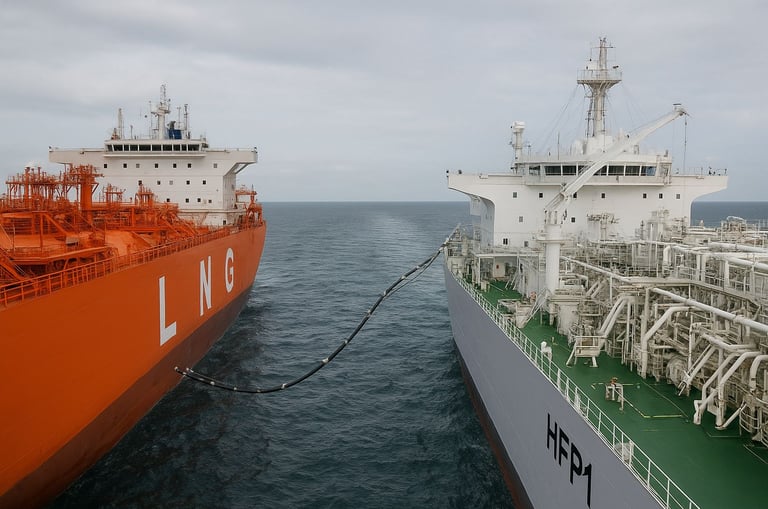

South Korea’s Hanwha Ocean has achieved a major milestone in LNG handling technology by carrying out the world’s first ship-to-ship (STS) transfer of liquefied natural gas during vessel sea trials.
The operation took place off Geoje Island between the newly built Maran Gas Syros and Woodside Jirrubakura, owned by GasLog. Hanwha Ocean confirmed that the transfer of the ultra-cold fuel was executed in a fully controlled manner, safely and without incident, demonstrating the shipyard’s advanced LNG system capabilities.
“This milestone proves that our LNG technology and operational protocols are ready to support the next generation of clean energy shipping,” the company said, describing the achievement as a reflection of its engineering expertise and leadership in cryogenic transfer innovation.
CBIC introduces automated IFSC code registration to streamline Customs operations
The Central Board of Indirect Taxes and Customs (CBIC) has launched a system-based automated approval process for registering Indian Financial System Code (IFSC) details, aimed at simplifying Customs procedures and enhancing trade facilitation.
The IFSC, an 11-character alphanumeric code, identifies bank branches across India for electronic transactions such as NEFT, RTGS, and IMPS.
Under the new mechanism, once an Importer Exporter Code (IEC) and bank account–IFSC combination is approved at one Customs location, the system will automatically validate the same details across all other ports—removing the need for manual intervention by officers.
“This eliminates the requirement for port-level verification and enables instant approval through the system,” CBIC said in a statement.
Implemented through the ICEGATE platform, the initiative is expected to significantly cut processing times, ensuring faster credit of export-related benefits such as duty drawback and rebate claims.
Earlier, exporters had to obtain separate approvals for the same bank account details at every Customs location, often causing delays in receiving incentive payments. The automated framework, CBIC noted, is another step in the digital transformation of Customs administration, designed to boost efficiency, transparency, and ease of doing business.


Kuehne+Nagel opens Bengaluru air logistics gateway to boost global connectivity
08-10-2025
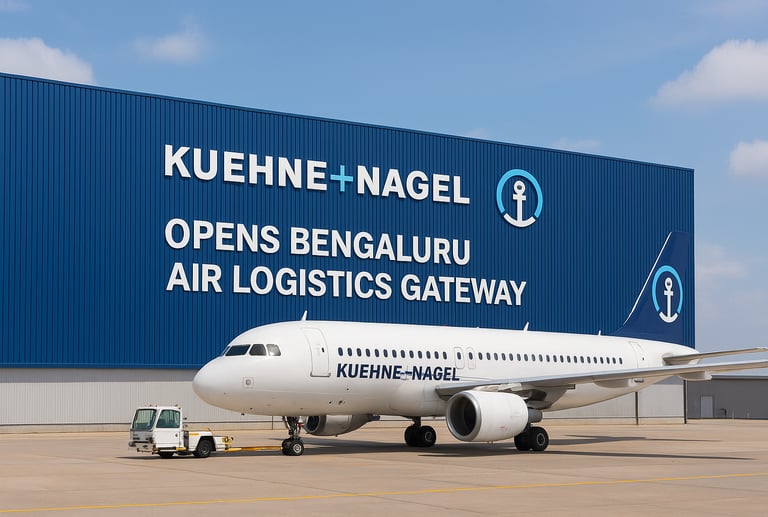

Kuehne+Nagel has inaugurated a new air logistics gateway in Bengaluru, enhancing its global network while catering to shifting market conditions and customer needs.
The facility supports cargo consolidation and deconsolidation, streamlines customs processes, and offers temperature-controlled handling for reliability. Integrated with the company’s digital platforms, including the myKN booking tool, it provides real-time visibility and a seamless customer experience.
Bengaluru was chosen for its strong connectivity to global hubs such as Frankfurt, Hong Kong, Dubai, and Chicago, along with its growing role as a technology and trade centre. The gateway improves load efficiency, cost optimisation, and routing flexibility, while serving customers across sectors like semiconductors, healthcare, automotive, and high-tech.
With direct access to trade lanes across Europe, Asia Pacific, the Middle East, Africa, and North America, the gateway strengthens India’s role in cross-border logistics.
“This development enhances connectivity, efficiency, and resilience for our customers,” said Yngve Ruud, Executive Vice President, Air Logistics, Kuehne+Nagel Group. “Together with our recently opened gateways in Milan, Madrid, and Toronto, Bengaluru strengthens our ability to serve time-critical and high-growth industries, while reinforcing our commitment to India’s fast-developing economy.”
Centre to support ₹26,000-crore shipping cluster at Dugarajapatnam: Sonowal
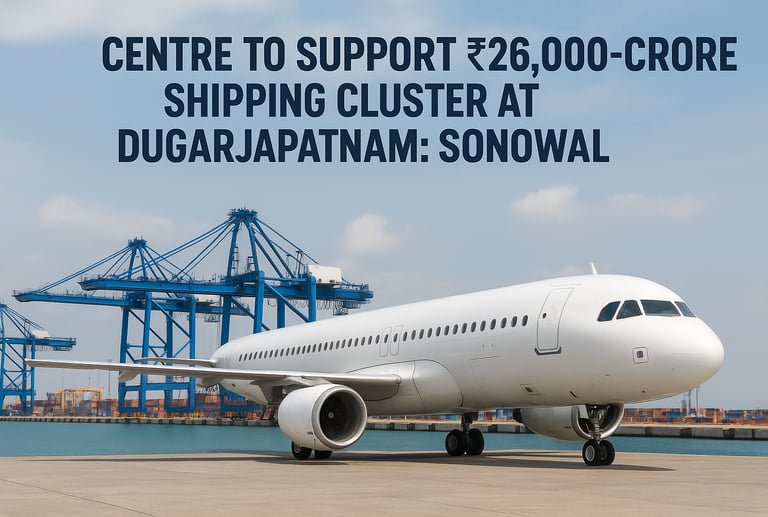

Union Minister for Ports, Shipping and Waterways Sarbananda Sonowal announced that the Centre will extend full support to Andhra Pradesh’s plan to develop a world-class shipping cluster at Dugarajapatnam.
Speaking after flagging off the maiden voyage of SCI’s gas carrier Shivalik at Visakhapatnam Port, Sonowal said the Detailed Project Report (DPR) for the proposed cluster is nearing completion. He noted that discussions with Chief Minister N. Chandrababu Naidu have underlined the Centre’s commitment to boosting the State’s maritime ambitions.
The Andhra Pradesh government plans to develop the cluster on 2,000 acres with an investment of ₹26,000 crore, including a ₹3,000-crore ship-breaking and recycling facility. Backed by feasibility studies from the Visakhapatnam Port Authority, the project is expected to generate 5,000 direct and 30,000 indirect jobs and forms part of the State’s “port every 50 km” vision.
NFR posts 9.63% growth in freight unloading in September
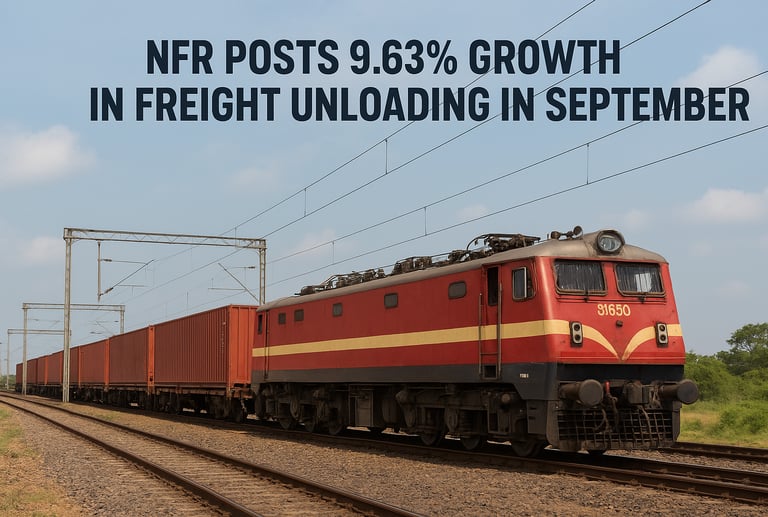

The Northeast Frontier Railway (NFR) recorded a 9.63% year-on-year growth in freight unloading during September 2025, handling 1,059 rakes compared to 966 in the same month last year.
The increase reflects both improved operational efficiency and rising demand for essential commodities across the Northeast. Key consignments included foodgrains, FCI rice, sugar, salt, edible oil, fertilizers, cement, coal, vegetables, automobiles, and petroleum tankers, unloaded at goods sheds across the zone’s network.
Assam accounted for the bulk of the activity with 595 rakes, including 291 carrying essential commodities. Other northeastern states also saw significant volumes: Tripura (83 rakes), Nagaland (21), Manipur (20), Arunachal Pradesh (7), Meghalaya (2), and Mizoram (19). In addition, 179 rakes were unloaded in West Bengal and 133 in Bihar.
NFR, one of the 17 zones of Indian Railways, serves all the northeastern states along with parts of north Bengal and north Bihar. In a recent milestone, Mizoram’s capital Aizawl became the fourth northeastern capital connected by rail—after Guwahati, Agartala, and Itanagar—following the inauguration of the 51.38-km Bairabi–Sairang railway line by Prime Minister Narendra Modi on September 13.
Andhra Pradesh unveils ₹23,000-crore plan to build national logistics hub

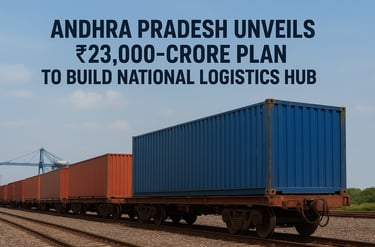
Andhra Pradesh has announced a ₹23,000-crore logistics and infrastructure development plan aimed at positioning the state as one of India’s leading maritime and logistics hubs.
With its 975-km coastline and 15 operational ports, including Visakhapatnam, the state’s blueprint focuses on seamless integration of ports, highways, and industrial corridors to strengthen its role as a gateway for domestic and global trade.
The plan earmarks ₹18,485 crore for port and harbour road connectivity projects and ₹4,500 crore for upgrading state highways and Roads & Buildings (R&B) infrastructure. A new Logistics Infrastructure Corporation will serve as the nodal agency to coordinate planning, financing, and execution.
Key features include 23 strategic road projects spanning 432 km across nine major ports—Visakhapatnam, Kakinada, Krishnapatnam, Gangavaram, Nizampatnam, Mulapeta, Ramayapatnam, Machilipatnam, and the Krishna River terminal—ensuring smoother cargo flow between hinterland industries and export terminals.
The initiative also includes modernization of nearly 15,000 km of state and district roads. These projects range from 1,250 km of NABARD RIDF-funded roads to 1,433 km of state highways, 5,946 km of district roads, 2,104 km of major highways, and 4,233 km of category-C roads.
Officials said the plan addresses long-standing logistics bottlenecks faced by sectors such as pharmaceuticals, food processing, textiles, engineering, and renewable energy. By enhancing multimodal connectivity, Andhra Pradesh aims to reduce logistics costs, improve efficiency, and attract industrial investments.
The state currently has a total road length of 1.6 lakh km, including 8,360 km of national highways and 12,643 km of state highways, though much of it requires capacity upgrades.
Authorities emphasized that the plan is not just an infrastructure upgrade but a strategic realignment to integrate Andhra Pradesh into global supply chains, boost exports, and strengthen trade linkages with Telangana, Odisha, Chhattisgarh, Tamil Nadu, and Karnataka.
DP World Launches Hyderabad’s First Reefer Rail Freight Service to Nhava Sheva
07-10-2025
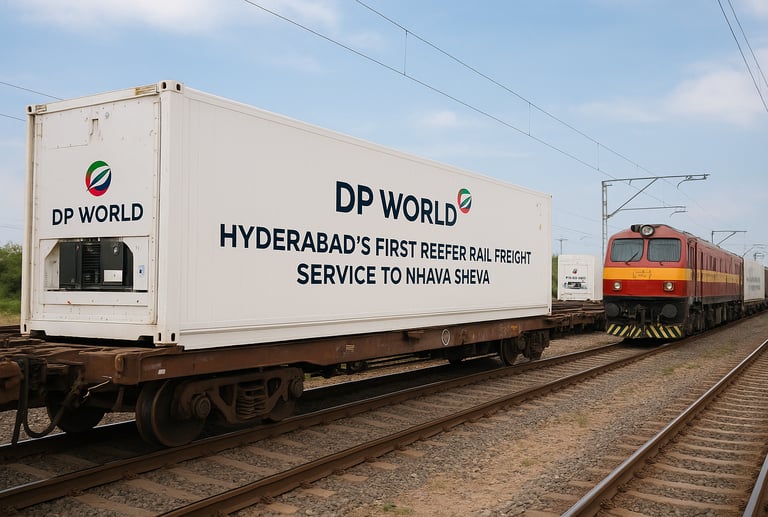

DP World, in partnership with Ocean Network Express (ONE), has introduced Hyderabad’s first dedicated refrigerated (reefer) rail freight service from its Thimmapur ICD to Nhava Sheva (JNPA). The service is designed to support the city’s pharmaceutical exporters, offering an efficient and sustainable alternative to road transport.
The weekly service can carry up to 43 forty-foot containers per train, with four runs a month shifting more than 172 containers from road to rail.
Rail consolidation ensures assured vessel connectivity, unlike road shipments that arrive in smaller, staggered lots.
Each reefer container is powered by DP World’s proprietary powerpacks, with technicians and digital monitoring ensuring temperature stability and cargo security throughout the journey.
The service is expected to cut carbon emissions by up to 70%, equal to removing 43 trucks from the road daily.
Executives from DP World and ONE highlighted the advantages of rail–sea integration, citing reduced delays, sustainability, and secure cold chain management as key benefits.
This launch reinforces DP World’s role as a leading private rail operator in India and supports Telangana’s push for multimodal, sustainable logistics solutions, enhancing India’s position in global pharma trade.
Minister Sonowal Flags Off India-Flagged Gas Carrier Shivalik at Visakhapatnam Port

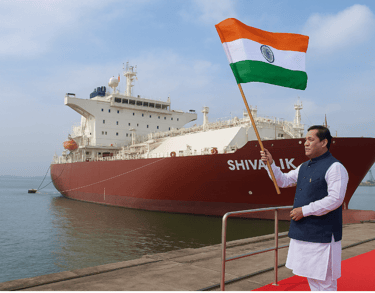
Union Minister for Ports, Shipping and Waterways Sarbananda Sonowal flagged off the gas carrier Shivalik at Visakhapatnam Port, marking its maiden call under the Indian flag.
Recently acquired by the Shipping Corporation of India (SCI), Shivalik is a Very Large Gas Carrier (VLGC), enhancing India’s capacity in LPG logistics and deep-sea cargo movement.
The vessel’s induction strengthens India’s merchant fleet, reducing reliance on foreign-flagged carriers and advancing the government’s Atmanirbhar Bharat vision.
Sonowal also inaugurated key Visakhapatnam Port Authority (VPA) infrastructure projects to boost cargo handling, efficiency, and sustainability, aligned with Maritime India Vision 2030.
The move positions Visakhapatnam as a strategic energy and trade gateway on India’s east coast.
Calling the occasion a “proud moment for Indian shipping,” Sonowal said Shivalik underscores India’s progress toward becoming a global maritime leader.
Concor Plans ₹7,870-Crore Expansion with 500 Rakes, 100 Terminals by 2028
The Container Corporation of India (Concor) has announced an aggressive growth strategy, targeting the addition of 500 rakes and 100 terminals by 2028 to support India’s manufacturing and logistics push.
In FY 2024–25, Concor delivered its strongest-ever results, handling 5.09 million TEUs (+7.94% YoY), with EXIM volumes up 6.78% and domestic cargo up 11.9%. Revenue hit ₹9,329 crore, while net profit reached a record ₹1,272 crore.
Investments in FY25 totaled ₹810 crore for terminal upgrades, wagons, containers, and IT systems, alongside ₹76.7 crore for R&D, including indigenous container manufacturing and wagon upgrades.
India’s containerized rail volumes grew 4.34% to 88.7 million tonnes, while ports handled 23.3 million TEUs, up 10.6%.
Concor, currently operating 66 terminals, 17,485 wagons, and 53,000+ containers, is expanding into freight forwarding, customs clearance, shipping, parcel services, air freight, auto logistics, and short-sea shipping.
Global plans include participation in the INSTC and India–Middle East–Europe Economic Corridor (IMEEC), with a focus on building net-zero warehouses and multimodal hubs under PM Gati Shakti.
CMD Sanjay Swarup said logistics will be the “backbone of India’s transformation into the world’s third-largest economy,” as Concor moves toward integrated, end-to-end First Mile–Last Mile (FMLM) logistics.


Ocean Freight Rates Plunge to Multi-Month Lows, Carrier Profits Under Pressure
06-10-2025


Global ocean freight rates have fallen to their lowest levels in nearly 20 months, triggering concern among analysts about profitability in the container shipping sector.
According to the Drewry World Container Index, average spot rates now stand at US$1,669 per 40-foot container, well below the breakeven level for major carriers such as Maersk and Hapag-Lloyd.
Rates on key trade lanes, including Shanghai–Los Angeles, have dropped by more than 50% year-on-year. The decline has been attributed to weak global demand, growing fleet capacity, and ongoing trade policy uncertainty.
Carriers are now cutting sailings and idling vessels in an effort to stabilize the market. Analysts warn that continued overcapacity and sluggish demand could lead to consolidation and renewed rate wars across major routes.
LNG Demand in Shipping Set to Double by 2030 Amid Green Transition

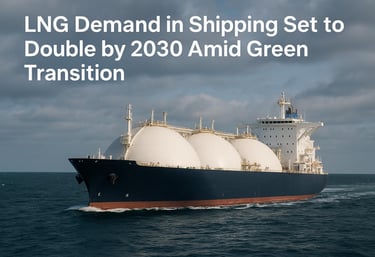
Liquefied Natural Gas (LNG) is rapidly emerging as the preferred transitional marine fuel as the global shipping industry accelerates its decarbonization efforts.
A recent Reuters analysis projects that LNG demand in shipping will at least double by 2030, driven by expanding bunkering infrastructure and new dual-fuel vessel deliveries.
Currently, around 780 LNG-capable ships are in operation worldwide, a number expected to surpass 1,400 by the end of the decade.
Regulatory measures such as the IMO decarbonization targets and the EU’s FuelEU Maritime regulation are major catalysts for this transition. However, analysts caution that LNG remains a bridge fuel, with long-term competition expected from emerging options like ammonia and green methanol.
Shipping Industry Deploys AI to Combat Surge in Cargo Fires
In response to a rise in shipboard fire incidents linked to misdeclared hazardous cargo, the global shipping industry has turned to artificial intelligence for safety screening.
A new AI-powered cargo inspection system, launched under the World Shipping Council’s Cargo Safety Program, scans millions of container bookings in real time to identify undeclared or misclassified dangerous goods.
The system, developed with the National Cargo Bureau, uses advanced pattern recognition to flag suspicious shipments before loading. Over 70% of the world’s container capacity is now participating in the initiative.
Industry experts say lithium-ion batteries and concealed chemicals have been primary causes of recent cargo fires. The AI initiative is expected to improve early detection, reduce insurance claims, and enhance operational safety across the maritime supply chain.
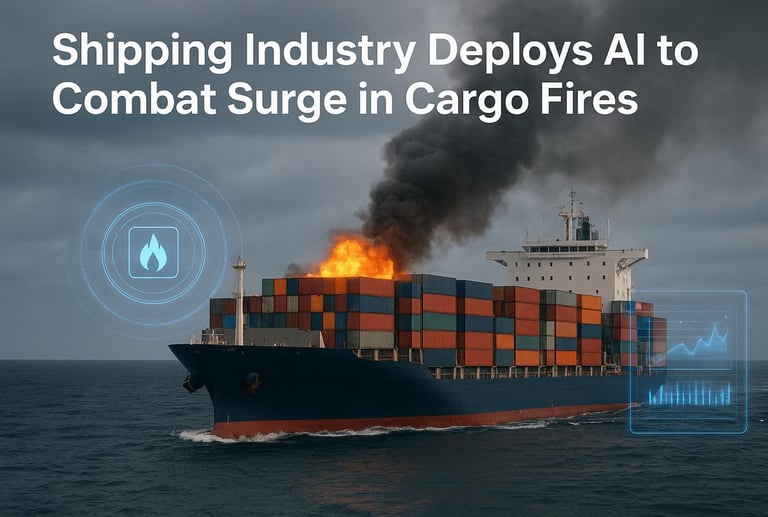

India to Flag Off Gas Carrier “Shivalik” at Visakhapatnam Port
VISAKHAPATNAM — Union Minister for Ports, Shipping & Waterways, Sarbananda Sonowal, is scheduled to formally flag off the Very Large Gas Carrier (VLGC) Shivalik at Visakhapatnam Port today. The vessel, recently acquired and registered under the Indian flag by the Shipping Corporation of India (SCI) on September 10, will make its maiden Indian call to unload an LPG cargo.
The induction of Shivalik marks a strategic step in strengthening India’s maritime energy logistics capacities under the government’s broader “Atmanirbhar Bharat” initiative. Minister Sonowal’s presence underscores the administration’s push toward enhancing domestic shipping capabilities and port infrastructure.
While in Visakhapatnam, Sonowal will also inaugurate several developmental projects by the Port Authority and attend a public meeting linked to the Sagarmala program, reinforcing efforts to upgrade port operations, improve efficiency, and boost maritime connectivity along India’s east coast.

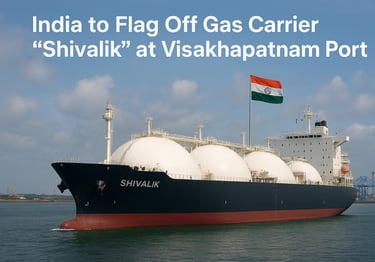
Transpacific Container Rates Fall to Pre–Red Sea Crisis Levels
01-10-2025


Transpacific shipping rates have dropped sharply, returning to levels last seen before the Red Sea crisis. Industry data shows that weak demand, particularly during China’s Golden Week, combined with excess vessel capacity, has pushed rates downward. While this offers short-term relief for shippers, carriers are under growing pressure to cut costs. Analysts warn that if demand does not rebound, shipping lines may reduce sailings or idle vessels to stabilize prices in the coming weeks.
Global Supply Chains Brace for Peak-Season Strain


As the peak shipping season approaches, global supply chains are facing new challenges from tariff changes, geopolitical conflicts, and shifting trade routes. The Asia-Pacific region, particularly China and India, is preparing for congestion as exporters frontload shipments to avoid additional tariffs. Logistics providers are exploring alternative trade corridors and digital tracking solutions to maintain efficiency. Businesses are advised to plan shipments earlier than usual to mitigate risks of congestion and rising peak-season surcharges.
UN Trade Agency Warns of Shipping Market Volatility
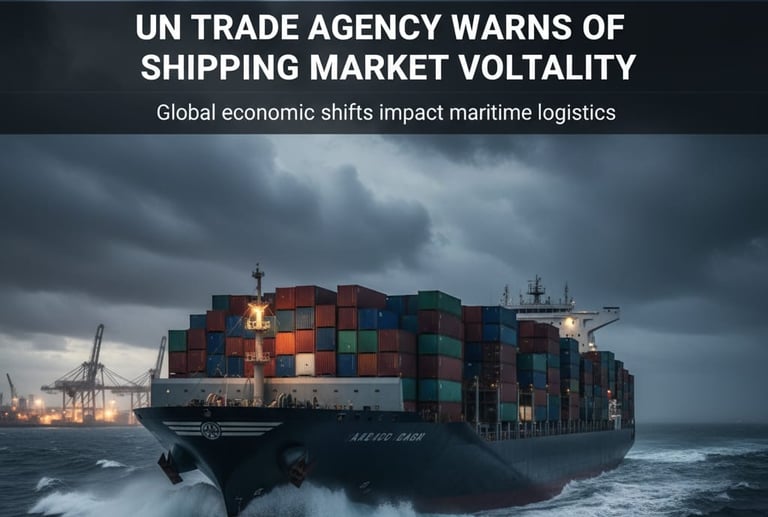

The United Nations Conference on Trade and Development (UNCTAD) has cautioned that the global shipping industry is entering a phase of heightened volatility. The warning comes amid escalating tariffs and geopolitical conflicts affecting key maritime trade routes. From October 14, the United States will impose new port fees on Chinese vessels and shipbuilders, sparking strong objections from Beijing. Industry experts say the move could lead to higher operating costs, increased insurance premiums, and disruptions in traditional trade flows.
India Launches Logistics Data Bank 2.0
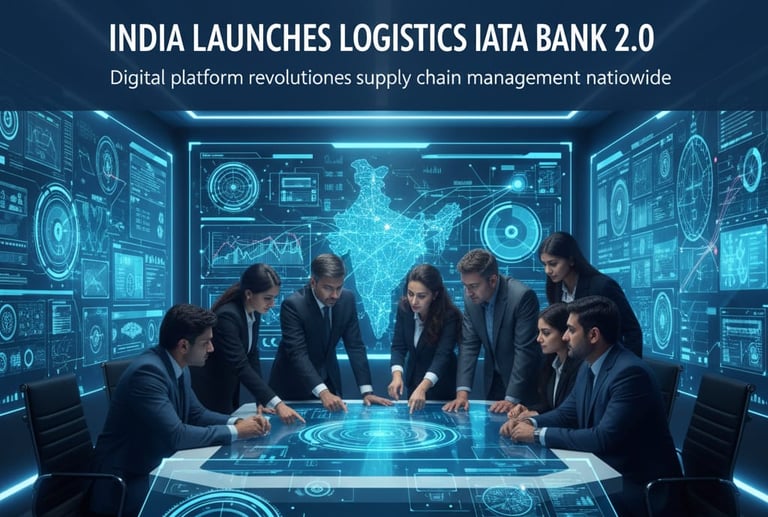

India has rolled out Logistics Data Bank 2.0, a new digital platform designed to track containers and trucks in real time. The system uses GPS and IoT technologies to provide end-to-end supply chain visibility. Developed in collaboration with Container Corporation of India (CONCOR) and logistics partners, the initiative is expected to cut logistics costs, reduce delays, and improve trade efficiency. The launch comes as India positions itself as a growing global manufacturing hub, where streamlined logistics will play a crucial role in export competitiveness.
U.S. holiday package deliveries to rise ~5%
30-09-2025
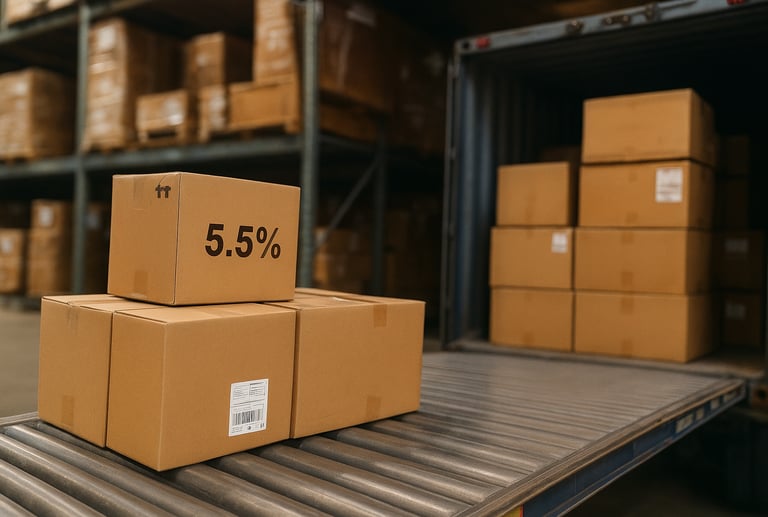

• According to a forecast from ShipMatrix, U.S. delivery companies are expected to handle 2.3 billion packages during the 2025 holiday season — about 5% more than in 2024. 
• The boost is partly attributed to there being an extra shopping day in the holiday window (between Thanksgiving and Christmas) which helps offset some of the drag from tariffs. 
• However, the gains won’t be uniform across all carriers:
• Amazon’s logistics arm and FedEx saw parcel volumes up ~6.1% and 5% respectively in the first half of 2025. 
• UPS and USPS, in contrast, saw volume declines of ~5.4% and ~6.7% respectively. 
• Some of the slack from UPS/USPS is said to be taken up by private delivery networks (e.g. Walmart’s network) or alternative carriers. 
• With this volume increase, there’s also concern of backlash over “peak surcharges” (special fees during seasonal high load periods) as delivery costs rise. 
Implications / What to watch
• Carriers will need efficient operations to absorb the volume increase without excessive cost overruns.
• If consumer demand slows (due to inflation, tariffs, etc.), the projected volume growth could be at risk.
• How different carriers fare may influence competitive dynamics—Amazon and FedEx might capture share at the expense of UPS / USPS.
China oil port’s plan to ban “shadow fleet” tankers & aging vessels


• Terminal operators at Huangdao Port (in Shandong province, east China) are planning new rules effective 1 November 2025 to bar shadow fleet vessels and restrict old tankers. 
• Shadow fleet vessels are ships operating under hidden or deceptive practices (e.g. fake International Maritime Organization (IMO) numbers, turned-off transponders, shell companies) to evade scrutiny, often used for transporting oil under sanctions. 
• Under the new rules:
• Any vessel older than 31 years will be barred. 
• Ships using fake IMO numbers will be banned from calling the port. 
• Vessels with invalid or expired certifications, or with a record of pollution/accidents in the past 3 years, will also be disqualified. 
• The operators will institute a risk-rating system, scoring vessels on a 0–100 scale; those scoring below 55 will be classified “high risk” and denied entry. Factors include vessel age, classification society reputation, pollution liability insurance, and past safety record. 
• The move is widely viewed as a response to U.S. pressure / sanctions efforts, especially around Iranian oil flows via Qingdao / Dongjiakou in China. 
• Note: Huangdao handles less high-risk crude traffic compared to some larger Chinese ports, so the immediate operational impact may be limited. 
Implications / What to watch
• This could tighten scrutiny over vessels supplying oil to China, especially those linked to sanctioned regimes.
• Shadow fleet operators may shift routes or ports to evade restrictions, necessitating monitoring of alternate ports in China.
• The new risk rating system may become a model for other ports globally, especially where sanction compliance is critical.
• Shipping companies may accelerate renewal or reflagging of aging vessels to meet compliance.
$1.4 billion China–Zambia–Tanzania railway deal (TAZARA)


• On September 29, 2025, China, Zambia and Tanzania signed a $1.4 billion agreement to refurbish the Tanzania–Zambia Railway (TAZARA), a crucial corridor linking Zambia’s copper belt to the Indian Ocean via Dar es Salaam. 
• Under the agreement, funds will be allocated for the rehabilitation of tracks and the purchase of rolling stock (locomotives, wagons, etc.). 
• Prior to this formal deal, China had proposed in earlier agreements to upgrade TAZARA; this latest deal appears to be the operationalization of that intention. 
• The route is strategically important because it provides Zambia a route to sea that bypasses bottlenecks in South Africa (and reduces dependence on other corridors). 
• The TAZARA line is 1,860 km long. 
Implications / What to watch
• If fully rehabilitated, TAZARA could significantly lower logistics costs for copper and other bulk exports from Zambia & neighboring regions.
• The upgrade may also increase capacity and reliability, reducing reliance on trucking (which is slower, more expensive, and vulnerable to border delays).
• There’s geopolitical competition: the U.S. and other western actors have been backing alternative corridors (e.g. the Lobito Corridor via Angola) as counterweights to Chinese-backed infrastructure. 
• The performance of this rail line will be a test of China’s infrastructure strategy in Africa—balancing commercial returns, political influence, and local development.
Chinese Shipyards Still Getting Strong Orders Despite U.S. Port Fees

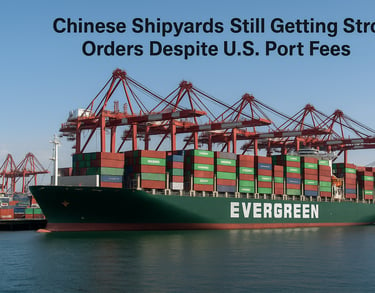
27-09-2025
Even though the United States has announced new port entry fees on vessels linked to China starting from mid-October, global shipping companies continue to place large orders with Chinese shipyards. Reports show that in the first eight months of 2025, Chinese shipyards captured around 53% of global ship orders by tonnage. This is significant because it highlights China’s continued dominance in shipbuilding, despite political and trade tensions with the U.S. Some shipping companies are now exploring rerouting Chinese-built ships to avoid high fees at American ports. This move reflects how global trade policies are influencing ship deployment strategies, but at the same time, it shows the world’s reliance on Chinese shipyards for vessel construction.
UN Warns of Major Volatility in Shipping Due to Tariffs & Conflicts
The United Nations Conference on Trade and Development (UNCTAD) has issued a warning that global shipping is facing unprecedented volatility. The reasons are twofold:
Geopolitical conflicts in the Middle East and Ukraine, which force vessels to take longer routes (avoiding Suez Canal, Red Sea, or Strait of Hormuz).
Tariff wars and new trade restrictions between major economies (like U.S.–China and others).
As a result, UNCTAD has cut its forecast for maritime trade growth in 2025. Overall trade is expected to grow only 0.5%, while containerized trade may grow around 1.4%, far below earlier expectations. This shows that shipping companies must deal with longer transit times, higher fuel costs, and uncertain demand patterns.
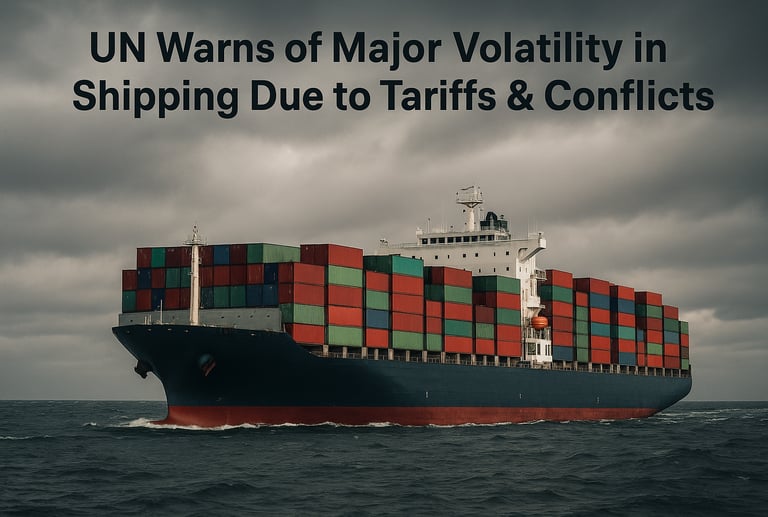

CMA CGM Acquires UK’s Freightliner Rail Logistics
French shipping giant CMA CGM has announced the acquisition of Freightliner, a leading UK intermodal rail logistics company. This deal is part of CMA CGM’s strategy to expand beyond traditional sea shipping into integrated logistics services. By combining rail + maritime transport, CMA CGM will be able to offer door-to-door supply chain solutions, reduce carbon footprint (as rail is cleaner than trucks), and capture a bigger share of inland freight markets in Europe. The move also positions CMA CGM to compete with other giants like Maersk and MSC, who are also building strong inland logistics networks.


Middle East & Africa (MEA) LCL Shipping Market Expands
The Less-Than-Container Load (LCL) shipping segment in the Middle East & Africa is experiencing rapid growth. LCL shipping means customers can book only part of a container, instead of paying for a full one, which is especially useful for small and medium enterprises (SMEs) and e-commerce sellers. With cross-border e-commerce booming, more businesses are relying on LCL shipments to send smaller, frequent loads across regions. This is changing trade flows in MEA by increasing demand for flexible, affordable shipping solutions. Logistics companies are now investing more in LCL consolidation hubs and digital booking systems to capture this fast-growing market.
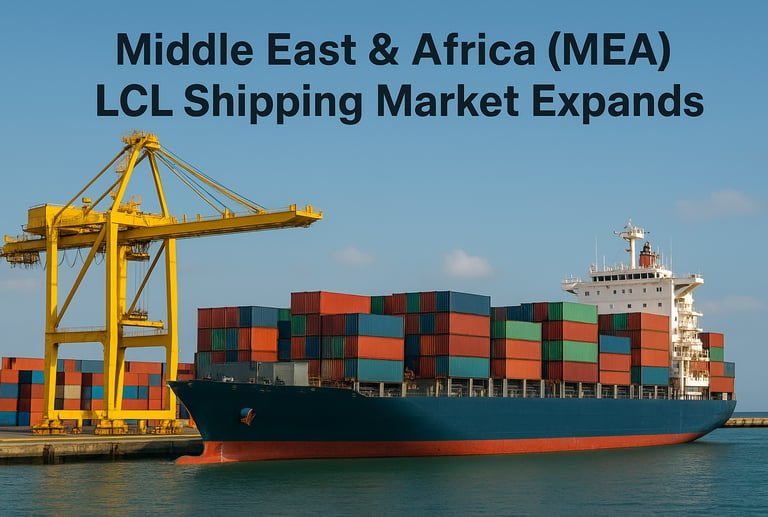

India–US Air Cargo Drops 14% After Tariff Hike
21-09-2025

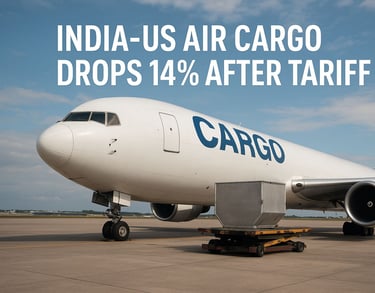
Air cargo volumes from India to the US fell 14% during Sept 1–7, the first clear impact of Washington’s decision to double import tariffs on Indian goods from 25% to 50% effective August 27, according to WorldACD Market Data.
The decline followed a 28% surge in shipments (Aug 18–23) as exporters rushed cargo before the deadline. While India–US trade had been gaining traction with US buyers diversifying from China, the tariff hike has slowed momentum.
By contrast, India–Europe volumes rose 8% YoY, and Sri Lanka–US tonnages climbed 13% over last year.
Spot freight rates on the India–US lane also fell below $4/kg ($3.99), down 22% year-on-year. The tariff issue is expected to be a key agenda item when India–US trade talks resume in New Delhi on Sept 16, led by US Assistant Trade Representative Brendan Lynch.
Adani Gangavaram Port Sets Record with 48,271 MT Cargo Dispatch


Adani Gangavaram Port Ltd (AGPL) achieved a new operational milestone by dispatching 48,271 MT of cargo in 24 hours to Rashtriya Ispat Nigam Ltd (RINL) — the highest single-day volume in its history.
The record was accomplished through a mix of road, rake, and conveyor facilities. AGPL management said the achievement underscores its focus on efficiency, customer service, and innovation.
Celebrations included a traditional puja, symbolizing AGPL’s commitment to blending heritage with modern practices while advancing its vision as a sustainable maritime gateway on India’s east coast
Cochin Port, Vallarpadam Terminal to Expand as Kerala Fuels Maritime Growth
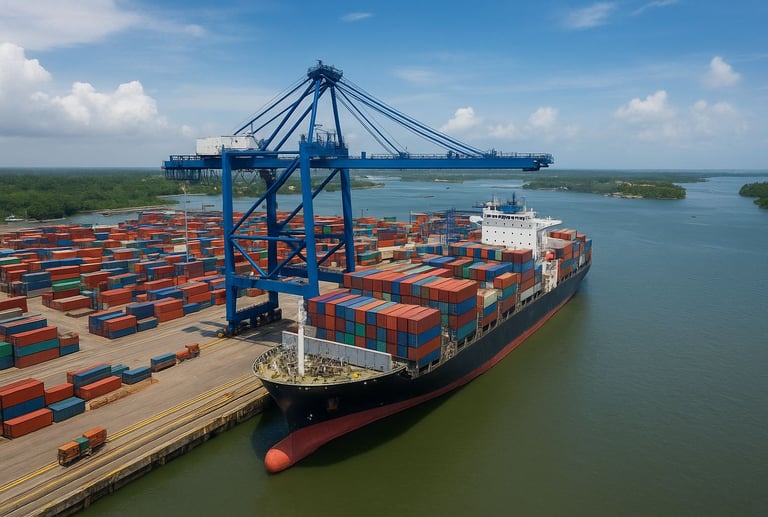

Union Ports Minister Sarbananda Sonowal announced expansion plans for Cochin Port and the Vallarpadam transhipment terminal, strengthening Kerala’s role in India’s maritime ambitions under Vision 2047.
As part of Sagarmala, Kerala is implementing 54 projects worth ₹24,000 crore, of which 20 are complete. The Vizhinjam International Seaport, India’s first fully automated transhipment hub, has already handled 10.6 lakh TEUs and 500 ships since 2024.
Kerala’s maritime ecosystem is further supported by Cochin Shipyard’s global shipbuilding and repair expansion and the Kochi Water Metro, Asia’s largest integrated water transport system with 78 electric-hybrid vessels.
Tourism and logistics are also benefiting from National Waterway 3 and Kochi’s cruise terminal, which has hosted 105 ships and 1.4 lakh passengers in three years.
Nationally, the Maritime Amrit Kaal Vision 2047 targets ₹80 lakh crore investments, 1.5 crore jobs, and a strong push for green shipping, with 840 Sagarmala projects worth ₹5.8 lakh crore by 2035. India’s ports have already cut turnaround times to 0.9 days, ahead of global benchmarks, with nine ports ranked among the world’s top 100.
PM Modi to Unveil ₹7,870-Crore Maritime Projects in Gujarat
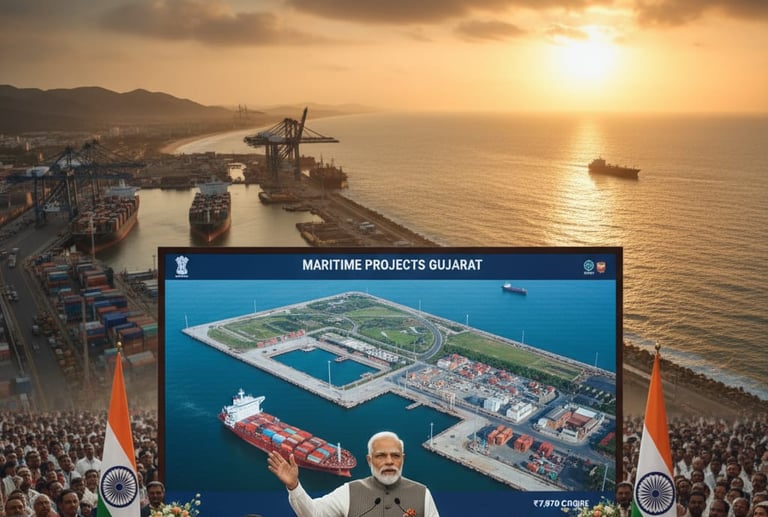

Prime Minister Narendra Modi will inaugurate and lay the foundation stone for shipping and shipbuilding projects worth over ₹7,870 crore in Bhavnagar, Gujarat, providing a major boost to India’s maritime infrastructure.
According to the Ministry of Ports, Shipping and Waterways, the initiatives include:
Inauguration of the Mumbai International Cruise Terminal at Indira Dock.
Foundation stone for Tuna Tekra Multi-Cargo Terminal.
New container terminal at Syama Prasad Mookerjee Port (Kolkata).
Container berth and cargo handling facilities at Paradip Port.
Modern firefighting systems and road connectivity at Kamarajar Port (Ennore).
Additional projects cover coastal protection works at Chennai and Car Nicobar, a multi-purpose berth and Green Bio-Methanol plant at Deendayal Port (Kandla), and ship repair facilities at Patna and Varanasi.
The government said these initiatives will strengthen shipping capacity, enhance connectivity, and promote sustainable maritime development.
ONE Launches Dedicated Reefer Train for Pharma Cargo from Hyderabad to Nhava Sheva
20-09-2025


Ocean Network Express (ONE) has introduced a weekly dedicated reefer train service from ICD Timmapur, Hyderabad, to Nhava Sheva, aimed at strengthening logistics for India’s pharmaceutical exporters. The service departs every Wednesday at 10:00 AM and arrives in Navi Mumbai on Saturday at 10:00 AM.
The new service reduces transit time for temperature-sensitive pharma cargo and ensures seamless connectivity with mainline vessels at Nhava Sheva, enabling faster global market access.
A key advantage is the ready availability of empty reefer containers at ICD Timmapur, eliminating delays for shippers. ONE has also deployed Remote Monitoring (RF) technology to provide:
Real-time visibility of cargo conditions
Precise temperature and atmosphere control
Continuous monitoring of humidity levels for maximum safety
“Hyderabad is India’s leading pharma hub, and this service will deliver faster, safer, and more efficient logistics for exporters,” a ONE spokesperson said.
With this launch, ONE reinforces its focus on strengthening cold chain logistics in India while offering sustainable, technology-driven solutions for the pharmaceutical supply chain.
DG Shipping Approves Four Foreign-Flagged Vessels for Nayara Energy’s Coastal Fuel Transport


The Directorate General of Shipping (DG Shipping) has cleared Nayara Energy to deploy four foreign-flagged vessels for coastal transport of petrol, diesel, and other fuels from its 20-million-tonne-a-year Vadinar refinery in Gujarat, which supplies around 8% of India’s fuel demand.
Two vessels are already in operation, while the remaining two will join shortly, ensuring uninterrupted domestic supply ahead of the festive season. The move comes after Nayara’s shipping operations were disrupted in July, when EU sanctions led shipowners to halt cargo lifting from Vadinar over concerns about secondary sanctions and loss of insurance cover.
While domestic supply is being stabilized through this approval, Nayara’s overseas trade remains stalled due to blocked banking channels. Dollar-based transactions for crude imports and fuel exports are no longer being processed, forcing the company since August to rely solely on Russian crude shipped via Russian suppliers. A proposed alternative payment route through UCO Bank collapsed after UAE’s Mashreq Bank withdrew support.
Consequently, Nayara has scaled down refinery runs, with exports — typically 25–30% of production — effectively frozen. Unlike other refiners, the Vadinar plant is not connected to India’s pipeline grid and relies heavily on coastal shipping to supply fuel to key markets in Maharashtra, Karnataka, Tamil Nadu, Andhra Pradesh, and Odisha.
Industry officials said the approvals would help meet the seasonal spike in domestic fuel demand, especially for buyers like HPCL, which sources significant volumes from Nayara.
The EU’s latest sanctions package, adopted in July, directly blacklisted Nayara, triggering leadership exits, including its CEO. Both Nayara and Rosneft, its largest shareholder, have denounced the sanctions as unjust and a threat to India’s energy security.
India’s Blue Economy to Attract ₹80 Lakh Crore Investments, Create 1.5 Crore Jobs: Sonowal
Union Minister for Ports, Shipping and Waterways Sarbananda Sonowal said India’s maritime sector is set to draw investments worth ₹80 lakh crore, create 1.5 crore jobs, and accelerate the adoption of green shipping practices under the Maritime Amrit Kaal Vision.
Speaking ahead of India Maritime Week 2025 in Mumbai, Sonowal said the Sagarmala programme remains central to this transformation, with 840 projects worth ₹5.8 lakh crore targeted by 2035. Of these, 272 projects valued at ₹1.41 lakh crore are already complete. The upcoming ₹76,000-crore Vadhavan Port in Maharashtra is expected to rank among the world’s top 10 container ports and generate 12 lakh jobs.
Highlighting operational gains, he noted that average turnaround time at major ports has fallen to 0.9 days — faster than benchmarks in the US, Germany, and Singapore — with nine Indian ports now among the global top 100.
Sonowal also underlined Kerala’s role, citing 54 Sagarmala projects worth ₹24,000 crore, including completed fishing harbour upgrades at Kochi, Kannur, and Thrissur, which have directly benefited local fishermen.
He urged stakeholders to prioritise decarbonisation, resilient supply chains, cybersecurity, and sustainable shipping, stressing that India’s maritime growth story blends prosperity, sustainability, and heritage.


VOC Port Authority has handled 731 ship calls up to August 2025, a 4.27% rise from 701 in the same period last year, underscoring its growing role as a key gateway on India’s east coast.
Port officials attributed the growth to capacity augmentation, operational efficiency measures, and stronger stakeholder confidence. Key drivers include:
Upgraded berths and modern handling equipment improving cargo efficiency
Reduced turnaround time enabled by digitalisation and process optimisation
Enhanced hinterland connectivity through multimodal logistics support
The Authority said ongoing infrastructure upgrades and customer-centric initiatives will further strengthen VOC Port’s position as a strategic hub for India’s maritime trade.
VOC Port Records 731 Ship Calls in FY 2025–26, Up 4.27%
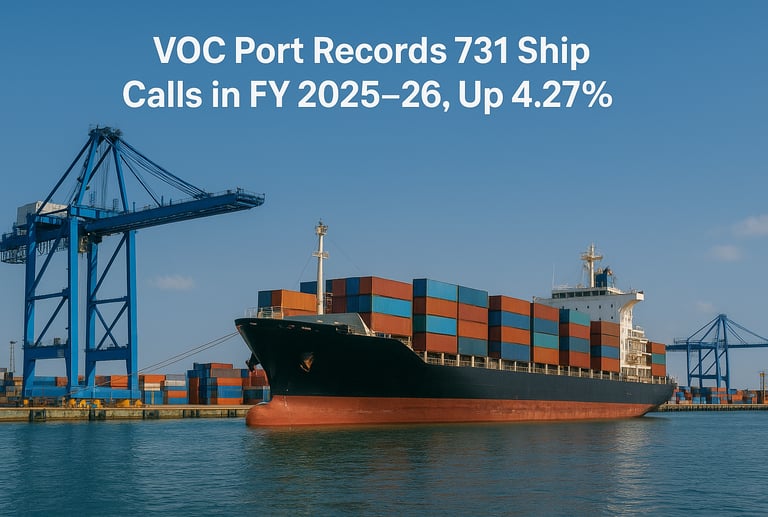

The Department of Fisheries (DoF) has signed a technical cooperation agreement with the Food and Agriculture Organization (FAO) to modernize India’s fishing harbours under the Blue Ports framework.
Three harbours—Vanakbara (Diu), Karaikal (Puducherry), and Jakhau (Gujarat)—have been approved for development with an investment of ₹369.8 crore.
The model will integrate digital and satellite-based systems, energy-efficient lighting, electric-powered equipment, rainwater harvesting, waste management, and marine debris removal, making ports more sustainable and resilient.
Abhilaksh Likhi, Secretary, DoF, said fishing ports must serve as gateways to economic growth, ecological sustainability, and social inclusion, while highlighting the role of 5G, AI, automation, and digital platforms in port modernization.
As part of the FAO partnership, pilot upgrades will begin at Vanakbara and Jakhau, focusing on investment planning, operational efficiency, and capacity building. Training will be extended to stakeholders to strengthen technical expertise and promote best practices.
India, FAO Partner to Develop Sustainable Blue Port Infrastructure


Shipowners Urged to Prepare as PSC Intensifies Ballast Water Compliance Inspections
18-09-2025


Shipowners are facing tighter Port State Control (PSC) checks on Ballast Water Treatment System (BWTS) compliance under a joint Paris and Tokyo MoU Concentrated Inspection Campaign (CIC) running until November 2025. The campaign enforces the Ballast Water Management (BWM) Convention through a ten-point checklist, focusing on valid certificates, updated BWM plans, type-approved treatment systems, crew competence, proper documentation, and sediment management. Non-compliance often stems from poor records and inadequate crew training rather than equipment issues, leading to risks of detention, delays, and reputational damage. BIO-UV Group urges owners to review documents, update plans, train crews, and conduct audits in advance. Its BIO-SEA UV and filtration systems are IMO and USCG approved, with global support for installation, training, and service.
India Targets 5% Global Shipbuilding Market Share by 2030
India has set an ambitious goal of capturing 5% of the global shipbuilding market by 2030, backed by a roadmap combining infrastructure, innovation, and sustainability. Union Minister Shantanu Thakur announced plans for ten world-class shipyards under PPPs, equipped with automation, digital twin, and green technologies to align with net-zero 2070 goals. The Maritime Development Fund will modernize shipyards, support R&D in autonomous and eco-friendly vessels, and train 50,000 skilled professionals. Port upgrades at Deendayal, Kolkata, and island territories, along with the PM Gati Shakti programme, will boost connectivity and efficiency. India also aims to launch a national container shipping line by 2030, producing half of its container vessels domestically by 2035, strengthening maritime self-reliance.


Bangladesh’s export-driven economy is under strain from a combination of new US tariffs, port service hikes, and higher ICD fees. Since August 1, Washington has imposed a 35% tariff on Bangladeshi exports, hitting the ready-made garment (RMG) sector, which earned $7.4 billion in 2024. Already battling weak global demand, exporters fear cancellations and reduced orders.
Domestically, the Chattogram Port Authority will introduce its first tariff revision in nearly 40 years, with service charges rising an average 40%, some by up to 440%, adding Tk 1,500 crore in revenue. From September, private ICDs will also increase handling charges by 32–44%, adding Tk 300 crore to logistics costs.
Industry experts warn these pressures could erode competitiveness, threaten jobs, and fuel inflation. Stakeholders are urging government intervention, dialogue with the US, and tariff reviews to safeguard trade stability.
Bangladesh Trade Faces Strain from US Tariffs and Rising Logistics Costs


Govt to Shortlist 100 Products to Reduce Imports, Promote Aatmanirbhar Bharat
The commerce department is preparing a list of 100 products with high import dependence but available domestic capacity, aiming to replace imports with local production under Aatmanirbhar Bharat. Commerce Secretary Sunil Barthwal said the move will help boost Make in India by identifying products where domestic manufacturers can scale up and meet demand.
The list, expected by month-end or October, will cover sectors like engineering goods, chemicals, plastics, and pharmaceuticals. A preliminary assessment has already flagged items that can be easily substituted through Swadeshi efforts, with further consultations planned with government bodies and industry.
The initiative comes amid reciprocal tariffs on Indian goods by the US and renewed emphasis on promoting domestic manufacturing and self-reliance.


The commerce department is preparing a list of 100 products with high import dependence but available domestic capacity, aiming to replace imports with local production under Aatmanirbhar Bharat. Commerce Secretary Sunil Barthwal said the move will help boost Make in India by identifying products where domestic manufacturers can scale up and meet demand.
The list, expected by month-end or October, will cover sectors like engineering goods, chemicals, plastics, and pharmaceuticals. A preliminary assessment has already flagged items that can be easily substituted through Swadeshi efforts, with further consultations planned with government bodies and industry.
The initiative comes amid reciprocal tariffs on Indian goods by the US and renewed emphasis on promoting domestic manufacturing and self-reliance.


CBIC Issues New Customs Rules to Fast-Track Import-Export Case Finalisation
DP World Expands Capacity and Green Operations at Mundra
DP World has boosted operations at the Mundra International Container Terminal (MICT) with the addition of a new quay crane and three electric Rubber-Tyre Gantry Cranes (e-RTGCs), strengthening Gujarat’s role as a key trade hub.
The quay crane, capable of handling vessels up to 22 rows across, enhances Mundra’s ability to serve the world’s largest ships with improved safety, efficiency, and reliability. With this addition, DP World Mundra now operates eight quay cranes, lifting its handling capacity to 1.56 million TEUs by 2027 and ensuring faster vessel turnaround times.
The three e-RTGCs expand Mundra’s fleet to 31 units, expected to cut Scope 1 and 2 emissions by 18.9% while reducing noise levels. The move aligns with India’s Harit Sagar green port guidelines, which target 50% electrification of port equipment by 2030 and 90% by 2047.
Globally, DP World has committed to cutting Scope 1 emissions by 42% and Scope 3 emissions by 28% by 2030 (from a 2022 baseline) and reaching net-zero carbon emissions by 2050. With direct connections to major global trade routes, DP World Mundra continues to be a cornerstone of India’s trade competitiveness and connectivity.


Vizhinjam Port to Enhance Efficiency with Dynamic Mooring System
Vizhinjam Port is set to commission a dynamic mooring system next month to improve operational efficiency and vessel reliability. The equipment has already been delivered, with staff training scheduled before rollout.
Installed at the quay, the system will allow ships to remain securely moored despite tidal shifts, swells, and adverse sea conditions—ensuring continuous container handling with minimal disruption. Unlike conventional methods, dynamic mooring reduces downtime, improves cargo flow, and boosts logistics reliability.
Officials said the system could cut vessel turnaround times, enabling cargo carriers to complete operations and depart within 24 hours. For shipping lines, this translates into lower costs, reduced idling, and better schedule control, while the port gains greater berth availability and the capacity to handle more vessels.
Currently handling nearly one million TEUs annually, Vizhinjam expects the new system to help scale throughput, attract larger vessels, and capture more transshipment traffic along East–West maritime routes.
Industry experts view the upgrade as part of India’s strategy to position Vizhinjam alongside global hubs like Colombo, Singapore, and Dubai, strengthening the country’s role in international container shipping and advancing port-led growth.


Mormugao Port Becomes India’s First Certified Green Port
17-09-2025


Mormugao Port has been officially declared the first accredited green port in India under the Green Port Certification Programme. The announcement was made by Mormugao Port Authority (MPA) Chairman N. Vinodkumar during a roadshow ahead of India Maritime Week 2025.
The certification follows the port’s pioneering step last year as the first in India to offer incentives and tariff discounts to commercial vessels based on their Environmental Ship Index (ESI) scores, aligning with global efforts to curb shipping-related emissions.
As part of its sustainability roadmap, the port has commissioned a 3 MW solar power plant, with plans to expand capacity to 5 MW in collaboration with the Goa Energy Development Agency (GEDA). These initiatives mark a major stride in reducing the port’s carbon footprint and promoting clean energy adoption.
India Maritime Week 2025 will take place in Mumbai from October 27–31, with participation expected from over 100 countries.
Mundra Port Handles Maiden Export of Hi-Tech Locomotives to Guinea


Mundra Port, operated by Adani Ports and Special Economic Zone Ltd (APSEZ), has successfully managed the first-ever export of advanced locomotives to Morebaya, Guinea, marking a milestone for Indian manufacturing and logistics under the Atmanirbhar Bharat vision.
The maiden consignment, comprising four state-of-the-art locomotives built at Wabtec Locomotive Pvt Ltd’s Marhowrah facility in Bihar, was shipped aboard the MV BBC Washington. This forms part of a larger project by Wabtec Corporation to export 150 locomotives through Mundra.
To meet overseas standard gauge requirements (1.435 metres), APSEZ executed a bogie conversion at its Agri Park rail siding in Mundra, deploying heavy-duty cranes, hydraulic trailers, and detailed inspections before vessel loading.
“Handling such complex, high-value shipments reflects Mundra Port’s capability and APSEZ’s commitment to world-class service standards,” an official said.
Exports are expected to continue at one to two locomotives per month, reinforcing India’s position as a reliable global rail equipment supplier and highlighting the strength of its integrated supply chain—from production hubs in Bihar to world-class port facilities in Gujarat.
DRI Seizes Pakistani Goods Worth ₹12 Crore at Navi Mumbai Port


The Directorate of Revenue Intelligence (DRI) has seized 28 containers of Pakistani-origin goods valued at ₹12 crore at Nhava Sheva Port, Navi Mumbai, under Operation Deep Manifest. The cargo, falsely declared as UAE-origin shipments via Dubai’s Jebel Ali Port, comprised around 800 tonnes of cosmetics and dates.
Two individuals have been arrested, and three Indian importers were found linked to the consignment. The goods are now under DRI custody pending further investigation.
Kashmir-Delhi Apple Train Fully Booked as Rail Service Eases Supply Chain Woes
The Kashmir-Delhi Apple Express, launched on 11 September to move apple consignments after landslides and floods shut the Srinagar-Jammu highway, has seen overwhelming demand. All services up to 16 September are fully booked, reflecting farmers’ urgency to transport harvests before spoilage.
The Jammu Division of Northern Railways is running parcel vans carrying 23 tonnes each of goods including apples, textiles, and courier items. A milestone was achieved as the Budgam–Adarsh Nagar service completed the journey in under 21 hours, while Budgam–Jammu took less than 6 hours.
On Saturday, a 10-wagon dedicated apple train was flagged off from Anantnag to Delhi, with three wagons terminating at Jammu. The initiative has brought major relief to Kashmir’s horticulture sector and drawn strong appreciation from growers and traders.


World’s First Wind-Assisted Tanker Debuts in Europe, Slashes Fuel Use


Union Maritime’s Brands Hatch, the world’s first wind-assisted tanker, has made its European debut, demonstrating the power of BAR Technologies’ WindWings. In favorable conditions, the vessel sourced over one-third of its propulsion from wind alone, even while fully loaded. Using sail-aware weather routing from Ascenz Marorka, it saved 12.8 tonnes of fuel and 13 tonnes of CO₂ per WindWing in a single day, with peak savings hitting 18 tonnes per day.
The ship is the first in Union Maritime’s planned rollout of a fleet of wind-assisted vessels to meet global emission targets through 2030. The initiative is part of AeroPower, a joint project with Anglo-Eastern, Synergy, Atlantas Ship Management, and BAR Technologies.
Union Maritime MD Laurent Cadji called the voyage proof of wind propulsion’s “real potential,” while BAR Technologies CEO John Cooper described the debut as a “landmark moment,” confirming WindWings are ready for commercial-scale deployment.
Indian Railways Launches Special Train for Kashmir Fruit Transport
14-09-2025


Indian Railways has introduced a daily special train from Budgam to Adarsh Nagar Delhi (BDGM–ANDI–BDGM) starting September 13, 2025, to boost fruit transportation from Kashmir. The train departs Budgam at 6:15 AM (Sept 15) and reaches Delhi by 5:30 AM next day, ensuring fresh arrival for markets.
The service operates with 8 Vehicle Parcel Vans (VPs) and 1 SLR, with loading/unloading at Bari Brahman (BBMN). Capacity may be expanded based on demand. Only registered JPP-RCS aggregators can book via www.fois.indianrail.gov.in
Northern Railway officials are coordinating with horticulture bodies, fruit growers, and traders for smooth operations. This follows last month’s cement freight service to Anantnag, further strengthening Valley’s logistics. The initiative promises cost-effective, reliable transport, reducing perishables’ losses and delivering fresher produce nationwide.
JNPA SEZ Transitions to 100% Green Energy with Wind Power Supply Agreement
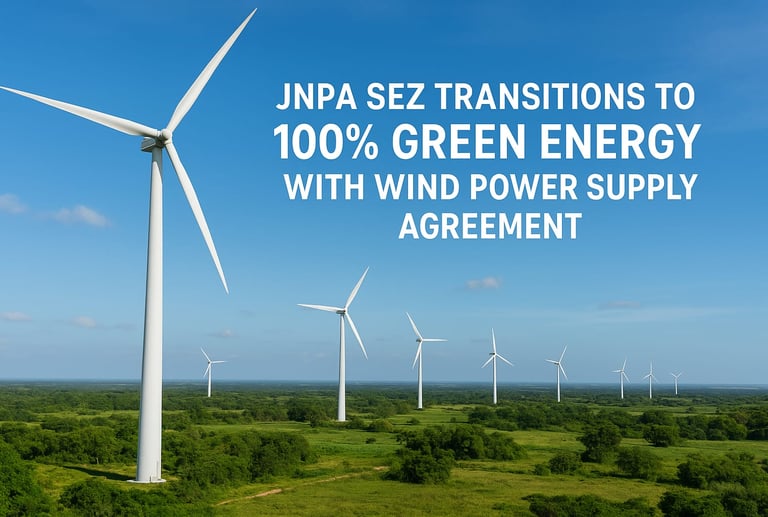

The Jawaharlal Nehru Port Authority (JNPA) Special Economic Zone (SEZ) has announced that it has achieved a 100% green energy milestone, marking a major step toward sustainable industrial operations. Effective September 1, 2025, the SEZ will source 6.0 MW of grid-connected wind power under a short-term open access agreement at a competitive rate of ₹3.12 per unit, nearly half the earlier tariff of ₹6.30 per unit.
Commenting on the milestone, Shri Unmesh Sharad Wagh, IRS, Chairperson, JNPA and CMD, VPPL, said:
“The transition of our SEZ to 100% green energy reflects our vision of building a responsible, future-ready industrial ecosystem. This shift reduces our carbon footprint while providing cost benefits to industries within the SEZ, reaffirming JNPA’s leadership in sustainable port-led industrial growth.”
Since its inception in August 2021, the SEZ has been procuring electricity from conventional sources under open access, as per Ministry of Power guidelines. This transition not only supports India’s renewable energy goals but also positions JNPA SEZ as a benchmark for sustainable industrial zones nationwide.
By adopting clean energy, JNPA SEZ strengthens its role as a frontrunner in green port infrastructure and reinforces its “node-to-network” strategy, evolving from a container terminal operator to a comprehensive port ecosystem provider
Hapag-Lloyd Signs Multi-Year Bio-LNG Supply Agreement with Shell


Hapag-Lloyd has entered into a multi-year agreement with Shell for the supply of bio-LNG, marking a significant step in its decarbonization journey. The deal, effective immediately, secures fuel certainty and supply reliability, enabling the carrier to expand the use of waste-based renewable fuels across its fleet while maintaining service quality.
Shell introduced bio-LNG to its global bunkering network in 2024, with availability now extended to 22 ports worldwide. The fuel provided to Hapag-Lloyd is ISCC EU-certified, ensuring sustainable feedstock, full supply chain traceability, and verified life-cycle emission reductions.
Derived from organic waste such as crop residues, livestock manure, and food waste, biogas is upgraded to biomethane, liquefied, and supplied to vessels on a mass-balance basis. By incorporating bio-LNG, Hapag-Lloyd aims to significantly cut greenhouse gas emissions and reinforce its long-term sustainability strategy.
Adani Ports Acquires Dependencia Logistics for ₹37.77 Crore

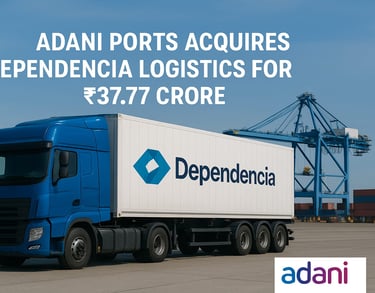
Adani Ports and Special Economic Zone (APSEZ) has announced the acquisition of Dependencia Logistics through its step-down subsidiary, Mandhata Build Estate, which signed a share purchase agreement with Windson Projects LLP for a 100% stake valued at ₹37.77 crore.
Dependencia, incorporated in February 2022 to offer transportation and logistics services, is yet to begin operations. APSEZ stated that the move is aimed at strengthening and expanding its logistics vertical, aligning with the company’s strategy to build a comprehensive port-led logistics ecosystem.
APSEZ, India’s largest private port operator, currently manages 15 domestic ports and terminals alongside four international locations, supported by an integrated logistics network and a broad portfolio of marine services.
Vizhinjam Port gets Customs cleareance for EXIM and Domestic Cargo Handling
13-09-2025


Adani Vizhinjam Port Company has received preliminary approval from the Customs and Central Excise Department to handle both export-import (EXIM) and domestic cargo, a milestone that brings the port closer to full-scale operations. Final clearance from the Kochi Customs Commissionerate is expected after pending formalities.
The approval positions Vizhinjam as a new gateway for global trade connectivity, with leading customs broking firms preparing to establish offices at the port. A dedicated customs office is already operational at the utility building near the harbor.
While EXIM trade can commence shortly, full-scale domestic export operations will begin only after road links to the national highway are completed. Work on widening container truck service roads is underway and expected to finish by December 2025.
Trial operations are scheduled to start in October 2025, with limited domestic cargo movement via existing routes. Feasibility tests for nighttime container traffic through Mullur Road are also being planned.
This development marks a key step in Vizhinjam’s transformation into a world-class transshipment hub, enhancing India’s maritime trade capacity and logistics competitiveness.
Deendayal Port Floats Tender for 1,000 MW Solar Project in Gujarat
Deendayal Port Authority (DPA) has invited bids for the development of a 1,000 MW solar power project on coastal land between Chirai and Jangi in Gujarat. The project will be awarded through a competitive bidding process with a 25-year power purchase agreement (PPA) for the selected developer.
Once operational, the project is expected to generate around 1,750 million units of power annually. Developers must complete construction and commence supply within 10 months of signing the PPA, underscoring the project’s accelerated timeline.
The proposed site lies in inter-tidal and marshy terrain within the Coastal Regulation Zone (CRZ), requiring bidders to secure all necessary environmental and regulatory clearances.
The bidding process will be conducted in two stages—an initial responsiveness check followed by financial evaluation. Eligible bidders must show a minimum free cash flow of ₹700 crore from operations. RFQ documents, priced at ₹10,000 (excluding GST), are available against a demand draft to DPA. An earnest money deposit and performance bank guarantee are mandatory.
As per the tender schedule, RFQ documents can be purchased within 15 days of the reference date (T0), while technical and price bids must be submitted within 30 days. The Letter of Intent will be issued within 75 days, with the final agreement to be signed within 90 days of T0.
The initiative marks a significant step in DPA’s sustainability strategy and offers a major opportunity for developers to tap into India’s fast-expanding renewable energy sector.


Allcargo Supply Chain Expands Southern Presence with Panapakkam Logistics Park


Allcargo Supply Chain, a part of Allcargo Logistics, has launched a 2.75 lakh sq. ft. Grade A warehousing facility at Panapakkam, near Chennai, further strengthening its southern network and infrastructure-driven growth strategy.
Strategically located at the intersection of NH 76 and SH 50, the Panapakkam Logistics Park offers seamless connectivity to Chennai Port, Red Hills, Sriperumbudur, Oragadam, and Sri City, positioning it as a critical multi-modal hub for pan-India distribution. The facility is designed to support sectors such as automobiles (50%), e-commerce, and consumer durables.
Built to global standards, the park features 32 docks with 16 dock levellers, G+8 racking capacity, a 5,000 sq. ft. mezzanine with client office space, and a handling capacity of nearly 60,000 tonnes per month. It is expected to generate employment for around 400 contractual workers monthly, with 95% drawn from the local workforce.
The facility is also sustainability-ready, with provisions for a solar rooftop, LED lighting, solar-powered streetlights, rainwater harvesting, STP recycling, and stormwater management. Safety features include dock levellers, fire hydrants, sprinkler systems, and a secured perimeter.
Ketan Kulkarni, Managing Director – Allcargo Supply Chain, said the launch represents a milestone in expanding capacity and building future-ready logistics infrastructure. “By integrating world-class facilities with sustainable practices, we are creating a logistics hub that drives value for businesses while contributing to India’s evolving supply chain ecosystem,” he noted.
The Panapakkam park complements Allcargo’s existing facilities in Bengaluru and the upcoming Hyderabad site, while reinforcing its nationwide network of modern logistics hubs in Farukhnagar, Nagpur, Guwahati, Bhiwandi, Indore, and Vijayawada.
Adani Group, India’s largest private port operator, has barred entry of vessels sanctioned by the United States, the European Union, or the United Kingdom at all its ports, according to official notices and industry sources.
The directive, issued by Adani Ports and Logistics, states that ships under Western sanctions will not be granted entry, berthing, or port services. Vessel agents must also provide a written undertaking at the time of nomination confirming that ships are free from sanctions.
The move could significantly affect Russian crude oil shipments to Indian refiners, who rely on Adani facilities. India has become the world’s largest buyer of Russian seaborne oil, much of it carried by tankers from the shadow fleet operating outside traditional shipping channels to bypass sanctions.
The impact may be most visible at Mundra Port in Gujarat, a critical entry hub for Russian crude. HPCL-Mittal Energy Ltd (HMEL), which operates a 226,000-barrels-per-day refinery in Bathinda, Punjab, imports all of its crude through Mundra. Indian Oil Corporation (IOC), the country’s largest refiner, also uses Mundra for supplies to its 10 refineries nationwide.
Industry data indicates both HMEL and IOC regularly receive Russian oil at Mundra. While the companies did not immediately comment, sources suggest IOC is exploring diversion of shipments to other Indian ports still open to vessels under EU or UK sanctions.
Although India officially recognizes only United Nations sanctions, Adani’s order cites protection of the “legal and commercial interests of the Port.” The group, which operates 14 ports across India, has reportedly extended the ban to all its facilities.


Adani Ports Bans Sanctioned Vessels, Potentially Disrupting Russian Oil Shipments to India
MSC Ivana Sets New Draft Record at JNPA’s PSA Mumbai Terminal
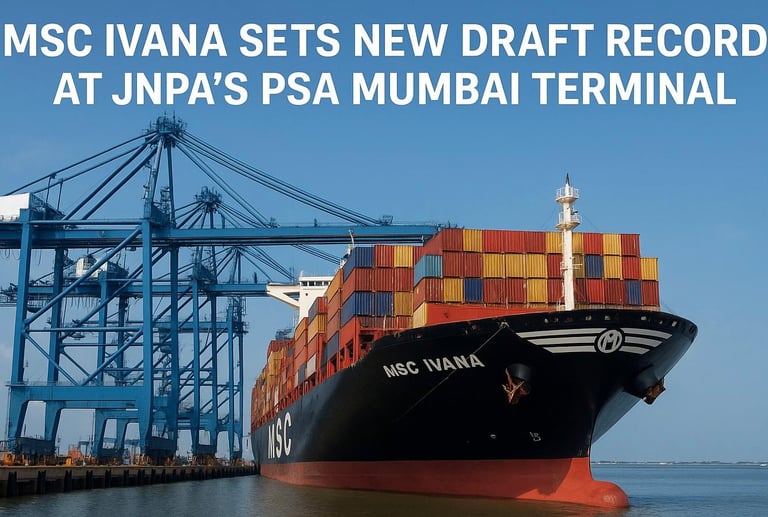

Jawaharlal Nehru Port Authority’s (JNPA) Bharat Mumbai Container Terminals (BMCT), operated by PSA, achieved a milestone with the MSC Ivana setting a new draft record, underscoring the terminal’s growing capability to handle larger vessels.
BMCT, the port’s largest container terminal, has been continuously upgrading its infrastructure and technology to attract mainline services and improve operational efficiency. These advancements have significantly reduced vessel turnaround times, making JNPA an increasingly competitive hub for international trade.
This achievement highlights JNPA’s commitment to enhancing India’s maritime logistics landscape, aligning with the nation’s broader goal of positioning itself as a global shipping and transshipment hub.
CONCOR Deploys First Electric Truck at TKD Terminal to Boost Green Logistics


Container Corporation of India Ltd. (CONCOR) has introduced its first electric truck at the Tughlakabad (TKD) Terminal in Delhi, marking a major step in its sustainability drive. The zero-emission vehicle, part of CONCOR’s wider Green Initiatives, will handle last-mile cargo movement within and around TKD, helping cut diesel consumption and reduce air pollution across the NCR.
A senior CONCOR official said the initiative reflects the company’s strategy of integrating clean technologies into freight operations to support India’s transition toward net-zero emissions.
Industry experts view the adoption of EVs in cargo movement as a significant push toward sustainable supply chains. With this pilot at TKD, CONCOR is expected to expand electric truck deployment across its nationwide terminal network, reinforcing its position as a leader in green freight solutions.
ONE to Launch IG2 Service Connecting India and Umm Qasr
Ocean Network Express (ONE) will roll out its India–Gulf Service 2 (IG2) later this month, providing direct weekly connectivity between India and Umm Qasr. The rotation will link Mundra, Nhava Sheva, Jebel Ali, and Umm Qasr, boosting trade flows between Indian ports and the Middle East.
The service, designed to ensure steady cargo movement into Iraq, also strengthens ONE’s footprint in the India–Gulf corridor. The inaugural sailing is scheduled for 25 September 2025, with the M/V TB JINJIANG v.2507 departing Mundra.
IG2 Rotation: Mundra – Nhava Sheva – Jebel Ali – Umm Qasr – Jebel Ali – Mundra.
By complementing ONE’s existing Gulf services, IG2 will deliver more reliable transit times and better inland connectivity via Umm Qasr. The launch also precedes adjustments to ONE’s Asia–North America services slated for October 2025.
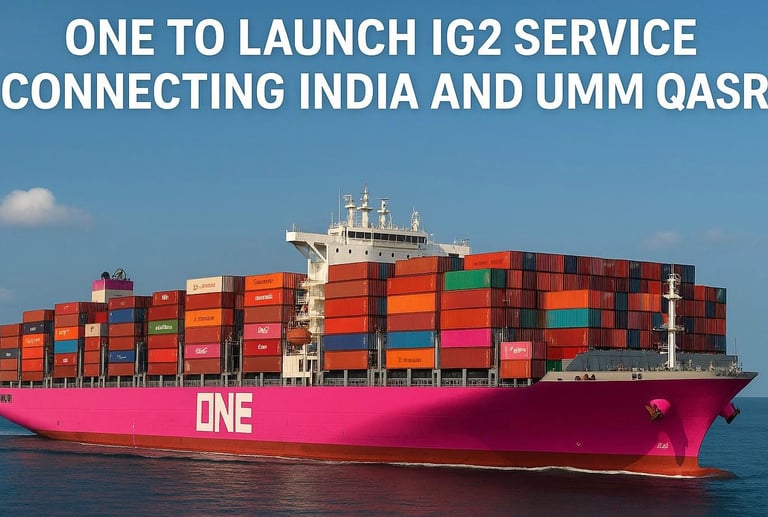

IUMI Urges Classification of Plastic Nurdles as Dangerous Goods
The International Union of Marine Insurers (IUMI) has renewed calls for plastic nurdles—small resin pellets used in plastic production—to be classified as dangerous goods, citing their severe environmental risks when spilled at sea. The issue took center stage at IUMI’s annual conference in Singapore.
Neil Roberts, Chair of IUMI’s Policy Forum, stressed the devastating impact of nurdle spills, referencing incidents such as the X-Press Pearl off Sri Lanka (2021), the MSC Elsa 3 off India (2025), and the Solong off the UK. Once released, nurdles are almost impossible to clean up and can enter the food chain, causing long-term ecological damage.
Currently, nurdles are transported in sacks inside containers without any special requirements, despite billions being shipped annually. “With billions more in production and transported by sea, more controls are needed. IUMI believes nurdles should fall under the dangerous goods code,” Roberts said.
The absence of regulation has already led to billion-dollar compensation claims against shipowners. In Sri Lanka, the Supreme Court recently awarded $1 billion in damages for the X-Press Pearl disaster, which spilled an estimated 70–75 billion nurdles, the largest marine plastic spill on record. Similarly, Kerala has filed a $1.1 billion claim against MSC following the MSC Elsa 3 casualty, in which 71,500 sacks of nurdles were lost at sea.
IUMI warned that without regulatory change, ship operators will face mounting liabilities while coastal ecosystems remain at risk from future spills.


12-09-2025
MOL Seeks Shipbuilding Partnerships in India
11-09-2025


Japan’s second-largest shipping company, Mitsui O.S.K. Lines (MOL), is exploring partnerships with Indian firms to build tankers domestically, aligning with India’s efforts to boost local manufacturing in the maritime sector.
The Indian government is currently modernising maritime laws to attract greater foreign participation in shipbuilding, ports, and shipyards. The reforms aim to reduce India’s freight payments to overseas firms by at least one-third by 2047.
Despite strong trade growth—driven by surging energy imports and rising exports of refined petroleum products—India’s shipping fleet has struggled to keep pace with demand. To address this gap, the government announced a ₹250 billion ($2.84 billion) Maritime Development Fund in its February budget to provide long-term financing for shipbuilding and repair infrastructure.
Shipbuilding has also been identified as a priority industry under India’s plan to emerge as a global-scale manufacturing hub, with multibillion-dollar investments expected across critical sectors.
India and Israel Sign Bilateral Investment Agreement in New Delhi
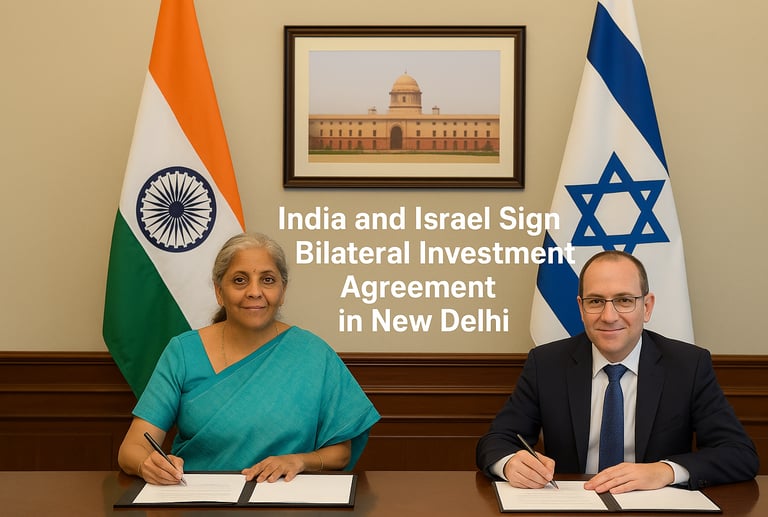

India and Israel have signed a Bilateral Investment Agreement (BIA) in New Delhi, marking a historic milestone in strengthening economic relations between the two nations. The agreement was signed by Union Finance Minister Nirmala Sitharaman and Israel’s Finance Minister Bezalel Smotrich, in the presence of senior officials from both governments.
The BIA is expected to boost bilateral investments, enhance investor protection, and promote trade growth. It provides a minimum standard of treatment, safeguards against expropriation, transparency measures, independent arbitration-based dispute resolution, and guarantees for smooth transfer of funds and compensation for losses. At the same time, it preserves regulatory space for both governments to pursue sovereign policy priorities.
Finance Minister Sitharaman highlighted India’s decade-long reform journey that has made it the world’s fastest-growing major economy and created an investment-friendly environment. She also called for greater business interactions to fully leverage the agreement.
Both ministers condemned terrorism, expressing solidarity in the wake of a terrorist attack in Israel. They also emphasized deeper collaboration in cybersecurity, defense, innovation, and high-technology sectors.
The two sides reaffirmed their commitment to advancing cooperation in fintech, infrastructure development, financial regulation, and digital payment systems. Minister Smotrich extended an invitation to Minister Sitharaman to visit Israel, underscoring the intent to further elevate bilateral economic ties.
Kolkata Port Ensures Smooth Cargo Flow for Nepal Amid Political Crisis
Shyama Prasad Mookerjee (SMP) Port, Kolkata, has assured uninterrupted cargo movement for Nepal despite the ongoing political turmoil in the Himalayan nation. The commitment follows the resignation of Nepalese Prime Minister K. P. Sharma Oli after widespread protests that saw vandalism of the parliament building and attacks on top leaders’ residences, including that of President Ramchandra Paudel.
Deputy Chairman Samrat Rahi emphasized Nepal’s reliance on Kolkata for third-country trade, noting that most shipments are transported via rail. He added that container freight stations and warehousing near the India–Nepal border would help avoid disruptions, making delays in unloading and discharge of Nepal-bound cargo unlikely. Though Nepal accounts for only a single-digit share of Kolkata’s overall cargo, the trade relationship is of high strategic value.
Nepal’s transit trade is primarily routed through Kolkata, Haldia, and Visakhapatnam ports under the India–Nepal Treaty of Transit. India remains Nepal’s largest trading partner, representing nearly 63% of its trade. In FY 2024–25, bilateral trade reached USD 8.02 billion, with Indian exports at USD 7.3 billion.
Major Indian exports to Nepal include petroleum, iron and steel, automobiles, machinery, and cereals, which together contribute about 16% to Nepal’s GDP. Conversely, India absorbed nearly 68% of Nepal’s exports—such as cardamom, edible oils, juices, plywood, and jute—during FY 2023–24.

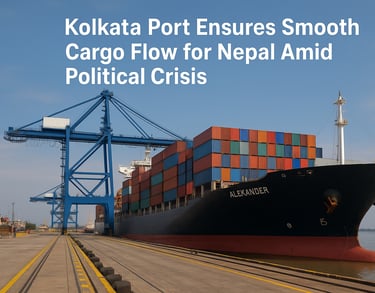
Hazira Liquid Terminal Achieves Second-Highest Bulk Liquid Throughput
10-09-2025


Adani Ports and Special Economic Zone Ltd. (APSEZ) announced that its Hazira Liquid Terminal handled 507,276 metric tonnes (0.51 million tonnes) of bulk liquid cargo in August 2025, marking its second-highest monthly throughput. The previous record stood at 0.49 million tonnes in October 2021.
During the month, the terminal managed 71 liquid tankers, underscoring its consistency in handling large-scale cargo. APSEZ said the achievement reflects customer trust, team dedication, and strong partner support, reinforcing Hazira’s position as a major liquid cargo hub on India’s western coast.
To illustrate scale, the volume handled equals the weight of 85,000 adult elephants or over 2,000 fully loaded Boeing 747s. APSEZ emphasized it will continue focusing on efficiency, stakeholder value, and supporting India’s growing trade and logistics ecosystem.
India’s Freight Wagon Market to Nearly Double by 2031: Report
India’s freight wagon market is projected to grow from Rs 120–140 billion in 2025 to Rs 250–300 billion by 2031, according to a report by SMIFS. This expansion, at a projected CAGR of 10–12%, will be driven by strong export opportunities, private sector involvement, and rapid adoption of advanced technologies.
The growth outlook is closely tied to the government’s ambitious push to transform Indian Railways (IR). By 2030, IR aims to increase its freight share from 27% to 45% and double freight volumes to 3 billion tonnes. Supporting this are massive infrastructure upgrades, including dedicated freight corridors (DFCs), track modernization, advanced signalling, and station redevelopment.
In FY24, Indian Railways added 5,300 km of new tracks, raising construction speeds from 4 km per day in 2015 to 14.5 km per day. Over the next five years, an additional 25,000 km of new lines will be built, while 23,000 km of existing tracks are being upgraded for speeds up to 130 kmph.
This expansion will significantly boost demand for modern, high-capacity wagons, reducing turnaround times and logistics costs. Alongside procurement, Indian Railways is investing in wagon replacement, maintenance modernization, advanced material handling systems, and IT infrastructure upgrades.
With these initiatives, the freight wagon sector is positioned as a key enabler of India’s logistics transformation, aligning with the country’s long-term freight growth targets.


Vizhinjam Port Sets Record with 16.95-Metre Draft Vessel
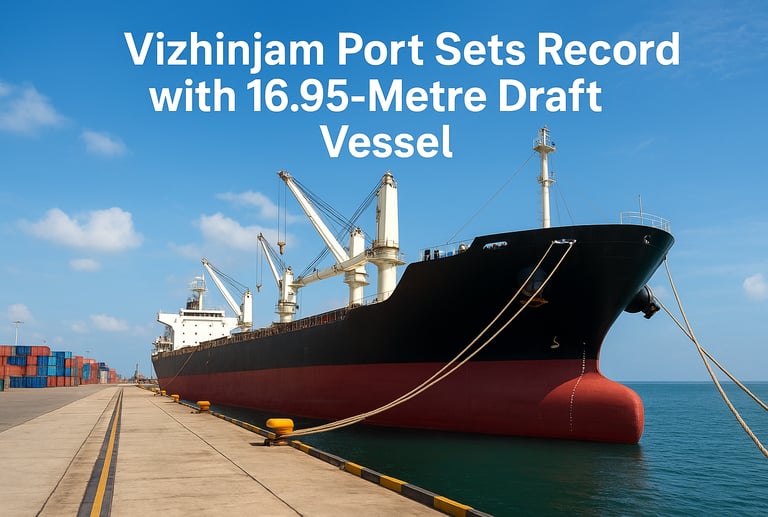

Vizhinjam International Port has set a new benchmark by handling the MSC Virginia, a container vessel with a 16.95-metre draft—the deepest ever at the port and the second-largest ship to berth at any Indian port.
The ship, which arrived from Mundra with a 16-metre draft, departed for Spain after loading around 5,000 TEUs of cargo, increasing its draft to the record level. The milestone, coinciding with the Onam festival, was hailed as a symbolic gift to Kerala.
This achievement surpasses Vizhinjam’s earlier record of 16.8 metres, and the port has now handled 17 vessels with drafts over 16.5 metres, reinforcing its capability to berth some of the world’s largest container ships.
With a natural draft depth of 18–20 metres, Vizhinjam is strategically positioned to serve as one of India’s premier deep-water transshipment hubs, enhancing its global maritime prominence.
Jawaharlal Nehru Port Authority (JNPA) and PSA Mumbai, a subsidiary of PSA International, have signed a supplementary agreement extending the concession period of Bharat Mumbai Container Terminals (BMCT). The agreement, concluded through conciliation, is seen as a significant milestone in India’s public–private partnership (PPP) journey in the maritime sector.
The signing ceremony was attended by Unmesh Sharad Wagh, IRS, Chairperson, JNPA & CMD, VPPL, and Vincent Ng, Regional CEO – Euromed and MESA, alongside senior officials from PSA India, PSA Mumbai, and JNPA.
The extension provides operational stability and long-term growth for BMCT, further reinforcing JNPA’s role as a key gateway for India’s international trade. It also underscores the success of the PPP model in port development.
BMCT represents India’s largest FDI under the PPP model, with an investment of USD 1.3 billion—the single largest investment from Singapore in India to date. Officials noted that the agreement not only supports commercial expansion but also strengthens India–Singapore bilateral ties, reflecting shared goals in trade, connectivity, and Indo-Pacific stability.
JNPA, PSA Mumbai Extend Concession Period for BMCT


India to Launch First Fully Electric Tug Under Green Transition Drive
09-09-2025


India is set to commission its first fully electric tug at Deendayal Port Authority, Kandla, Gujarat, marking a milestone in the Government of India’s Green Tug Transition Programme (GTTP). The 60-ton bollard pull vessel will support the country’s shift towards cleaner, energy-efficient port operations.
The project is being executed by a consortium of Netincon Marketing Pvt Ltd and Ripley Shipping Pvt Ltd, both under the Ripley Group, a key player in logistics, port development, and ship ownership on India’s east coast. The tug is being built at Mandovi Drydocks, with Ripley Group leading the investment as part of its sustainability-focused growth strategy.
Technology partners have equipped the vessel with a fully integrated propulsion and battery package, designed to deliver reliable, high-performance, and energy-efficient operations.
Officials highlighted that the launch signals a new era for Indian shipping, advancing the decarbonization of port services in line with national green port goals.
Singapore, India Sign MoU to Develop Green and Digital Shipping Corridor
Singapore and India have signed a memorandum of understanding (MoU) to establish a Green and Digital Shipping Corridor (GDSC), strengthening cooperation in maritime decarbonization and digitalization. The agreement was exchanged on September 4, 2025, in New Delhi during Singapore Prime Minister Lawrence Wong’s official visit, in the presence of leaders from both nations.
The MoU will see the two countries work with industry partners to create infrastructure and technologies that enable the use of zero- or near-zero emission marine fuels. It also includes collaboration on digital information exchange and joint research into green technologies and solutions for the maritime sector.
Officials noted that India’s renewable energy capacity and manufacturing base position it as a potential supplier of alternative marine fuels, while Singapore’s hub-port status and bunkering expertise provide a strong foundation for the corridor. The initiative aligns with global efforts to reduce greenhouse gas emissions and accelerate digital transformation in shipping.
The agreement builds on a letter of intent signed in March 2025 to identify stakeholders and pilot projects in both digitalization and decarbonization. It also complements India’s broader maritime vision, which includes plans to boost domestic shipbuilding and a parallel green shipping corridor initiative with the Netherlands.
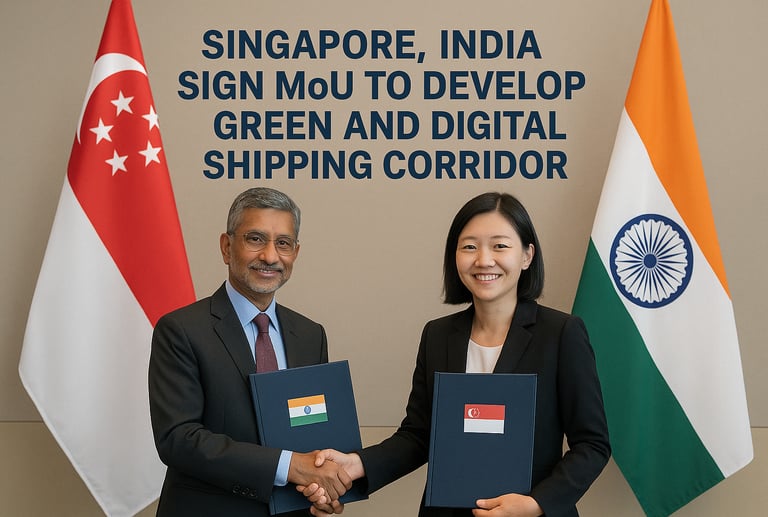

CONCOR Signs MoU with BPIPL to Operate Bhavnagar Port Container Terminal


Container Corporation of India Ltd. (CONCOR) has signed a memorandum of understanding (MoU) with Bhavnagar Port Infrastructure Pvt. Ltd. (BPIPL) to operate and maintain the upcoming container terminal at the northside of Bhavnagar Port, Gujarat. The MoU was formalized in New Delhi on September 4, 2025.
BPIPL had earlier signed an agreement with the Gujarat Maritime Board in September 2024 to develop the terminal, with 235 hectares of land allotted on a 30-year lease and scope for a further 250-hectare expansion. The terminal is expected to serve the logistics needs of Central Gujarat, the Dholera Industrial Belt, and extend connectivity to the National Capital Region (NCR).
Under the MoU, CONCOR will function as the Container Terminal Operator, handling operations, management, and marketing. This marks CONCOR’s strategic foray into port operations, strengthening its vision of forward integration. With its pan-India terminal network and extensive rolling stock, the company aims to deliver reliable and cost-effective logistics solutions. CMD Sanjay Swarup said the partnership would add significant value for customers while bolstering CONCOR’s leadership in the logistics sector.
Chennai Adopts Commodity-Based Freight Model Amid Land-Use Data Gaps

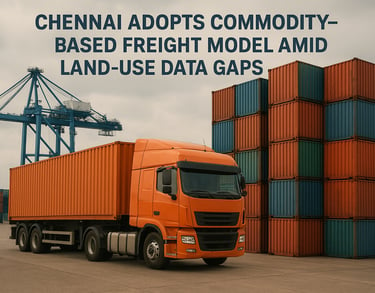
The Chennai Unified Metropolitan Transport Authority (CUMTA), in collaboration with Ernst & Young (EY), is shifting to a commodity-based freight planning model after finding major gaps in industrial and commercial land-use data.
While the Chennai Metropolitan Development Authority’s (CMDA) third master plan covers only 1,189 sq km of the old metropolitan boundary, vast portions of the expanded 5,904 sq km region lack detailed land-use mapping. In these newer areas, only broad “growth area” classifications exist.
Planners had initially aimed to link freight demand to mapped locations of factories, warehouses, and commercial hubs. However, with data unreliable, CUMTA is now projecting demand based on anticipated cargo volumes, goods types, and trade flows.
Experts caution that freight forecasts must eventually align with CMDA’s master plan, which itself needs to be expanded to cover the full metropolitan area for coherent logistics and infrastructure planning.
MOL, ONGC to Jointly Build $370M Ethane Carriers for OPaL Feedstock
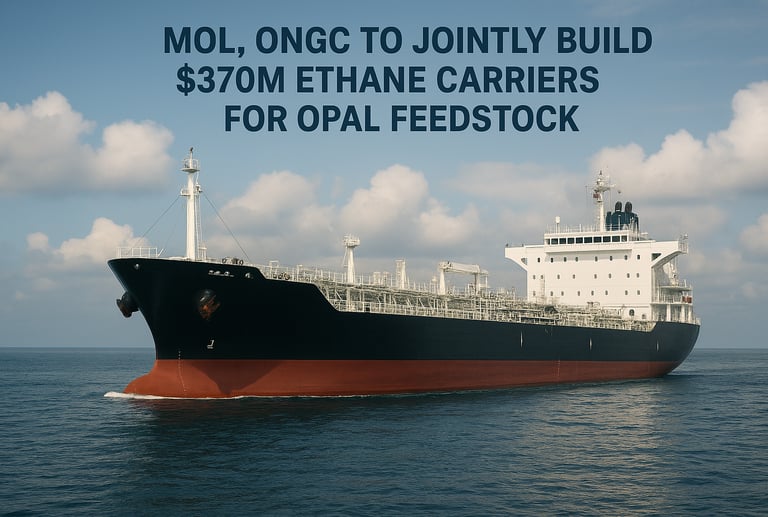

Japanese shipping giant Mitsui O.S.K. Lines (MOL) will partner with Oil and Natural Gas Corporation (ONGC) to build and operate two very large ethane carriers (VLECs) worth about $370 million, securing feedstock supplies for ONGC Petro Additions Ltd. (OPaL) at Dahej, Gujarat.
Industry sources suggest MOL may take a majority stake in the joint venture, with the final equity structure dependent on ONGC’s investment commitment. The vessels, to be built at Korean shipyards, are slated for delivery before mid-2028, ahead of ONGC’s planned ethane imports.
The move follows Qatar’s revised 2028 LNG contract, which eliminates ethane and propane from its supply. To safeguard feedstock, ONGC has already invested ₹1,500 crore in a C2/C3 extraction facility at Dahej. OPaL operates Southeast Asia’s largest standalone dual-feed cracker with 1.1 million tonnes annual ethylene capacity, requiring about 800,000 tonnes of ethane imports each year.
MOL, which currently operates six ethane carriers for Reliance Industries and four LNG carriers for Petronet LNG, will expand its India footprint through this partnership. ONGC’s board is expected to finalize the joint venture structure in the coming months.
World’s First Ammonia-Powered Short-Sea Containership Enters Construction
Steel cutting has commenced in China for Yara Eyde, the world’s first ammonia-fuelled containership, marking a major step in shipping’s decarbonization journey. The 1,400-TEU ice-class vessel is being built at Qingdao Yangfang Shipbuilding for CMB.TECH’s container division, Delphis, and will be operated by NCL Oslofjord—a joint venture between North Sea Container Line and Yara Clean Ammonia. Delivery is scheduled for mid-2026.
Designed for short-sea trade between Norway and Germany, Yara Eyde has received a $3.6 million grant from Norway’s Enova Investment Fund. Once operational, it will connect Oslo, Porsgrunn, Bremerhaven, and Rotterdam, transporting fertilizer containers from Yara International’s Porsgrunn plant. Yara Clean Ammonia will supply the fuel.
Currently, only three ammonia-powered vessels are in service worldwide, though 39 are on order, according to DNV. The project aims to demonstrate ammonia’s viability as a low-emission marine fuel, accelerate safety standards and bunkering infrastructure, and encourage broader adoption across global shipping.
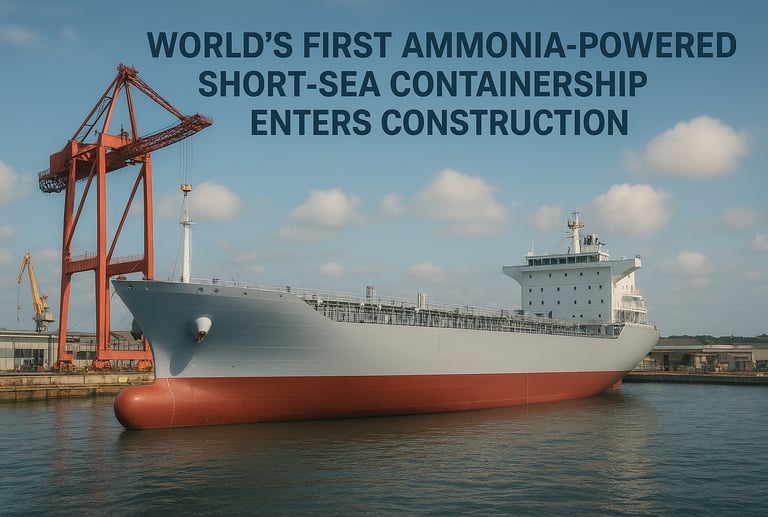

Shanghai Retains Title as World’s Busiest Container Port in H1 2025
Shanghai Port maintained its position as the world’s busiest container hub in the first half of 2025, handling 27.065 million TEUs, up 6.1% year-on-year. The Yangshan deep-water port contributed 14.056 million TEUs, a 7.5% increase, accounting for over half of the port’s total throughput.
Overall cargo volumes reached 297 million tonnes, up 1.2%, while bulk and general cargo fell 8.9% to 40.193 million tonnes. Shanghai International Port Group (SIPG) posted revenues of RMB 19.57 billion and a net profit of RMB 8.04 billion during the period.
SIPG attributed the growth to stable macroeconomic conditions and resilient import-export demand, despite a “weak balance” in global container shipping markets. The group noted industry trends such as vessel upsizing, operational alliances, digitalisation, green transition, and integrated logistics will continue to shape global port operations.
Looking ahead, SIPG said it will strengthen its hub port service capacity to navigate challenges while supporting China’s trade and shipping growth.
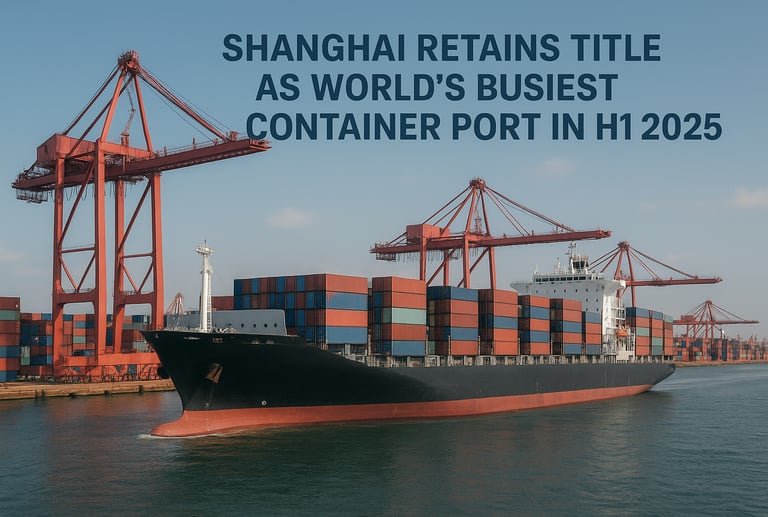

DP World’s $2.5 Billion Global Investments Create 5,000 Jobs Across Four Continents
04-09-2025
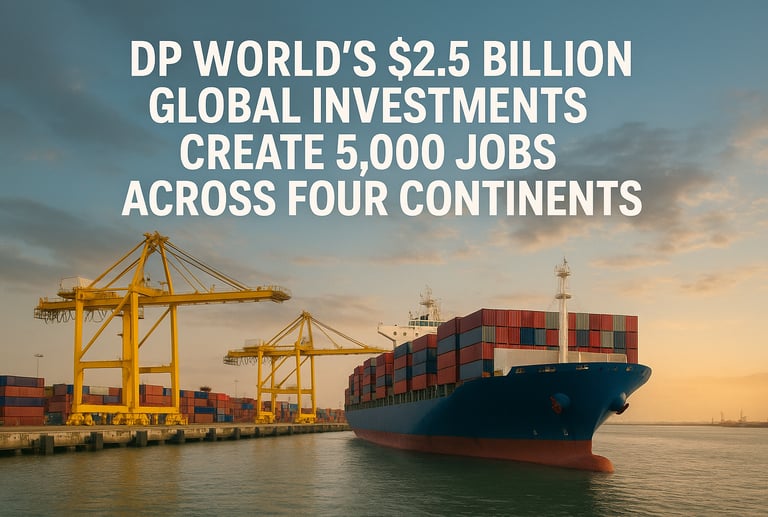

DP World’s ongoing $2.5 billion investment in global logistics infrastructure is generating nearly 5,000 new construction jobs in 2025, as the company delivers major transport projects across India, Britain, Ecuador, Senegal, and the Democratic Republic of Congo. The initiative underscores DP World’s dual focus on enhancing global trade flows while driving local economic growth.
India will see the largest share, with 2,000 jobs created through the development of a new terminal at Tuna Tekra, alongside 500 additional roles in rail and inland terminal projects. In Senegal, the construction of a deep-sea port at Ndayane is generating 600 jobs, while in the Democratic Republic of Congo, the Port of Banana—set to become the country’s first deep-sea port—is creating 500 positions.
In Britain, DP World’s $1 billion London Gateway expansion—adding two new berths and a second rail terminal—is creating 1,000 jobs, strengthening the hub’s path to becoming the UK’s largest port by the decade’s end. Meanwhile, in Ecuador, the expansion of DP World Posorja is adding 300 construction jobs and over 100 new operational roles.
Sultan Ahmed bin Sulayem, Group Chairman and CEO of DP World, said:
“Trade has the potential to transform people’s lives, and these new jobs show how that works in practice. The projects will leave behind world-class logistics infrastructure that will benefit customers, communities, and continents for decades to come.”
With over 100,000 employees worldwide, DP World’s investments continue to deliver not just infrastructure, but long-term employment opportunities. Upon completion, the projects are expected to support thousands of additional direct and indirect jobs while boosting connectivity across key trade regions.
IWAI Records Historic 145.84 MMT Cargo Movement on National Waterways

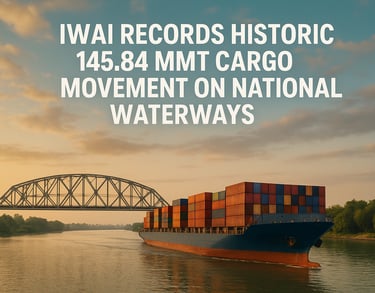
The Inland Waterways Authority of India (IWAI) has achieved an all-time high cargo movement of 145.84 million metric tonnes (MMT) on National Waterways in FY 2024–25, marking a major milestone for inland water transport.
The achievement was announced at the Water Voyage Northeast event by Sunil Kumar Singh, Vice Chairman and Chairman In-charge of IWAI, who highlighted the growing importance of inland waterways in India’s logistics ecosystem.
The North Eastern Region (NER) also contributed significantly, with over 1 MMT of cargo transported via National Waterways during the year. Singh noted that the record growth reflects the government’s strong push for sustainable, cost-efficient transport solutions, while enhancing trade connectivity and regional integration in the Northeast.
India Maritime Week 2025 to Highlight India’s Global Leadership Ambitions: Sonowal
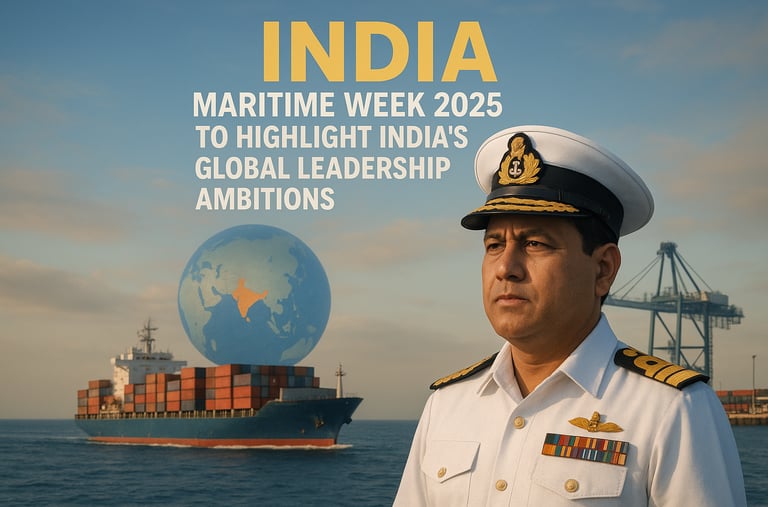

Union Minister of Ports, Shipping and Waterways Sarbananda Sonowal announced that India Maritime Week (IMW) 2025 will be held in Mumbai from October 27–31, positioning India as a rising global maritime leader.
Speaking at a regional roadshow in Guwahati, Sonowal confirmed that Prime Minister Narendra Modi will participate, alongside maritime ministers from several countries. “The Prime Minister’s presence will add strength and global recognition to our initiative,” he said.
The event is expected to draw traders, industry leaders, and experts from nearly 100 countries, making it a vital platform for investment, collaboration, and policy dialogue to accelerate India’s maritime growth.
The Guwahati roadshow also spotlighted the future of inland waterways, with focus on river cruise tourism and urban water transport. Attendees included Union MoS Shantanu Thakur, MoPSW Secretary T.K. Ramachandran, and transport ministers from all Northeastern states.
IMO Chief Calls for Stronger Ship Registration Practices Amid Rise of Dark Fleet
03-September-2025
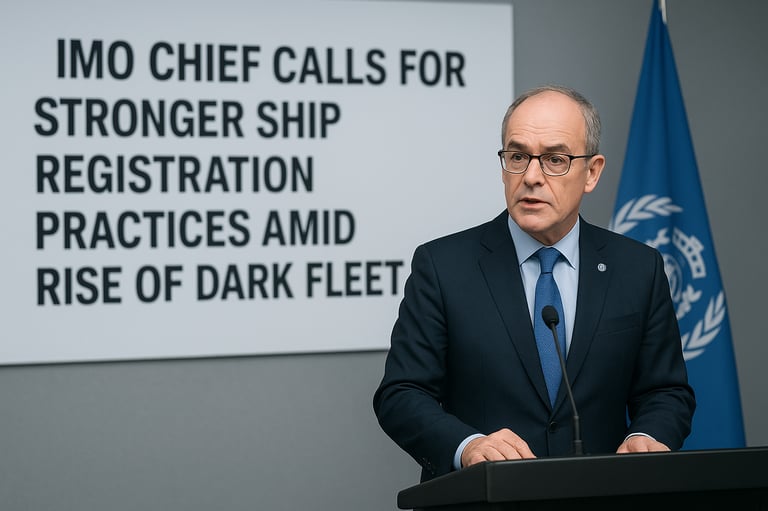

On his first official visit to Panama as Secretary-General of the International Maritime Organization (IMO), Arsenio Domínguez emphasized the urgent need for stronger ship registration practices to address the growing threat posed by the so-called “dark fleet.”
Panama, the world’s second-largest ship registry, was a focal point for discussions. Domínguez acknowledged the challenges of vessels using obscure registries and frequently changing flags to evade international sanctions.
“The IMO cannot and does not wish to regulate how countries flag their ships. However, we encourage all nations to adopt robust registration practices and comply with global maritime requirements,” Domínguez stated, adding that the IMO will review and strengthen flagging guidelines in October.
Key Points from the Visit
Dark Fleet Concerns: Shadow fleets often exploit weak registries, undermining maritime safety and sanctions compliance.
Panama’s Measures: Panama has already tightened registry rules—deregistering sanctioned vessels, rejecting tankers and bulkers over 15 years old, and imposing stricter controls on ship-to-ship oil transfers.
IMO’s Focus Areas: Beyond shadow fleet issues, IMO priorities include seafarer protection, piracy prevention, environmental safeguards, gender inclusion, cybersecurity, and AI regulation in shipping.
Domínguez stressed that multilateral cooperation is critical to safeguarding international maritime transport and ensuring responsible global trade.
Dedicated Freight Corridors Record 47% Growth in Train Operations in FY 2024-25
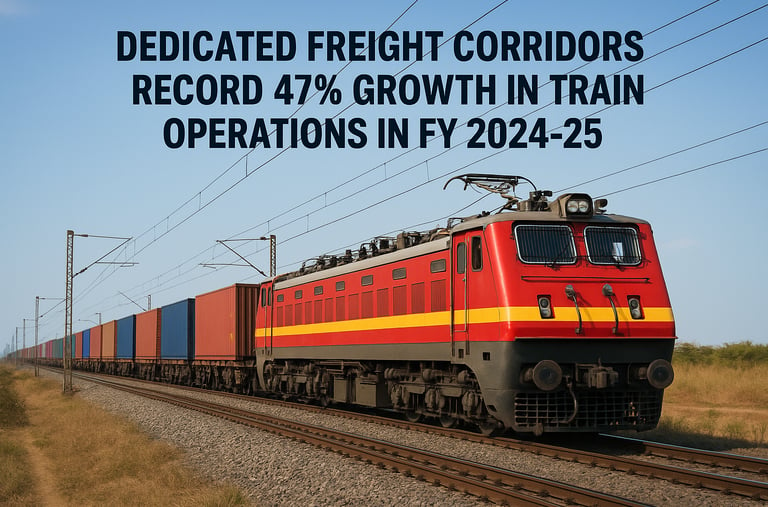

The Dedicated Freight Corridor Corporation of India Ltd. (DFCCIL) reported a 47% surge in freight train operations in FY 2024-25, with trips rising to 1,30,116, up from 88,225 in the previous year.
Traffic & Commodities
Vacant trips formed 34% of movements, mainly due to coal and cement wagons returning empty.
Containerized cargo led with 24% of trips, followed by coal (19%), and miscellaneous goods (11%). Other commodities such as cement, steel, foodgrains, fertilizers, and petroleum products contributed smaller shares (1–4%).
Corridor Progress
Out of 2,843 km total length, 2,741 km is operational.
The Eastern Corridor (1,337 km) is fully functional, while 93% of the Western Corridor (1,506 km) is active, with the final 102 km stretch to JNPT expected by December 2025.
Operations have grown from just 20 trains in 2020-21 to over 350 trains daily today.
Efficiency & Private Participation
DFCCIL is working to cut empty runs through return-trip discounts of up to 20% and deployment of multi-purpose wagons. With 115 stations across the corridors, private players are being encouraged to set up sidings and cargo terminals under PPP models to boost logistics capacity.
Mormugao Port to Deepen Channel, Redevelop Berth 9 for Capesize Vessels

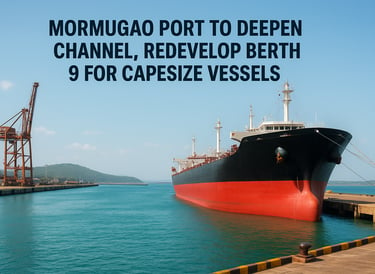
The Mormugao Port Authority (MPA) is set to launch a four-year dredging and redevelopment project to boost capacity and enable handling of larger vessels. The initiative will deepen the port’s approach channel from 14.4 metres to 19.5 metres, allowing entry of Capesize vessels.
Key Developments
Channel Deepening: Consultant to be appointed for the detailed project report; Centre support sought for faster execution.
Berth 9 Redevelopment:
Approved for conversion into a modern multi-cargo terminal with a long-term design outlook.
Berth 9, the port’s last unmonetised facility, offers 200–250 metres of waterfront, previously used for iron ore handling.
Tendering expected by year-end; construction to take about 24 months.
Background & Outlook
Earlier PPP plans worth ₹842 crore were stalled due to uncertainty in Goa’s iron ore mining sector. With environmental clearances now secured, MPA aims to transform Berth 9 into a future-ready cargo hub.
The dual projects—channel deepening and berth redevelopment—are expected to strengthen Mormugao’s position in India’s maritime trade network and align with the government’s push for deep-draft berths at major ports.
VOC Port Launches Multi-Cargo Berth Development Project


VOC Port Authority has begun construction of Multi-Cargo Berth No.10, a key infrastructure project aimed at expanding its cargo handling capacity. The groundbreaking ceremony was led by Chairperson Susanta Kumar Purohit, IRSEE, along with senior port officials.
Project Highlights
Berth Size: 445 metres long with a 10-metre draft, to be dredged to 15.5 metres.
Capacity: Designed to handle vessels up to 1,25,000 DWT.
Infrastructure: Includes a 7.4-hectare backup yard with heavy-duty pavement for efficient cargo operations.
Timeline: Completion targeted for 30 November 2026.
The project will enhance VOC Port’s role as a leading multi-cargo gateway, strengthening its contribution to India’s maritime trade.
Adani Ports Delivers Record Cargo Growth , Strengthens Gujarat’s Maritime Position
02-September-2025
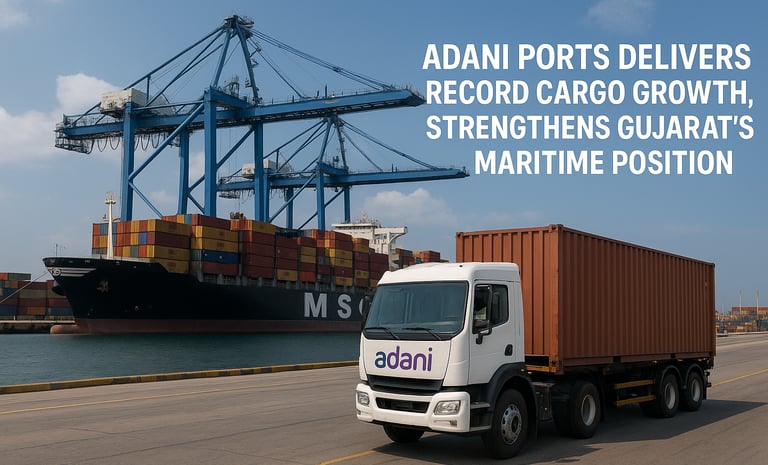

August 2025 Performance:
APSEZ handled 41.9 MMT cargo, up 16% YoY.
Container traffic surged 29%, cementing APSEZ’s leadership.
Mundra Port Milestones:
T2 Terminal: Highest-ever throughput – 1,29,780 TEUs.
AMCT (CT2): New monthly record – 1,04,793 TEUs across 40 vessels.
RoRo: New single-day record – 1,460 cars (Aug 29), surpassing March 2025’s 1,435.
Container & Rail Operations:
Outward TEUs: 0.97 lakh across 756 import rakes (new record).
Double stack handling: 0.50 lakh TEUs across 885 rakes (surpassed July 2025’s 0.46 lakh).
Year-to-Date (Apr–Aug 2025):
202.6 MMT cargo, up 11% YoY.
Container volumes up 22%.
Rail volumes: 2,97,766 TEUs (+14%).
GPWIS cargo: 9.35 MMT (+3%).
Logistics Boost (Aug 2025):
Rail volumes: 57,347 TEUs (+8% YoY).
GPWIS cargo: 1.69 MMT (+3%).
IRS and DMECA Host Seminar on “Maritime Workforce 2030” to Strengthen Seafarer Career Pathways


The Indian Register of Shipping (IRS), in collaboration with the DMET MERI Ex-Cadets Association (DMECA), hosted a seminar in Mumbai titled “Maritime Workforce 2030: Pathways, Progress & Preparedness – Shaping Future Leaders for a Sustainable Maritime Sector.” The event convened senior maritime leaders, educators, and industry experts to deliberate on building a skilled, future-ready workforce and enhancing the appeal of the seafaring profession.
Key Highlights
Keynote Address
Arun Sharma, Executive Chairman, IRS, underscored the need to uplift the profile of seafarers and position seafaring as a prestigious career—both at sea and as a pathway to leadership roles ashore.
He advocated for the introduction of Marine Engineering programmes at IITs, equating maritime engineering education with India’s achievements in aviation and technology.
Panel Discussions
Beyond the Seas – Career Pathways Post-Seafaring: Explored structured transitions for seafarers into ship management, classification societies, marine finance, insurance, and technology-driven roles.
Future Skills for Maritime 2030 – AI, Sustainability & Beyond: Focused on the emerging competencies needed to navigate decarbonisation, digitalisation, AI integration, and sustainability challenges.
Strategic Vision
Sharma reiterated: “Seafarers are the lifeblood of maritime trade. By elevating maritime education and integrating marine engineering into premier institutes, India can strengthen its talent pipeline and reinforce global maritime leadership.”
Echoing this, Mudit Mehrotra, Secretary, DMECA, emphasised the seminar’s role in advancing workforce development and aligning with Maritime Amrit Kaal Vision and Atmanirbhar Bharat initiatives, thereby reinforcing India’s position as a global maritime hub.
Kamarajar Port Becomes India’s First Automobile Transshipment Hub
01-September-2025
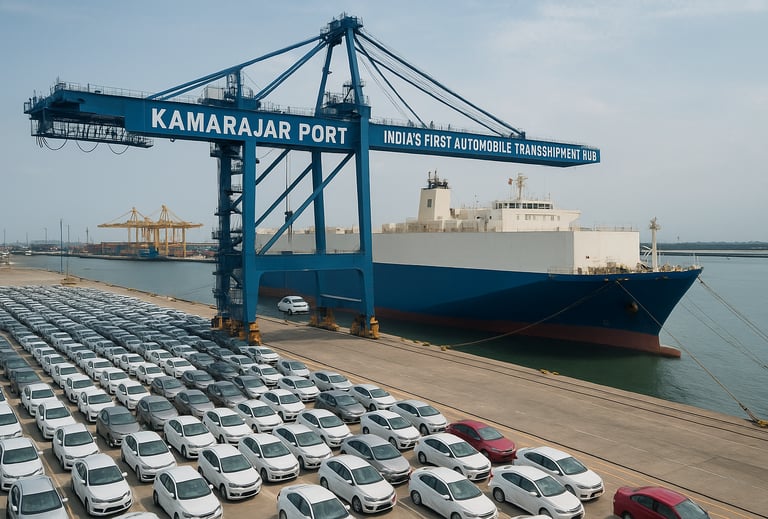

Kamarajar Port Limited (KPL) has set a milestone by becoming the first port in India to handle automobile transshipment operations.
On 27 August 2025, the port managed its maiden consignment as 550 cars of Mitsui O.S.K. Lines (MOL) Group were discharged from the car carrier m.v. Tourmaline Ace at the General Cargo Berth and placed in the GCB Transit Yard.
The shipment was reloaded on m.v. Marguerite Ace on 29 August for onward delivery to South Africa, Mauritius, and Tanzania.
With more consignments lined up, Kamarajar Port is positioning itself as India’s emerging hub for automobile transshipment, strengthening its role in global trade logistics.
KICT Achieves Record 4 MMT Cargo Milestone Ahead of Schedule

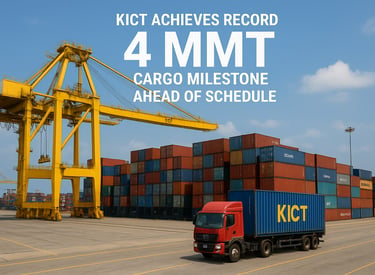
Kandla International Container Terminal (KICT) set a new benchmark by crossing 4 million tonnes (MMT) of cargo in FY2025–26 on 27 August 2025 — Achieved over two months sooner than in the previous year, when the milestone was reached on 31 October 2024
This marks the fastest-ever milestone for the terminal at Deendayal Port, showcasing improved efficiency, operational reliability, and stakeholder coordination.
KICT credited the achievement to teamwork, customer trust, and strong logistics partnerships.
The milestone reinforces Deendayal Port’s role as a key hub in India’s maritime trade and positions KICT as a frontrunner in handling rising cargo volumes with speed and precision.
DP World Deploys Electric Vehicles at Laem Chabang Terminal
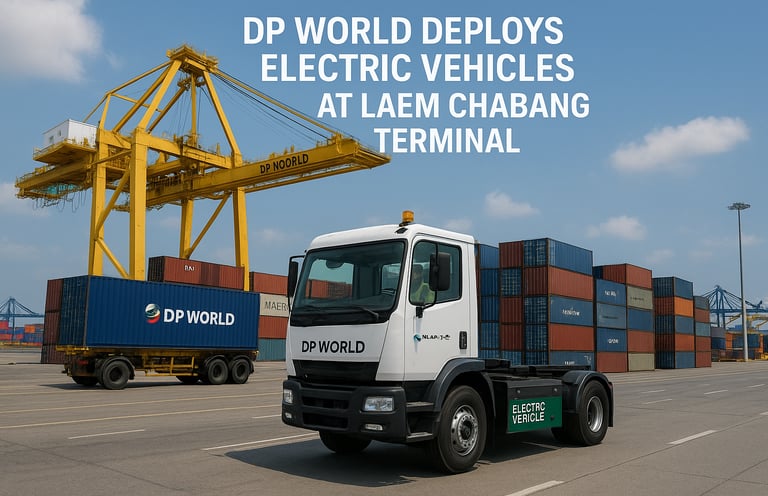

Green Transition: DP World has introduced five electric internal transfer vehicles (eITVs) at Laem Chabang International Terminal (LCIT), Thailand.
Sustainability Goals:
Supports Port Authority of Thailand’s Green Port Strategy to make Laem Chabang a fully green port by 2030.
eITVs cut 60% emissions vs. diesel units.
Full fleet electrification by 2030 to reduce LCIT’s carbon footprint by 12% (from 2022 levels).
Clean Energy Push: Solar power installations underway at the CFS warehouse and other key facilities.
Operational Benefits: eITVs speed up container transfers, reduce vessel turnaround times, and enhance terminal productivity.
Group Update: Drydocks World (DP World Group) secured an EPC contract from AMIGO LNG to build the world’s largest Floating LNG liquefaction facility.
Bengaluru to Host Largest Intralogistics & Warehousing Expo (Nov 6–8, 2025)
31-August-2025

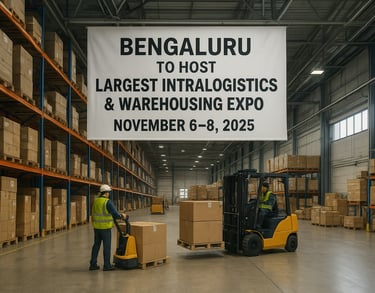
The 4th edition of the Intralogistics & Warehousing Expo will be held from 6–8 November 2025 at KTPO Convention Centre, Whitefield, Bengaluru, alongside the E-Commerce Logistics Expo and Material Handling Expo.
Focus: Complete value chain of warehousing infrastructure, material handling, automation, logistics, and supply chain solutions.
Participants: Major players including Gandhi Automation, Cloudleap, ACE, MHE Bazar, Epack, Nilkamal, Avians, Smith, Mount Roofing, Saint Gobain, Sany Heavy Industries, Newgentech MHE, among others.
Visitors: Buyers from e-commerce, retail, food, pharma, electronics, and more.
Highlights:
E-Commerce Logistics Summit with 75+ industry experts, themed “Speed, Scale, and Smart: Logistics 2030”.
Networking Events: Expert panels, case studies, and discussions on emerging trends, operational challenges, and future innovations in warehousing & logistics.
Open-House Sessions: Hands-on learning on AI in logistics, warehouse automation, and digital platforms for growth.
Organizer’s Note: The expo will spotlight how automation, AI, and digital innovation are transforming India’s warehousing sector, giving businesses a competitive edge.
Over 30 Countries Suspend Postal Services to US After De Minimis Exemption Ends
Write your text here...The US government ended the ‘de minimis’ exemption on August 23, which earlier allowed goods under $800 to enter duty-free without tariffs. As a result, 30+ countries have halted postal services to the US, citing lack of systems to process tariffs and remit them to US Customs.
Countries suspending services: Australia, Austria, Belgium, Bulgaria, Cyprus, Czechia, Denmark, Estonia, France, Germany, Greece, India, Italy, Japan, Latvia, Liechtenstein, Lithuania, Malta, Moldova, Montenegro, Norway, Poland, Portugal, Serbia, Singapore, Slovenia, South Korea, Spain, Sweden, Switzerland, Taiwan, Thailand, and Mexico.
Major postal operators affected:
India Post – suspended all categories of US-bound mail (up to $100).
La Poste (France) – stopped standard parcel shipments (from Aug 22).
Australia Post – temporarily suspended shipments, working with US authorities.
DHL Group, PostNord (Sweden & Denmark) – imposed restrictions due to unclear customs requirements.
Impact:
Customers will face delays and higher costs, as all parcels must now clear customs.
Small businesses exporting to the US will be hit harder than large firms.
US e-commerce platforms like Etsy and eBay have issued notices warning customers of disruptions.
Reason: The US administration tightened rules, citing misuse of de minimis to ship fentanyl and other contraband into the country.
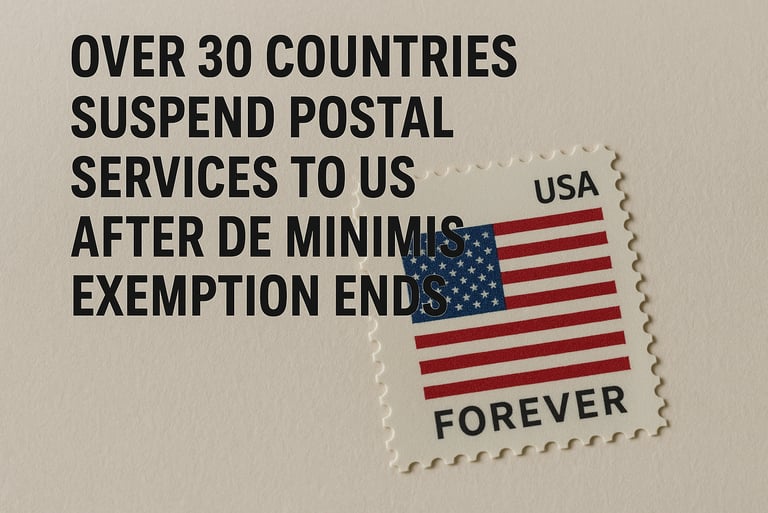

IMU Hosts Dialogue on Port Transformation, Signs Two MoUs
The Indian Maritime University (IMU) hosted a thematic dialogue on “Transforming Indian Ports: Capacity Building, Sustainability and Digital Innovation” at its Chennai campus. The event served as a prelude to India Maritime Week (IMW) 2025 and the upcoming Port Led Regional Development National Conference (Nov 2025), organized with Gati Shakti University, Gujarat Maritime University, CEPT University, and Adani University. The dialogue aligned with Maritime India Vision 2030 and Amrit Kaal Vision 2047, aimed at making Indian ports globally competitive.
Focus Areas:
Capacity Building – Plan to expand India’s port capacity to 3,300+ MMTPA.
Digital Innovation – Integration of IoT, AI, blockchain to modernize operations.
Sustainability – Adoption of green technologies under Harit Sagar Guidelines.
MoUs Signed:
IMU & Swan Defence and Heavy Industries Ltd (SDHI)
IMU & Tamil Nadu Skill Development Corporation (TNSDC)
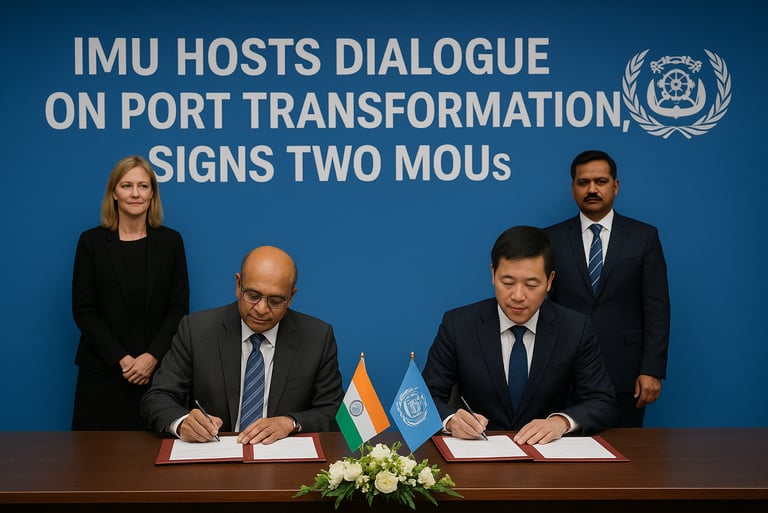

Visakhapatnam Port Emerges as India’s Top Seafood Export Gateway
30-August-25
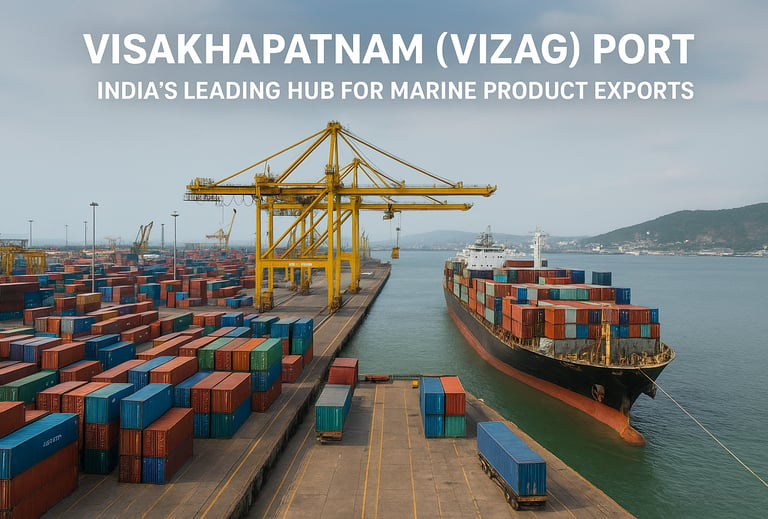

Visakhapatnam (Vizag) Port has become India’s leading hub for marine product exports, handling nearly 30% of the country’s seafood shipments in FY24–25, according to the Marine Products Export Development Authority (MPEDA).
Record Share in India’s Seafood Exports
Out of India’s total seafood exports worth $7.38 billion in FY24, Vizag Port accounted for $2.19 billion (29.72%).
In FY25, India’s seafood exports grew marginally to $7.45 billion, despite a fall in export volumes from 1.78 million tonnes (FY24) to 1.69 million tonnes (FY25), showing resilience driven by high-value products.
Frozen shrimp dominated, contributing $5.17 billion (69.46% of value, 43.67% of volume), followed by frozen fish ($622.6 million) and frozen squid ($367.68 million).
Export Markets
United States: Largest buyer, importing $2.71 billion, mainly frozen shrimp.
China: $1.27 billion
European Union: $1.12 billion
Southeast Asia: $975 million
Japan: $412 million
Middle East: $278 million
This wide market spread reflects India’s adaptability to global demand.
Port Infrastructure Driving Growth
Vizag Port’s seafood leadership is powered by:
Visakha Container Terminal Pvt Ltd (VCTPL): Deep-draft facility (16m), 600,000 TEU capacity, capable of handling mainline vessels and three ships simultaneously.
Strong connectivity: Integrated road and rail network enables swift movement from hatcheries and processing plants.
Cold chain strength: 650 reefer sockets with backup generators, 24 reefer sockets at inspection points, and real-time temperature monitoring (+/- 5°C).
Processing & Hatchery Ecosystem
Processing Plants (17) and Cold Storages operated by firms like Coastal Corporation, Snowman Logistics, and Devi Fisheries ensure international standards.
Exporters: Nekkanti Sea Foods, Devi Sea Foods, S.M. Sea Exporters, Sandhya Marines, Grand Marine, among others.
Hatcheries: Kanaka Maha Laxmi, BMR, VBC, Tappark, Sai Agro, ensuring high-quality shrimp and fish seed supply.
This ecosystem creates an integrated supply chain that sustains both volume and value in seafood exports.
Modernisation & Sustainability
The Visakhapatnam Port Authority has invested in:
Mechanised loading, automated warehouse management, digital cargo tracking, and real-time Customs support.
Eco-friendly measures: solar power, pollution control systems, sustainable practices to cut environmental footprint.
Quality compliance monitored by MPEDA, ensuring adherence to global food safety norms.
Growth Outlook
India ranks 3rd in fish production, 2nd in aquaculture, and 4th in seafood exports globally.
The government targets $14 billion seafood exports by 2030, with $1.6 billion from value-added products.
Key drivers: deep-sea fishing expansion, low-interest loans via Blue Revolution and Pradhan Mantri Matsya Sampada Yojana, and reduced import duties on shrimp/fish feed (Budget 2024–25).
Rising global demand for value-added seafood in the US, EU, Japan, and Asia is expected to fuel India’s next growth wave.
“With state-of-the-art facilities and strong exporter networks, Vizag Port is the backbone of India’s seafood trade and will continue to anchor the country’s growth in global seafood markets,” said Dr. Madhaiyaan Angamuthu, Chairman, Visakhapatnam Port Authority.
APM Terminals Pipavav Port Becomes India’s First Gateway for EV Exports
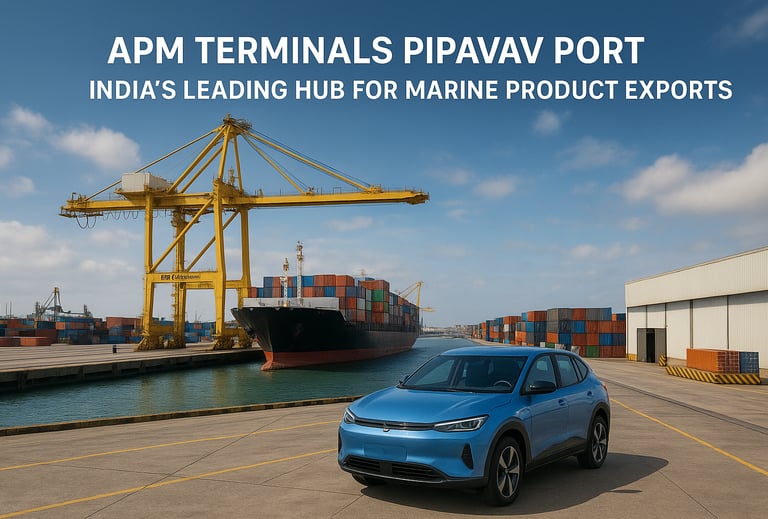

India has achieved a significant milestone in its electric vehicle (EV) journey as Prime Minister Narendra Modi inaugurated Maruti Suzuki’s new EV manufacturing facility in Gujarat and flagged off the first batch of domestically made EVs for international markets.
APM Terminals Pipavav Port has become the first Indian port to handle exports of Maruti Suzuki’s EVs, cementing its role in the country’s green mobility transition. In August 2025, the port successfully shipped 1,534 units of the eVITARA model to the United Kingdom and Germany, marking India’s entry into the global EV export market.
“This breakthrough shipment demonstrates that Pipavav is not just a cargo handling port but a key driver in India’s EV revolution—delivering innovation from Gujarat to the world,” the port authority stated.
The development underscores Pipavav’s strategic importance in enabling India’s ambition to become a global hub for sustainable manufacturing and exports. As the nation accelerates its shift to clean mobility, the port’s evolving logistics infrastructure is playing a pivotal role in building green supply chains that drive both economic growth and climate goals.
Flipkart Expands Supply Chain Network Ahead of Big Billion Days 2025
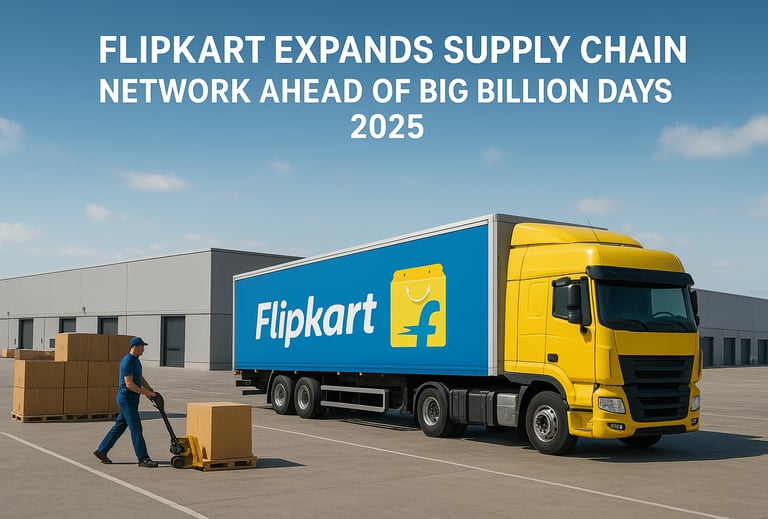

Flipkart, India’s homegrown e-commerce marketplace, has announced a massive expansion of its pan-India supply chain infrastructure, adding new fulfilment centres (FCs), regional hubs, and micro-fulfilment facilities to strengthen festive season deliveries and boost job creation.
Expansion Highlights
35 lakh sq. ft. expansion covering 21,000+ pincodes.
New facilities in Varanasi, Patna, Manesar, Ghaziabad, Agra, Ranchi, Agartala, Guwahati, Singur and Saidham.
Network now includes 100+ fulfilment centres nationwide.
Key Facilities
Varanasi FC: 2.0 lakh sq. ft., 3,600 jobs created.
Patna FC: 4.5 lakh sq. ft., serves 1,000+ pincodes, 1,100 jobs.
Manesar RDC: 140-acre state-of-the-art facility, 10,000+ jobs; caters to parcels, white goods, and furniture.
Agartala Grocery FC: 35,000 sq. ft., capacity of 5,000 daily orders (first in Northeast).
Job Creation & Inclusivity
2.2 lakh+ seasonal jobs in warehousing, logistics & last-mile delivery.
Focus on women, PwDs, and first-time workforce.
Supply Chain Operations Academy (SCOA) providing tech-led skilling.
Quick Commerce Push
Nearly 400 new micro-fulfilment centres & dark stores across 19 cities.
Supports Flipkart Minutes, which has doubled order volumes every 45 days.
Hemant Badri, SVP & Head of Supply Chain, Flipkart Group, said:
“Flipkart’s supply chain blends the scale of large fulfilment centers with the agility of hyperlocal hubs, creating a hybrid network that serves every corner of Bharat. Our 35 lakh sq. ft. expansion not only boosts delivery speed and reliability but also generates inclusive job opportunities at scale.”
Cochin Shipyard Begins Construction of Methanol-Ready Hybrid CSOV for Pelagic Wind Services
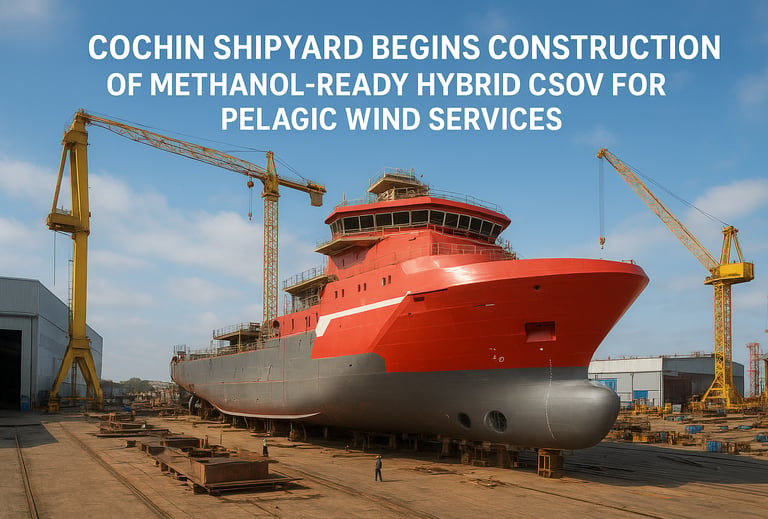

Cochin Shipyard has begun construction of the Pelagic Wahoo, a next-generation Commissioning Service Operation Vessel (CSOV) for Cyprus-based Pelagic Wind Services, part of Pelagic Partners. The keel-laying ceremony was led by Andre Groeneveld, CEO of Pelagic Wind Services.
The Pelagic Wahoo is the second in a series of advanced CSOVs for the company and is designed to be methanol-ready, positioning it as a key asset in greener shipping and renewable energy operations.
Vessel Highlights:
Dimensions: 93m length, 19.6m breadth
Design: Kongsberg UT 5520 MH, optimised for fuel efficiency, safety & sea-keeping
Capacity: 120 personnel including wind-farm technicians
Class: DNV comfort notation
Propulsion: Full hybrid system with permanent magnet azimuth thrusters
Sustainability: Large battery bank for near-zero emission port operations
The vessel will also feature advanced ship automation, next-gen deck machinery, bridge consoles, power systems, and monitoring technologies.
Cochin Shipyard said the project underscores its focus on innovation, sustainability, and international partnerships, further cementing its role as a premier builder of specialised, future-ready vessels.
Arunachal Pradesh Launches First Air Cargo Service from Donyi Polo Airport


Arunachal Pradesh marked a milestone on August 28 with the launch of its first outbound air cargo service from Donyi Polo Airport, aimed at strengthening the state’s agri-economy. Civil Aviation Minister Balo Raja flagged off the service under the theme “Empowering Farmers, Connecting Markets”, enabling faster movement of perishables and better market access for local producers.
Officials said the service will prioritise fruits, vegetables, flowers, and other perishable goods, helping reduce wastage and improve farmer earnings, particularly in remote districts.
During his visit, the minister also reviewed the airport’s new passenger terminal, built to handle 400 passengers at a time and equipped with modern amenities. The terminal is set for formal inauguration on September 2.
Commissioned in November 2022 by Prime Minister Narendra Modi, Donyi Polo Airport is Arunachal Pradesh’s first greenfield airport. The cargo service and terminal expansion fall under the Centre’s UDAN scheme, designed to boost connectivity and economic integration across the Northeast.
Hirasar Airport Processes First Cargo Shipment
29-August-25
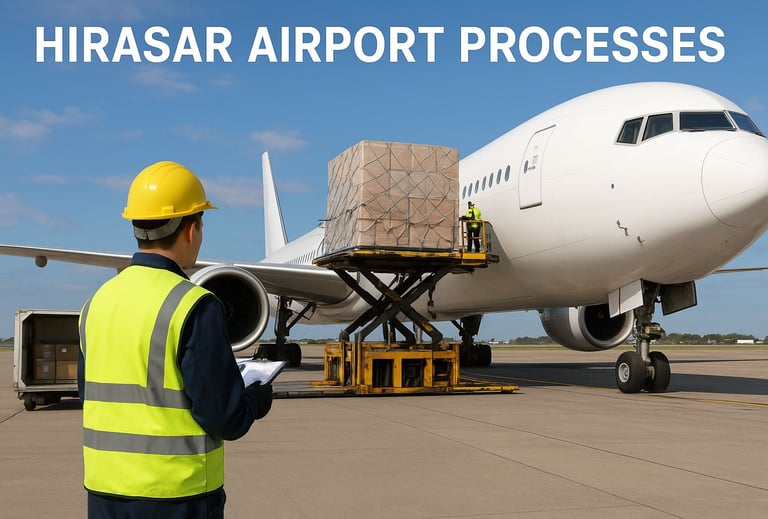

With its cargo terminal still under development, the Bureau of Civil Aviation Security (BCAS) granted temporary approval on July 23 for shipments to be routed through the passenger terminal, following persistent appeals from logistics companies and jewellery traders.
Rajkot’s newly built Hirasar Airport has now handled its first outbound cargo consignment, a 600 kg load of silver ornaments dispatched to Delhi via the passenger terminal—marking a significant milestone for the facility.
The maiden shipment was processed at night, and officials confirmed that cargo screening and clearance are currently scheduled only during nighttime hours. Consignments booked on daytime flights will also undergo checks overnight and be stored safely at the airport until departure.
Rajkot, a major jewellery hub, exports nearly 10,000 kg of silver, gold, and imitation ornaments daily across India. Industry representatives said the facility will help cut logistics costs and reduce theft risks compared to road transport once the cargo terminal becomes fully operational.
India to Target 40 Countries for Textile Export Diversification Amid U.S. Tariffs
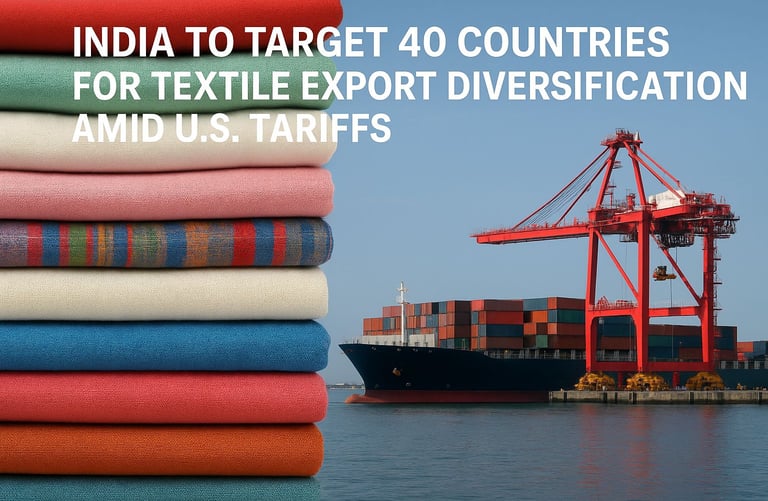

India is preparing a major push to diversify its textile exports by launching dedicated outreach programmes in 40 key importing nations such as the UK, Japan, South Korea, Germany, and Canada, according to officials.
The move comes after the U.S. imposed a 50% duty on Indian imports effective August 27, threatening more than $48 billion worth of exports across textiles, gems and jewellery, shrimp, leather, footwear, and machinery.
Although India exports textiles to over 220 countries, the top 40 markets—worth $590 billion globally—hold the greatest potential. India currently accounts for only 4.1–5% of global textile trade, leaving room for expansion.
The Commerce Ministry stated that the goal in these markets is to position India as a reliable source of quality, sustainable, and innovative textile products. Indian missions abroad, in partnership with export promotion councils (EPCs), will lead the effort.
India’s textile and apparel industry is valued at $179 billion (2024–25), with exports contributing $37 billion. EPCs will support the diversification drive through market mapping, demand identification, connecting hubs like Surat, Panipat, Tiruppur, and Bhadohi with buyers, and advising exporters on FTA benefits, sustainability norms, and certifications.
VOC Port Reports Strong Growth in LPG and Liquid Cargo Handling

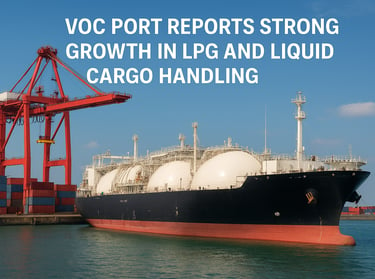
VOC Port in southern India has recorded robust growth in LPG handling during FY 2025–26. As of July, the Port processed 1,33,520 tonnes of LPG, reflecting a 40.01% increase over the 95,364 tonnes handled during the same period in FY 2024–25.
Over the last five years, LPG volumes have shown steady growth:
0.58 lakh tonnes (2020–21)
0.70 lakh tonnes (2021–22)
0.94 lakh tonnes (2022–23)
2.98 lakh tonnes (2023–24)
4.02 lakh tonnes (2024–25)
LPG operations are managed at the Oil Jetty, equipped with a 150-metre quay length and 13-metre draft, handling vessels of 150–230 metres LOA and up to 40,000 DWT. To boost capacity, the Port is upgrading the facility with new berthing dolphins, enabling it to handle vessels up to 55,000 DWT.
Key LPG operators include SHV Energy Pvt. Ltd., Indian Oil Corporation Ltd., Bharat Petroleum Corporation Ltd. (Tuticorin), and SHV Gas Supply & Risk Management.
Alongside LPG, VOC Port has also reported a rise in liquid cargo handling, with volumes increasing from 15.24 lakh MT in 2022–23 to 16.29 lakh MT in 2023–24, and 18.79 lakh MT in 2024–25. Cargo is handled across VOC Berths 1–7, 10, 17, and the Coastal Berth. Major companies include Greenstar Fertilizers, SPIC, DCW Ltd., K.T.V. Health Food Pvt. Ltd., and IOCL.
Chairperson Susanta Kumar Purohit, IRSEE, highlighted that this sustained growth reflects the Port’s commitment to supporting India’s energy and industrial needs, adding that upgrades to the Oil Jetty will further enhance operational efficiency for both smaller and larger vessels.
India Targets $1 Trillion Maritime Investments at Ambassadors’ Roundtable
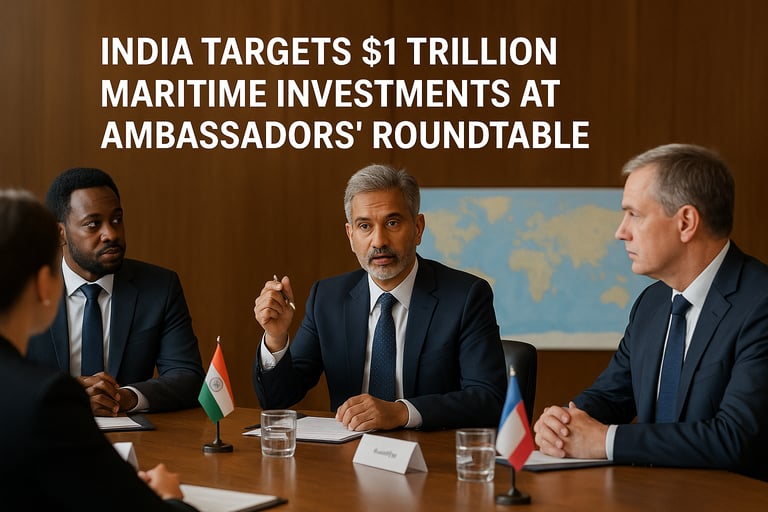

The Ministry of Ports, Shipping and Waterways (MoPSW) hosted the Ambassadors’ Roundtable Meet in New Delhi, bringing together envoys from 28 countries, senior officials, industry leaders, and multilateral representatives to set the stage for India Maritime Week (IMW) 2025, scheduled for October 27–31 in Mumbai.
The meeting, chaired by Union Minister Sarbananda Sonowal, positioned India as a global hub for maritime trade, sustainable shipping, and the blue economy. Sonowal invited global partners to participate in India’s $1-trillion maritime investment roadmap, covering ports, logistics, shipbuilding, and green energy.
Highlighting initiatives such as Maritime India Vision 2030 and Maritime Amrit Kaal Vision 2047, Sonowal said India’s shipping ecosystem is becoming resilient, sustainable, and future-ready.
A presentation by R. Laxmanan, Joint Secretary, MoPSW, showcased investment opportunities in:
Vadhavan Port, Galathea Bay Transhipment Port, Tuna Tekra Terminal
LNG bunkering and green hydrogen hubs
Shipbuilding, ship recycling, and maritime industrial parks
Key priorities discussed included:
Expanding shipbuilding capacity
Accelerating the transition to green shipping (hydrogen-powered and low-emission vessels)
Driving digitalisation in logistics for greater efficiency and transparency
Promoting IFSC-GIFT City as a hub for maritime financing
Delegates welcomed recent reforms, including five new legislations — the Bills of Lading Act, Carriage of Goods by Sea Act, Merchant Shipping Act, Coastal Shipping Act, and Indian Ports Act — which replace colonial-era laws and align India with global best practices.
“IMW 2025 will be a platform where ideas become projects and commitments turn into partnerships. India is ready to collaborate and lead towards a maritime future that is prosperous, sustainable and inclusive,” Sonowal stated.
The outcomes of the Roundtable will shape the agenda of IMW 2025, ensuring the event reflects global stakeholder priorities while advancing India’s ambition to become a leading maritime hub.
Vizhinjam Port Handles 1 Million TEUs in First Year
28-August-25
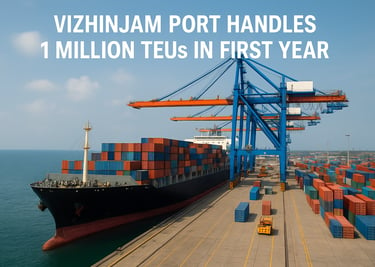

Kerala’s Vizhinjam International Seaport, India’s first transshipment hub, has crossed the 1 million TEU mark within its debut year of operations since December 2024.
Highlights:
456 vessel calls in year one.
18m+ natural draft, enabling handling of the world’s largest container ships.
Strategic location near global shipping lanes boosts transshipment potential.
Strong uptake from major international carriers.
State leaders hailed the milestone as proof of Kerala’s maritime vision, positioning Vizhinjam as both a logistics gateway and an engine for trade, jobs, and growth.
Industry experts say the rapid scale-up reflects global confidence, strengthening Vizhinjam’s role as a future transshipment hub for South Asia.
Vande Bharat Parcel Train to Launch in Two Months
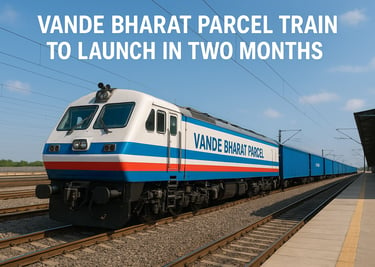

Indian Railways will roll out its first Vande Bharat parcel train within two months, with the inaugural service planned on the Mumbai–Kolkata corridor.
Key features:
16 coaches, cargo capacity of 264 tonnes.
Max speed: 160 kmph; Avg operating speed: 90 kmph (vs. current 50 kmph for goods trains).
Aimed at high-value, time-sensitive cargo like processed foods, offering a faster and more economical alternative to air freight.
The train, under development at Integral Coach Factory (ICF), Perambur, will undergo RDSO inspections next month. Businesses signing long-term parcel contracts will receive discounted rates.
Adani Dhamra Port Dispatches First Steel Slab Rake to Jindal Stainless
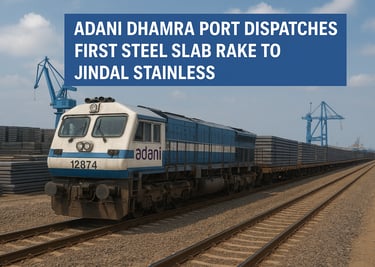

Adani Dhamra Port has achieved a key milestone with the dispatch of its first steel slab rake, reinforcing its position as a reliable hub for bulk and industrial cargo.
The operation handled:
35,000 MT of imported premium steel slabs via M.V. HTK Neptune.
2,900+ MT (133 slabs) loaded into 45 BFNS wagons.
Cargo destined for Jindal Stainless Ltd’s Kalinganagar plant.
The port executed the complex movement within schedule, ensuring timely delivery and strengthening supply chain linkages for India’s manufacturing sector.
Adani Ports said the achievement highlights its operational efficiency and commitment to supporting India’s industrial growth.
MSC to Launch New North India–Middle East Shipping Service in September
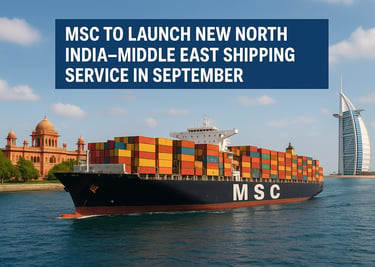

Mediterranean Shipping Company (MSC) will roll out a new weekly shipping service connecting North India and the Middle East from late September 2025, aimed at strengthening trade connectivity and offering exporters and importers more direct and reliable transport options.
Service Highlights:
Deployment: Three vessels of about 2,500 TEU capacity each.
Port Rotation: Hazira – Mundra – Nhava Sheva (India) – Sohar (Oman) – Abu Dhabi (UAE) – Dammam (Saudi Arabia) – Hazira.
The inclusion of King Abdulaziz Port in Dammam, equipped with 43 berths and a handling capacity of 105 million tons, will significantly boost regional trade flows and reinforce its role as a major Middle East hub for both regional and international shipping.
MSC’s new loop is expected to enhance supply chain efficiency and give Indian shippers better access to Gulf markets.
Ahmedabad Airport’s New Cargo Terminal Grabs 70% Market Share Within a Month
26-August-2025
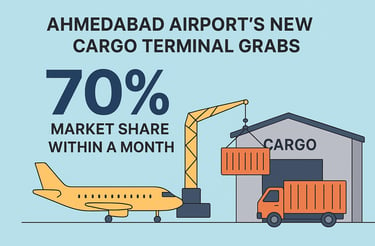

Barely a month after becoming operational, the new Integrated Cargo Terminal (ICT) at Ahmedabad airport has captured nearly 70% of the city’s international cargo traffic, handling about 5,000 metric tonnes (MT) along with a similar volume of domestic freight.
Spread across 21,000 sq m with plans to expand to 33,000 sq m, the facility has already drawn major airlines such as Air India, Emirates, Qatar Airways, and Singapore Airlines, while Blue Dart and SpiceJet will commence operations shortly.
In FY25, Ahmedabad airport handled 60,000 MT of cargo across domestic and international trade, with 20,000 MT moved between April–July this fiscal. The ICT is now poised to significantly boost volumes, with projections of scaling up to 200,000 MT monthly capacity once fully operational.
The facility offers seamless connectivity, faster turnaround times, and compliance with global safety standards, catering to perishables, pharmaceuticals, courier shipments, and engineering goods. Industry experts highlight that the timing is crucial for Gujarat’s export-driven economy, given the state’s strong base in pharmaceuticals, chemicals, textiles, and engineering goods.
India–Bangladesh Set to Launch Direct Coastal Shipping Link

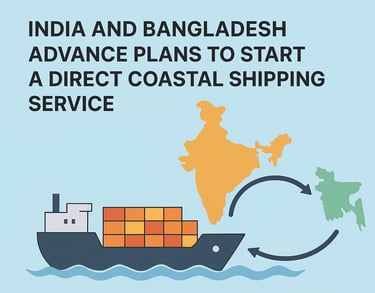
India and Bangladesh are advancing plans to start a direct coastal shipping service to reduce logistics costs and speed up bilateral trade.
A Bangladesh Ministry of Shipping delegation, led by Commodore Jubair Ahmed, recently inspected Paradip, Visakhapatnam, and Haldia ports in India to assess capacity and infrastructure for the proposed route. Discussions with Paradip Port Trust focused on cargo handling capabilities and future expansion.
Currently, most cargo between the two countries is transshipped via Singapore or Colombo, adding cost and time. Direct shipping is expected to cut freight costs, reduce transit times, and strengthen trade flows.
The initiative was first proposed in July 2025 during talks to renew the Protocol on Inland Water Transit and Trade (PIWTT), in effect since 1972. India has agreed in principle and will soon send a delegation to Chittagong and Mongla ports for reciprocal studies.
Bangladesh will need to upgrade its fleet—out of nearly 2,000 vessels, only about 80 meet international standards for overseas operations.
Trade is on the rise: Bangladesh imports around $4.5 billion worth of goods from India annually, while exports, led by garments, have climbed to $1 billion.
With Paradip Port handling 76 million tonnes annually (targeting 237 MT by 2030) and Chittagong Port at 45 MT, the service is expected to significantly enhance direct maritime connectivity, reducing reliance on third-country hubs like Singapore.
Unifeeder Resumes Egypt–Syria Service, Expands Mediterranean Reach


Unifeeder will restart its Egypt–Syria service in September 2025, restoring a key Eastern Mediterranean trade link. The relaunch aims to reestablish vital cargo flows, cut transit times, and boost regional supply chain connectivity.
The announcement follows Unifeeder’s July launch of its India–Mediterranean service, connecting Nhava Sheva and Mundra with East Port Said, Alexandria, and Turkish ports, catering to both dry and reefer cargo.
Unifeeder has been aggressively expanding across the Mediterranean. According to Alphaliner, the carrier tripled its regional market share in 2024 to 4.3%, the fastest growth among operators. Its fleet now includes 20 vessels (24,000 TEU capacity), matching COSCO’s footprint, with seven new services and 10,600 TEUs of fresh capacity added in the past year.
The Egypt–Syria relaunch underlines Unifeeder’s strategy to build stronger intra-Mediterranean trade networks, offering reliable schedules and enhanced regional connectivity.
Govt Plans ₹25,000 Cr Export Promotion Mission to Boost Trade Competitiveness

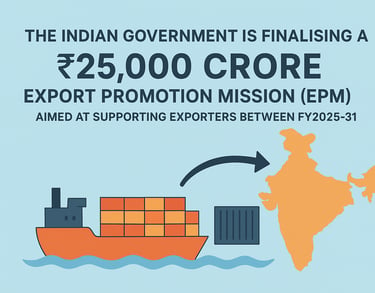
The Indian government is finalising a ₹25,000 crore Export Promotion Mission (EPM), aimed at supporting exporters between FY2025–31. The proposal has been submitted to the Expenditure Finance Committee (EFC) and will be placed before the Union Cabinet for approval.
The EPM will run through two schemes:
Niryat Protsahan (₹10,000+ crore): Interest equalisation, new financing tools such as an export credit card for e-commerce exporters, and liquidity support for MSMEs.
Niryat Disha (₹14,500+ crore): Export quality & compliance support, global branding, warehousing & logistics investment, skill-building, and integration into global value chains.
The mission will be implemented with support from the Commerce Department, MSME Ministry, Exim Bank, ECGC, CGTMSE, NCGTC, EPCs, and state governments.
Officials said the package will expand affordable trade finance access, particularly for MSMEs, while opening new global market opportunities.
India’s exports grew 7.29% in July 2025 to $37.24 bn, though the trade deficit hit an eight-month high of $27.35 bn. Analysts say the EPM will be crucial in helping Indian exporters withstand rising global tariff pressures and sustain growth momentum
Kerala to Float Tender for ₹1,483 Cr Vizhinjam–Balaramapuram Rail Link in September


The Kerala government will issue a tender next month for the Vizhinjam–Balaramapuram rail tunnel project, aimed at linking Vizhinjam International Seaport with the railway network. Draft tender documents, prepared by Konkan Railway Corporation Ltd (KRCL), were reviewed at a high-level meeting with state officials and Vizhinjam International Seaport Ltd (VISL). Final consultations will be held in early September before the tender is released.
The ₹1,483 crore EPC project will feature a 10.7 km alignment, including 9.4 km of tunnels built with the New Austrian Tunnelling Method (NATM), reaching depths of 25–30 metres. Trains will take around 36 minutes to cover the stretch at 15–30 km/h.
The rail link will provide Vizhinjam access to hinterland markets in Tamil Nadu, Karnataka, Andhra Pradesh, and Telangana, enhancing cargo connectivity. However, land acquisition delays remain a key challenge. Construction is expected to begin in 2026 and finish by end-2028.
Union Minister of Ports, Shipping and Waterways Sarbananda Sonowal announced that the Ministry is exploring the launch of a dedicated satellite or acquisition of a transponder to strengthen India’s maritime governance and port management infrastructure.
Speaking on National Space Day, Sonowal said the initiative would enable real-time monitoring of vessel traffic, enhance navigational safety, improve search-and-rescue and disaster response, and reduce dependence on foreign navigation systems, aligning with the Atmanirbhar Bharat vision.
He highlighted that the system would provide exclusive coverage of coastal waters, inland waterways, and ports, integrating with national maritime databases.
Recalling India’s achievements in space—from Aditya-L1 to the upcoming Gaganyaan mission—Sonowal lauded the country’s rise as a global leader in space technology and urged youth to “reach out not just to the sky but to space.”


Shipping Ministry to Explore Satellite Solutions for Maritime Sector: Sonowal
25-August-2025
CM Inaugurates Adani Logistics Park in Kochi; Flipkart Secures 30 Acres
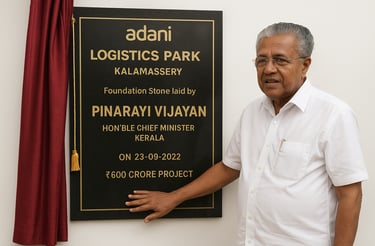

KOCHI: Kerala Chief Minister Pinarayi Vijayan on Saturday laid the foundation stone for the Adani Logistics Park at Kalamassery, a ₹600-crore project by Adani Ports and Special Economic Zone (APSEZ). The 70-acre park, located between HMT and Government Medical College, will see Flipkart acquire 30 acres for its operations.
The park is expected to boost industrial and logistics growth by reducing transportation costs, enabling just-in-time operations, and enhancing export capabilities across sectors like e-commerce, FMCG, pharmaceuticals, automotive, and retail. It will also integrate sustainable practices, including EV charging stations and smart logistics solutions.
Highlighting Kerala’s progress in ease of doing business, Vijayan said such projects would transform the state into an international industrial hub, generating over 13 lakh job opportunities. He noted that the state has already attracted ₹23,000 crore investments and 7.5 lakh jobs under the Investor’s Year initiative.
Shipping Through Drake Passage Faces New Concerns After Earthquake

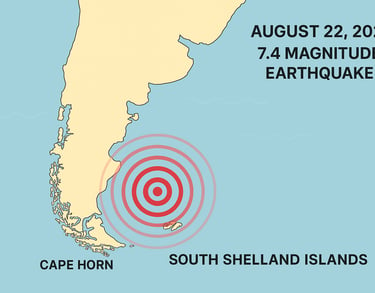
On August 22, 2025, a 7.4-magnitude earthquake struck the Drake Passage, a critical maritime route between Cape Horn and the South Shetland Islands. The tremor, recorded at a depth of 36 km, raised initial tsunami warnings for Antarctic bases, though no widespread threat was confirmed.
The Drake Passage is the shortest sea route between the Atlantic and Pacific Oceans, but it is also notorious for extreme conditions that challenge global shipping. Its narrow geography funnels immense winds and currents, generating storms and waves that can reach 80 feet (25 meters). Sailors often describe the violent rolling and pitching here as the “Drake Shake.”
Even with modern vessels, crossings typically take about 48 hours, and storms can make navigation hazardous, disrupting cargo schedules and endangering smaller ships. The latest earthquake adds another layer of uncertainty for vessels transiting this volatile corridor, as seismic events may influence ocean conditions and maritime safety protocols.
China Backs India, Slams U.S. Tariffs as ‘Bullying’
24-August-2025
China has voiced strong opposition to U.S. President Donald Trump’s decision to double tariffs on Indian goods, with envoy Xu Feihong calling the move “bullying” that undermines global trade. Speaking at a conference on India-China relations, Xu said Beijing will firmly support New Delhi in defending multilateral trade under the WTO framework, stressing that “silence or compromise only emboldens the bully.”
Xu highlighted Prime Minister Narendra Modi’s upcoming visit to China for the Shanghai Cooperation Organisation (SCO) Summit as highly significant, saying both nations act as “double engines” of Asia’s economic growth and should safeguard international justice amid global trade disruptions.
The envoy invited more Indian commodities into China, citing India’s strengths in IT, software, and biomedicine, while pointing to China’s growth in manufacturing, infrastructure, and new energy. He also urged India to provide a fair business environment for Chinese enterprises to promote mutual industrial development.
On the border issue, Xu emphasized a long-term view, stating that cooperation and territorial concerns should advance in parallel. He revealed that a 10-point consensus was reached during Chinese Foreign Minister Wang Yi’s visit to India.
Addressing concerns about terrorism, Xu said Pakistan is also a “victim of terrorism,” calling for joint efforts to counter the threat. On U.S. trade measures, he argued that Washington, having long benefited from free trade, is now misusing tariffs as a bargaining chip to extract concessions.
Xu reiterated that China places great importance on Modi’s upcoming Tianjin visit (Aug 31–Sep 1) for the SCO Summit, expressing confidence that it will be “a successful visit.”

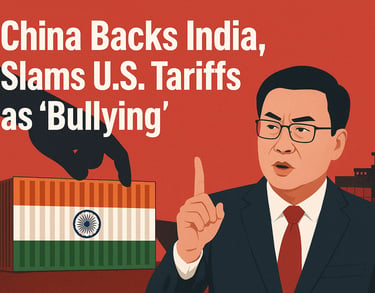
Indian Exports to China Jump 20% in April–July FY26, Marking Strong Rebound
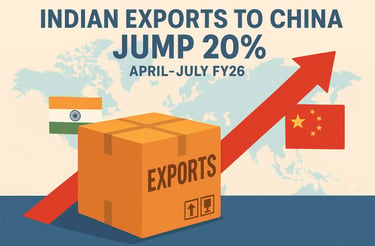

India’s merchandise exports to China surged 20% year-on-year to $5.76 billion in April–July FY26, compared with $4.80 billion a year earlier, official data shows. The rebound—driven by energy, electronics, and agricultural shipments—follows a sharp 14.5% contraction in FY25, when exports fell to $14.25 billion.
Sector highlights:
Energy products: Petroleum exports nearly doubled to $883 million (+95.3%).
Electronics: Surged 202.7% to $521 million.
Agriculture: Oil meals (+2656.1%), rice (+1383.3%), and oil seeds (+1791.7%) posted extraordinary gains.
Chemicals & others: Organic/inorganic chemicals (+16.3%), spices (+21.9%), tea (+93.9%), gems & jewellery (+72.7%).
Moderate growth: Marine products (+5.1%), ores (+3.0%), garments (+14.8%).
The upswing comes amid positive diplomatic engagement—including Chinese Foreign Minister Wang Yi’s August 19 visit to New Delhi, where both nations agreed to expand trade, reopen border trade routes, and boost investment.
While India still faces a $99.2 billion trade deficit with China (FY25), sustained FY26 growth could help narrow the gap.
CMA CGM Accelerates €200 million Expansion at Latakia Port
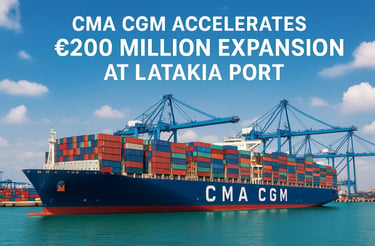

CMA CGM has accelerated the second phase of Latakia Port’s redevelopment, committing €200 million ($231 million) under a renewed 30-year concession signed on May 1, 2025. This follows an initial €30 million upgrade already underway.
The project will expand the Latakia International Container Terminal (LICT) — which handles 95% of Syria’s containerised trade — into a regional hub, with:
Capacity boosted beyond 1 million TEUs annually
16m-deep berths for larger vessels
Modern cargo equipment & digitalised operations
Improved rail/road connectivity & nationwide dry ports
The expansion underlines CMA CGM’s global logistics strategy while supporting Syria’s trade recovery. The carrier also announced an upgrade of its NEFWI (PCRF) service from Jan 2026 to strengthen regional links.
Vijay Kumar Appointed Secretary, Ministry of Ports, Shipping and Waterways


The Central Government has appointed Vijay Kumar, a 1992-batch IAS officer of the AGMUT cadre, as the next Secretary in the Ministry of Ports, Shipping and Waterways. He will assume charge on October 1, succeeding T. K. Ramachandran, who retires a day earlier. Until then, Kumar will serve as Officer on Special Duty (OSD).
Currently the Chairman of the Inland Waterways Authority of India, Kumar has played a key role in expanding and modernising the country’s inland water transport. Over his career, he has held senior positions in Delhi, Lakshadweep, and other Union Territories, covering sectors such as power, water supply, trade, and transport.
A Delhi native, Kumar holds a degree in Electronics Engineering, an MBA in Economic Development from MIT, and a Diploma in Business Finance.
Kandla Port Clears ₹3,500 Cr E-Methanol Project to Become Bunkering Hub
23-August-2025
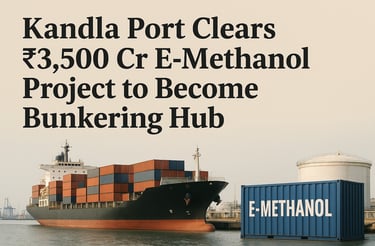

The Deendayal Port Authority (DPA), Kandla has approved a ₹3,500 crore e-methanol project to position the port as a key bunkering hub on the busy Rotterdam–Singapore route.
DPA Chairman Sushil Kumar Singh said the port will supply e-methanol as bunker fuel, with demand projected from nearly 200 ships by 2030.
The initiative aligns with global efforts to decarbonize shipping, supporting the Rotterdam–Singapore Green and Digital Shipping Corridor, which promotes the use of low- and zero-carbon fuels such as e-methanol and bio-methanol.
Shipping Set for Boost under Infrastructure status in India

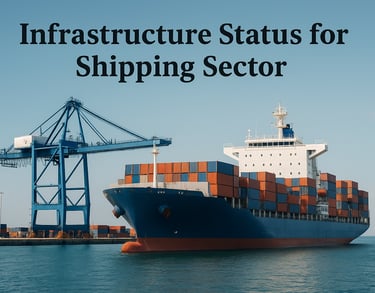
The Government of India is set to grant infrastructure status to the shipping sector, with a notification expected in the coming weeks. This will give shipowners access to long-term, low-cost financing, enabling expansion of fleets and boosting orders for Indian shipyards.
Unlike traditional infrastructure projects, the classification will be based on vessel size, with ships 24 metres or longer qualifying. Repayment schedules are expected to match ships’ 12–15-year lifespan, reducing financial pressure on owners.
Industry experts say the move will strengthen both coastal and international fleets, support domestic shipbuilding, and complement initiatives such as the Ship Building Financial Assistance Policy, the proposed ₹25,000-crore Maritime Development Fund, and green vessel incentives.
Officials highlight this as a strategic step toward India’s 2047 goal of becoming a top-five global player in shipping and shipbuilding, while advancing self-reliance and competitiveness.
Haldia Dock Complex to Begin Direct Container Service to Chittagong
AP Maritime Board, APM Terminals ink ₹9,000 crore port development pact
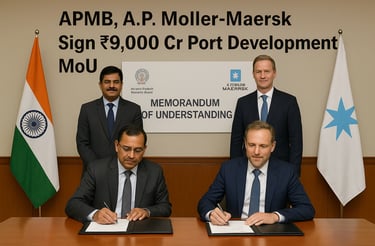

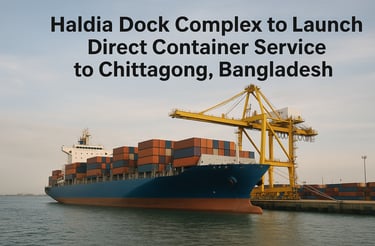

The Haldia Dock Complex (HDC) will launch a direct container vessel service to Chittagong, Bangladesh, strengthening cross-border trade and logistics. Operated by CJ DARCL and represented in India by Everett India Pvt Ltd, the inaugural vessel is scheduled to dock at HDC on August 30, 2025.
The service promises faster cargo movement, reduced turnaround times, and greater trade opportunities between the two nations. HDC officials have urged exporters and importers to leverage this initiative to boost regional connectivity and enhance maritime competitiveness.
The Andhra Pradesh Maritime Board (APMB) has signed an MoU with APM Terminals, a unit of A.P. Moller–Maersk, to develop the Ramayapatnam, Machilipatnam, and Mulapeta ports with an investment of ₹9,000 crore. The agreement, signed in the presence of Chief Minister N. Chandrababu Naidu, aims to build modern terminals, advanced cargo-handling systems, and create nearly 10,000 direct jobs.
Naidu said Andhra Pradesh will be developed as India’s “eastern gateway” for maritime trade, with ports integrated into a robust logistics ecosystem spanning road, rail, waterways, and air connectivity. The state also plans to establish a port or harbour every 50 km along its 1,000-km coastline to strengthen trade and connectivity for neighbouring states.
India, Russia Deepen Trade Ties Amid U.S. Tariff Threats
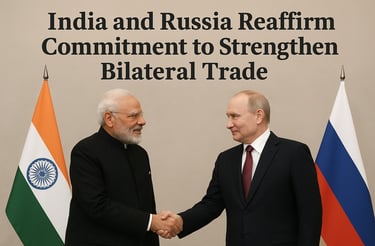

India and Russia have reaffirmed their commitment to strengthening bilateral trade, signaling that U.S. tariff pressure over New Delhi’s Russian oil imports will not derail the partnership.
At a joint press conference in Moscow, Indian Foreign Minister S. Jaishankar highlighted the resilience of India-Russia ties since World War II, noting plans to expand exports of pharmaceuticals, agriculture, and textiles to address the trade imbalance. Bilateral trade hit a record $68.7 billion in FY2024-25, though India faces a $59 billion deficit due to heavy oil imports.
India will also send workers skilled in IT, construction, and engineering to help Russia meet labor shortages. Russian Foreign Minister Sergei Lavrov stressed progress in hydrocarbon cooperation and joint projects in the Far East and Arctic shelf, calling the partnership vital for regional stability.
Despite Western criticism that India’s Russian oil imports fund Moscow’s war in Ukraine, New Delhi maintains its purchases are aimed at stabilizing markets, pointing to continued U.S. and EU trade with Russia.
The Russian embassy in India confirmed oil shipments will continue despite U.S. pressure and hinted at a potential India-Russia-China trilateral meeting. Analysts noted that U.S. tariff threats may push India closer to Russia and China rather than weaken ties.
India is now the second-largest buyer of Russian oil, importing 1.6 million barrels per day in early 2025, up sharply from 50,000 bpd in 2020, though still behind China’s 2 million bpd.
Meanwhile, U.S. officials have accused India of profiteering from cheap Russian crude while sparing China from secondary tariffs. Experts argue Washington’s moves are driven more by leverage in trade negotiations with New Delhi and pressure on Moscow over Ukraine than by curbing Russian oil revenues.
India, Saudi Arabia Set Up Joint Working Group on Maritime Cooperation
22-August-2025
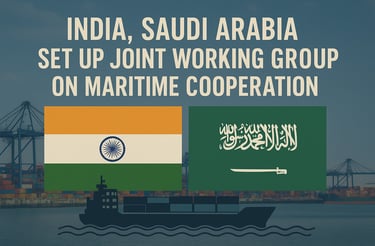

India and Saudi Arabia have agreed to establish a Joint Working Group (JWG) to boost collaboration in shipping, ports, and logistics.
The decision followed a virtual meeting between India’s Ports, Shipping & Waterways Minister Sarbananda Sonowal and Saudi Arabia’s Transport & Logistics Minister Saleh bin Nasser Al-Jasser.The JWG will serve as a platform to strengthen maritime trade, port infrastructure, and logistics cooperation, marking a key step in expanding strategic ties between the two nations, which already maintain strong links in energy and trade.
India Expands Export Focus to 50 Markets Amid US Tariff Pressure
Facing higher US tariffs, India is broadening its export strategy by expanding its focus markets from 20 to 50, covering 90% of total exports.
The new additions—including Kenya, Spain, South Africa, Mexico, Sri Lanka, Egypt, Belgium, and Nigeria—already make up 30% of exports and offer strong growth potential in both volumes and product range.
The move follows a 20% surge in July shipments to the US, as exporters rushed orders before Washington’s 25% tariff kicked in on August 2. Officials expect diversification to cushion the impact of slowing exports to India’s largest market.
Between April–July 2024, exports to 26 of 40 focus markets rose to $91.5 billion, highlighting early success. Meanwhile, trade diplomacy is advancing with the India–EFTA FTA (effective Oct 1) and the upcoming India–UK FTA.
The government will also soon launch the Export Promotion Mission (2025–2031) to strengthen export finance, compliance, branding, logistics, and global value chain integration.
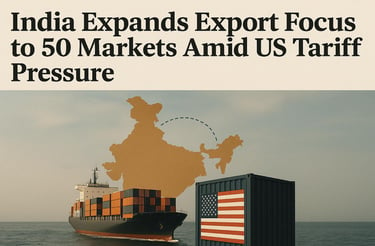

Kashmir-Delhi Cargo Train to Boost Apple & Pashmina Trade
The Railway Board has approved a daily cargo train from Budgam (Kashmir) to Adarsh Nagar (Delhi) to accelerate the movement of J&K’s apples, Pashmina, and other traditional products.
Operated by Northern Railways’ Jammu Division, the train will have eight parcel vans and an SLR coach, with loading facilities at Bari Brahmana (Jammu). Security during the pilot phase will be managed by J&K Police.
The service offers a 23-hour transit time—faster and cheaper than road transport—and traders are exempted from registration charges.
Officials said the initiative will give local producers direct access to key markets, cut logistics costs, and strengthen the presence of J&K products in both domestic and global markets.
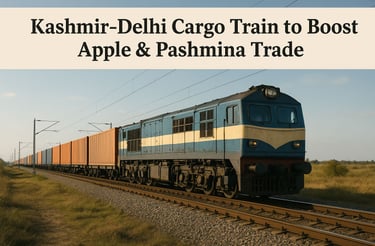

Deendayal Port Authority Launches Training on Methanol Bunkering

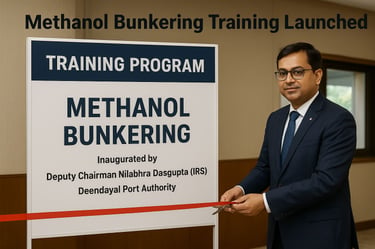
Deputy Chairman Nilabhra Dasgupta (IRS) inaugurated a two-day training program on methanol bunkering at Deendayal Port Authority (DPA), held under the Deendayal Kaushal Vikas Program in collaboration with Gandhidham Collegiate Board.
The initiative aims to equip the maritime workforce with clean-fuel skills, supporting India’s Green Maritime Vision and preparing for future-ready bunkering operations.
Rubio Defends US Tariffs on India, Spares China Over Russian Oil
18-August-2025

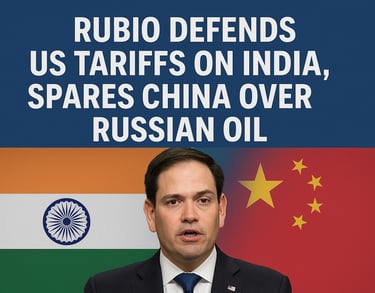
US Secretary of State Marco Rubio defended President Trump’s decision to impose 50% tariffs on India over Russian oil imports, while sparing China, the largest buyer of Russian crude. Rubio argued that sanctioning Beijing could disrupt global markets and push energy prices higher, since China refines and re-exports Russian oil.
The move has strained US-India ties, with New Delhi calling the tariffs “unjust and unreasonable” and vowing countermeasures. Critics accuse Washington of hypocrisy, as China avoids penalties while India faces some of the steepest US tariffs.
COSCO Leads Far East–India/Middle East–Red Sea Trade Lane

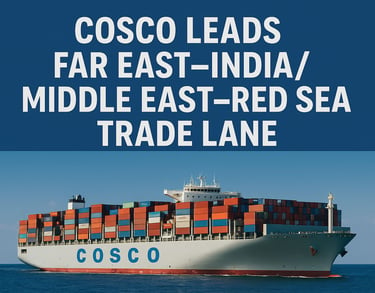
A review by Alphaliner shows that Asian shipping lines dominate capacity on the Far East–India/Middle East–Red Sea corridor, while European carriers play a smaller role, often limited to mainline services.
COSCO Group, including COSCO Shipping and OOCL, holds the top position with around 250,000 TEU deployed, equal to 12.7% of the trade’s total slots. COSCO is also the only carrier operating Megamax vessels (19,000 TEU) in this route, with its MEA5 service under the OCEAN Alliance deploying five such ships.
On the European side, MSC (8.8%) and CMA CGM (8.5%) are the leading players. CMA CGM stands out as one of the few mainline operators still offering dedicated Far East–Red Sea services, deploying mid-sized vessels of 3,700–8,500 TEU on its REX2 service.
Surprisingly, Maersk, despite being the world’s second-largest container line, only accounts for 4% of slots, ranking ninth in this corridor. Its Gemini partner, Hapag-Lloyd, has an even smaller footprint at 1.6%, placing it 19th overall.
The analysis underlines how Asian operators, led by COSCO, dominate trade in this critical east-west corridor, while European carriers lag behind, focusing their main capacity elsewhere.
Southern Tamil Nadu Rising as South India’s Export Hub
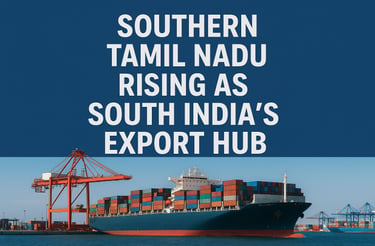

Southern Tamil Nadu is emerging as a major industrial and export powerhouse, backed by Rs 30,100 crore MoUs signed at a recent investors’ conference, promising 46,450 jobs. MSMEs pledged another Rs 1,261 crore with 1,000 jobs. The launch of VinFast’s EV plant in Thoothukudi has set the tone, alongside other projects across Tirunelveli, Kanniyakumari, Virudhunagar, Tenkasi, and Madurai.
Key projects include:
RGE (Singapore): Rs 4,953 crore man-made fibre facility, Thoothukudi
Hwaseung (South Korea): Rs 1,720 crore footwear plant, Tirunelveli
Thoothukudi: 250-acre space park, shipbuilding unit, moringa export hub, zonal agri export unit
Logistics upgrades: Multi-modal logistics parks (Madurai & Thoothukudi), new air cargo complex
Shipping dynamics are shifting too. VOC Port (Thoothukudi) and Adani Vizhinjam Port (Kerala) are competing yet complementary hubs. Vizhinjam, with its 20m draft, handled 395 ships & 840,000 TEUs in under a year, including mega vessels. Expansion phases worth Rs 10,000 crore will triple capacity, but weak hinterland industries mean it must draw cargo from Tamil Nadu and Karnataka.
Meanwhile, VOC Port is pushing for the Rs 7,055 crore Outer Harbour Project after the Enayam port cancellation. It has deepened berths to 14.2m and expanded storage, though still relies heavily on transshipment (95% via Colombo, 5% via Vizhinjam).
Experts say Vizhinjam’s location near the Suez–Far East route can cut costs and reduce reliance on Colombo, while VOC Port’s strong hinterland industries provide resilience. Rising investments, improved logistics, and growing port capacity are firmly positioning southern Tamil Nadu as South India’s next export hub.
Concor Diversifies into Cement, Liquid Cargo, and Steel to Boost Growth
17-August-2025


Container Corporation of India (Concor) is diversifying beyond containerized cargo into bulk cement, liquid chemicals, and steel to counter slowing domestic volumes.
The PSU has ordered 1,000 bulk cement tank containers to tap India’s 70–80 million tonne loose cement market, still dominated by road transport. It is also in talks with JK Cement, UltraTech, Tata Group, and SAIL for cement and steel shipments.
In Q1 , EXIM volumes rose 12% to 1.29 million TEUs, though domestic growth was muted. Margins improved to 27%, aided by higher double-stack rakes and lower empty runs.
The Western Dedicated Freight Corridor, set to connect JNPT by December, is expected to give a major boost to rail freight. Concor also signed an MoU with Dubai’s RHS Group for end-to-end logistics, with plans to expand into Singapore.
By 2028, the company aims to operate 100 terminals, 500+ rakes, and 70,000 containers.
World’s Largest Cruise Ship Fueled with LNG at Port Canaveral
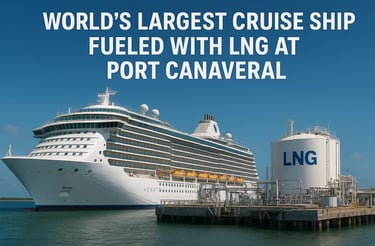

Port Canaveral carried out the first LNG bunkering of Star of the Seas, Royal Caribbean International’s newest and world’s largest cruise ship, on August 14—two days before its maiden voyage.
The seven-hour operation was handled by Seaside LNG’s bunker barge Clean Everglades, supported by JAX LNG and Pivotal LNG, with strict safety monitoring by Canaveral Fire Rescue, U.S. Coast Guard, and local marine units.
Running fully on LNG, Star of the Seas offers major environmental benefits—eliminating SOx emissions, cutting NOx by 85%, particulate matter by 95%, and CO₂ by up to 20%. Built at Finland’s Meyer Turku shipyard, the vessel is part of Royal Caribbean’s Icon class and central to its “Destination Net Zero” strategy.
After bunkering, the ship embarked on its maiden voyage on August 16 and will begin weekly Caribbean and Bahamas cruises from August 31.
Govt to Expand Maritime Development Fund to ₹70,000 Cr

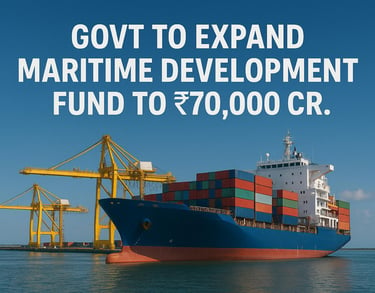
The government is set to scale up the Maritime Development Fund (MDF) to ₹70,000 crore—nearly three times the February Budget allocation—to accelerate growth in shipbuilding, ship repair, port-linked infrastructure, and shipping tonnage. The proposal has been cleared by the Expenditure Finance Committee, with Cabinet approval expected soon.
The MDF will adopt a blended finance model, with 49% concessional capital from the government and major ports, and 51% from commercial lenders, sovereign funds, and multilateral agencies. It will provide long-term, low-cost financing tailored to different investors.
India’s maritime sector will need an estimated $885–940 billion in investment by 2047, including $388 billion for tonnage, $260 billion for green vessels, and $224 billion for next-gen ports.
The recent passage of four key maritime bills and clearance of the Indian Ports Bill signal major reforms. The government is also revamping shipbuilding incentives, offering subsidies of up to 25% for green vessels, and granting infrastructure status for large ships.
India targets a top 10 global shipbuilding rank by 2030 and top 5 by 2047, competing with China, South Korea, and Japan. Experts stress the need for rapid infrastructure expansion and stronger financial support to achieve these goals.
Paradip Port Retains Cargo Handling Crown for 2nd Year
16-August-2025
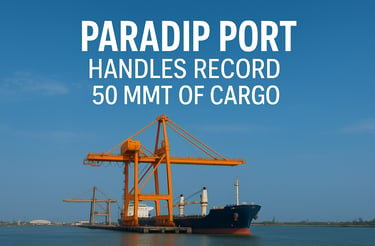

Paradip Port, Odisha’s only major port, has maintained its top position in cargo handling for the second straight year, handling a record 50 MMT of cargo by July 2024—the fastest in its history. Chairman P.L. Haranadh credited the milestone to employee resilience and strategic initiatives.The port has also begun container trade for the first time, with MSC and RCL services and CONCOR’s multimodal logistics park strengthening Paradip’s role as an eastern India container hub. It is also partnering with MPEDA to boost seafood exports.
Looking ahead, Paradip targets 500 MMTPA capacity by 2047, with the 25 MMTPA Western Dock Project enabling Capesize vessel calls and lower logistics costs. Modernization plans include 100% mechanization by 2030, AI-driven harbour management, and an advanced Vessel Traffic Management System.Aligned with India’s net-zero goals, the port is developing a ₹50,800 crore green hydrogen/ammonia terminal, shore-to-ship power, a green tug, and a 10 MW solar plant to raise renewable energy use to 60%. Paradip aims to be a net-zero port by 2050.
SCI Adds LPG Carrier Sahyadri to Boost Energy Shipping Self-Reliance


The Shipping Corporation of India (SCI) has inducted Sahyadri, a Very Large Gas Carrier (VLGC), into its fleet, reinforcing India’s self-reliance in transporting liquefied petroleum gas (LPG). Built in South Korea, the 225-metre-long vessel has a capacity of 82,000 cubic metres.
With this addition, SCI’s fleet now stands at 57 vessels with a combined deadweight tonnage of 5.2 million tonnes. Sahyadri will mainly operate between the Persian Gulf and Indian ports to ensure secure LPG supplies. A second VLGC, Shivalik, is expected later this financial year.
The move aligns with India’s goal of reducing reliance on foreign-flagged ships and strengthening its maritime competitiveness. Union Minister Sarbananda Sonowal said the induction marks another step toward building an Atmanirbhar maritime India and achieving the 2047 vision of becoming a leading global shipping nation.
Trump Acts to Safeguard Supply of Essential Medicines
15-August-2025


U.S. President Donald Trump has signed an executive order to strengthen the supply chain for essential medicines by filling the Strategic Active Pharmaceutical Ingredients Reserve (SAPIR) with key drug components. The Department of Health and Human Services’ preparedness office will create a list of around 26 critical drugs deemed vital for national health and security. Once finalized, SAPIR will be equipped to store and maintain the Active Pharmaceutical Ingredients (APIs) necessary to produce these life-saving drugs, ensuring a more resilient and self-reliant pharmaceutical supply chain.
Bengaluru Airport Sets Record with 31.5 Lakh Mango Exports
Kempegowda International Airport (KIA) in Bengaluru exported 921 metric tonnes of mangoes — about 31.5 lakh fruits — this season, marking a 12% rise from last year. The mangoes came from Karnataka’s prime mango-growing regions and neighbouring states.
Chief operating officer of Bangalore International Airport Ltd - Satyaki Raghunath credited the achievement to coordinated efforts between regulatory bodies, airlines, cargo handlers, trade councils, and farming communities. This year, shipments reached 51 global destinations, including 19 new ones. The top export markets were Dulles, Dallas-Fort Worth, San Francisco, Chicago, and Seattle.
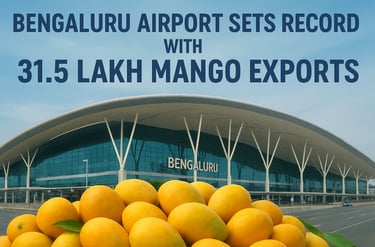

US Tariffs Push India and China Toward Strategic Trade Talks on Critical Supplies
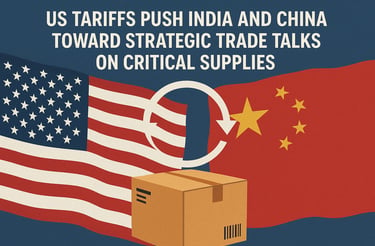

Amid mounting U.S. tariffs, India and China are nearing trade negotiations focused on essential goods such as rare earth magnets, fertilizers, and pharmaceuticals. The discussions are expected to begin soon, potentially around the upcoming Shanghai Cooperation Organization (SCO) summit where Prime Minister Modi will be present, indicating a possible thaw in bilateral ties .
These talks reflect a strategic shift as both nations attempt to shield themselves from economic pressures caused by Washington’s aggressive trade stance. India’s renewed engagement with China highlights efforts to secure critical supply chains in response to tariff disruptions and geopolitical tensions.
India Strengthens Maritime Safety with DG Shipping–IG P&I Global Partnership
13-August-2025
The Directorate General of Shipping (DG Shipping) has signed an MoU with the International Group of P&I Clubs (IG P&I) to boost maritime safety, security, and global cooperation. The agreement was exchanged at the conference “Jalasya Rakṣā, Janasya Surakṣā: Ocean Sentinel — Maritime Safety & Security in the 21st Century” and also marked the start of DG Shipping’s 75-year celebrations, honoring its long-standing role in shaping India’s maritime sector.
IG P&I, representing 12 member clubs that provide liability cover for nearly 90% of the world’s ocean-going tonnage, will bring global expertise in risk management, safety, and crew welfare. The partnership will focus on knowledge sharing, capacity building, incident prevention, and addressing modern challenges such as cyber threats, environmental protection, and evolving safety regulations.
The event brought together maritime leaders, policymakers, and industry experts to discuss the future of maritime safety, security, and sustainability, reinforcing India’s vision of becoming a secure, sustainable, and innovation-driven maritime hub.
Lok Sabha Passes Indian Ports Bill, 2025 to Boost Port Development
The Lok Sabha has passed the Indian Ports Bill, 2025, to unify port laws, promote integrated development, and improve ease of doing business. Passed by voice vote amid Opposition protests, the Bill aims to optimise India’s coastline and enhance efficiency.
It proposes State Maritime Boards for non-major ports and a Maritime State Development Council for sector-wide growth. Key provisions cover pollution control, disaster management, navigation safety, port security, and digital data management.
The law also ensures international compliance, mandates port conservation, and introduces mechanisms for dispute resolution—strengthening governance and supporting sustainable growth in India’s maritime sector.
US Rejects IMO Net-Zero Shipping Plan, Warns of Retaliation
The United States has rejected the International Maritime Organization’s (IMO) proposal to cut global shipping emissions to net zero, warning of possible retaliation against supporting nations. The “Net-Zero Framework” will face a decisive UN shipping agency vote in October, requiring a two-thirds majority from 108 ratifying members.
US officials argue the plan would raise costs for citizens, energy providers, shipping companies, and tourists. Washington, which withdrew from negotiations in April, is seeking allies to block the proposal and protect American interests.
The framework, backed by 63 nations including China, Brazil, and EU states, aims to curb the shipping sector’s 3% share of global CO₂ emissions through measures like carbon levies on fossil fuels. Many major shipping firms support the goal but seek incentives to manage green fuel costs.
While opposing binding climate measures in shipping, the US is also engaged in UN talks on a global plastic pollution treaty but resists caps on waste and bans on certain chemicals.



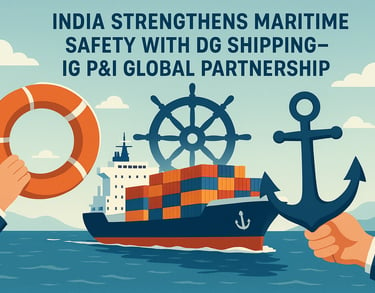




12-August-2025 Author:Nikita Sainani
Gangavaram Port Achieves Milestone with Berthing of 18.2m Deep-Draft Vessel
Adani Gangavaram Port Limited (AGPL) has set a new operational record by berthing its deepest-drafted vessel to date—a bauxite carrier for Vedanta Limited with an 18.2-metre draft, surpassing the previous 18.12-metre record. The vessel carried 177,121 MT of bauxite and completed cargo operations efficiently before sailing out. This achievement showcases AGPL’s advanced marine infrastructure, precise navigation, and coordinated teamwork, enabling it to handle high-volume, complex cargo. Strategically located in Visakhapatnam, the port serves mineral-rich regions in Andhra Pradesh, Chhattisgarh, and Odisha, supporting larger vessels that improve supply chain efficiency, reduce costs, and boost India’s trade competitiveness.
India Expands Ban on Jute Imports from Bangladesh via land routes amid tensions
India has expanded its ban on jute imports from Bangladesh via all land routes, adding bleached/unbleached woven jute fabrics, jute twine/rope, and jute sacks/bags to the prohibited list. Imports remain allowed through Nhava Sheva seaport, as per the DGFT. Similar restrictions were imposed in April, May, and June 2025 on various jute, textile, and other goods, alongside the withdrawal of Bangladesh’s transshipment facility (except for Nepal and Bhutan). The measures follow strained ties after controversial remarks by Bangladesh’s interim leader Muhammad Yunus and rising attacks on minorities. Bangladesh is a big competitor of India in the textile sector. The India-Bangladesh trade stood at USD 12.9 billion in 2023-24. In 2024-25, India's exports stood at USD 11.46 billion, while imports were USD 2 billion.
11-August-2025
U.S. and China Near Trade Deal as August 12 Tariff Deadline Looms
Trump said the U.S. and China are close to finalizing a trade deal, and he may meet President Xi before the end of the year if it happens. Treasury Secretary Scott Bessent noted progress after recent talks in Stockholm. China has until August 12 to secure a lasting tariff agreement, following earlier preliminary deals in May and June aimed at halting escalating tariffs and a rare earth minerals cutoff.
Parliament Clears Merchant Shipping Bill, 2025 Amid Opposition Protests
On August 11, 2025, Parliament approved the Merchant Shipping Bill, 2025, after the Rajya Sabha passed it by voice vote, following Lok Sabha’s approval on August 6. The bill expands eligibility for owning merchant vessels and provides for investigations into marine casualties. The passage occurred amid Opposition protests and a brief adjournment, with members demanding discussion on Bihar’s electoral roll revision.
